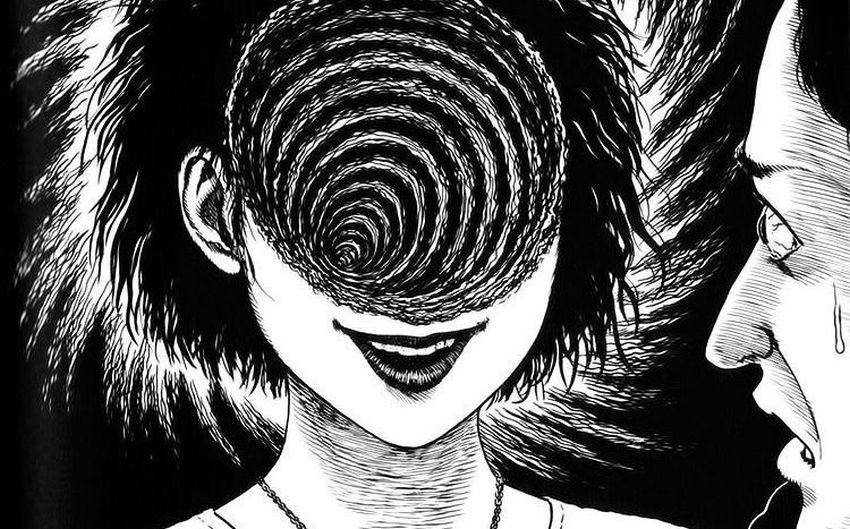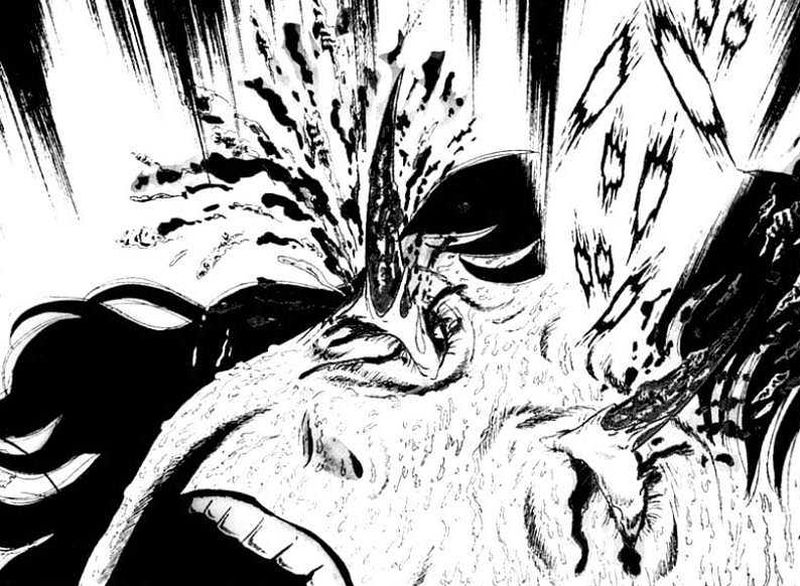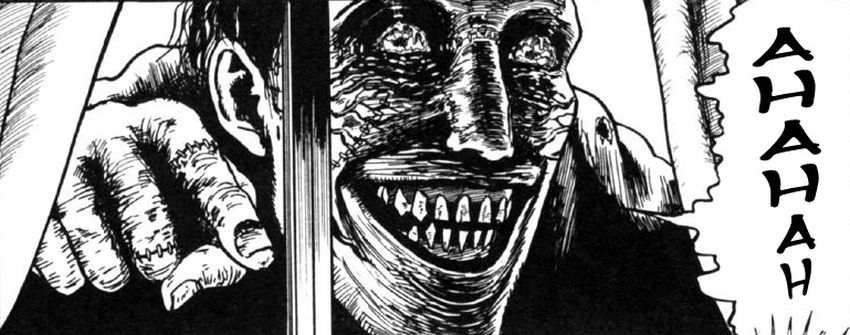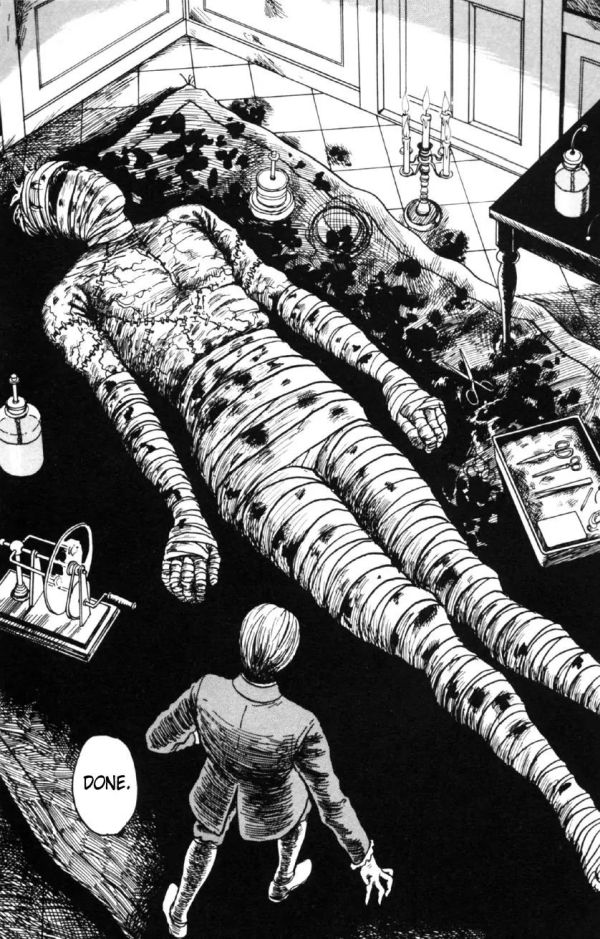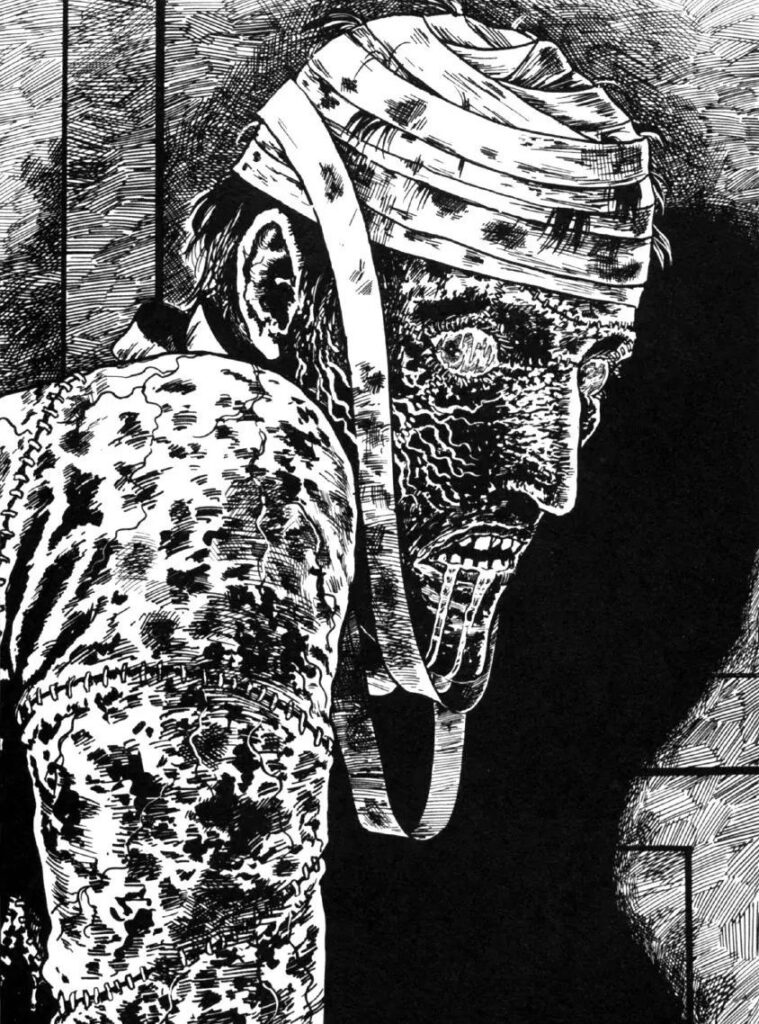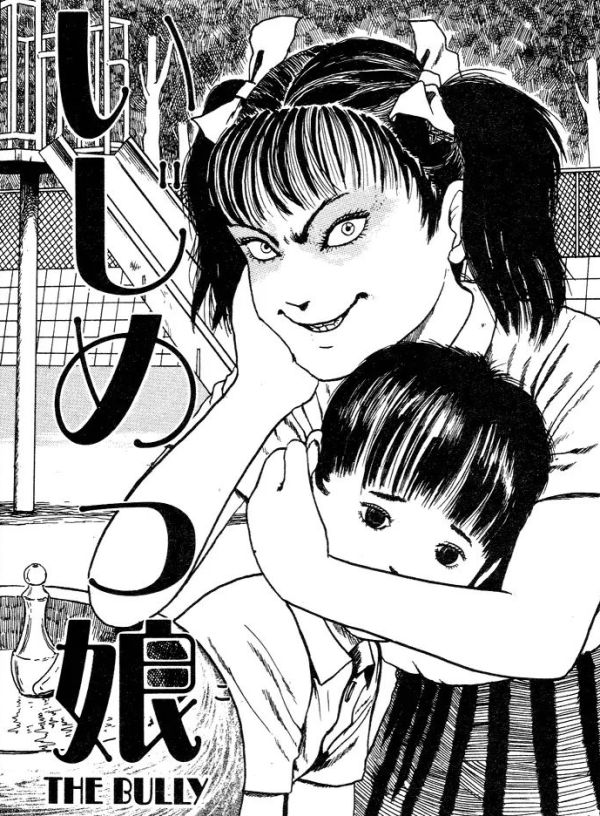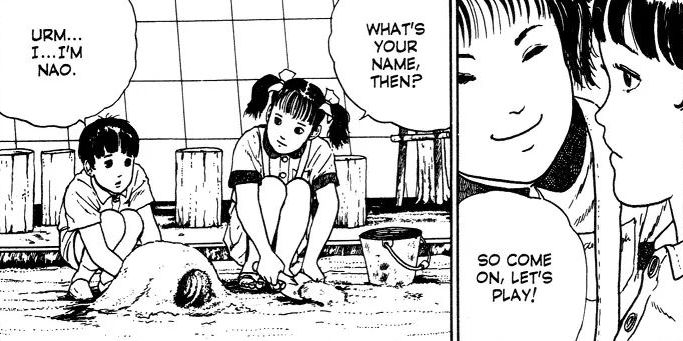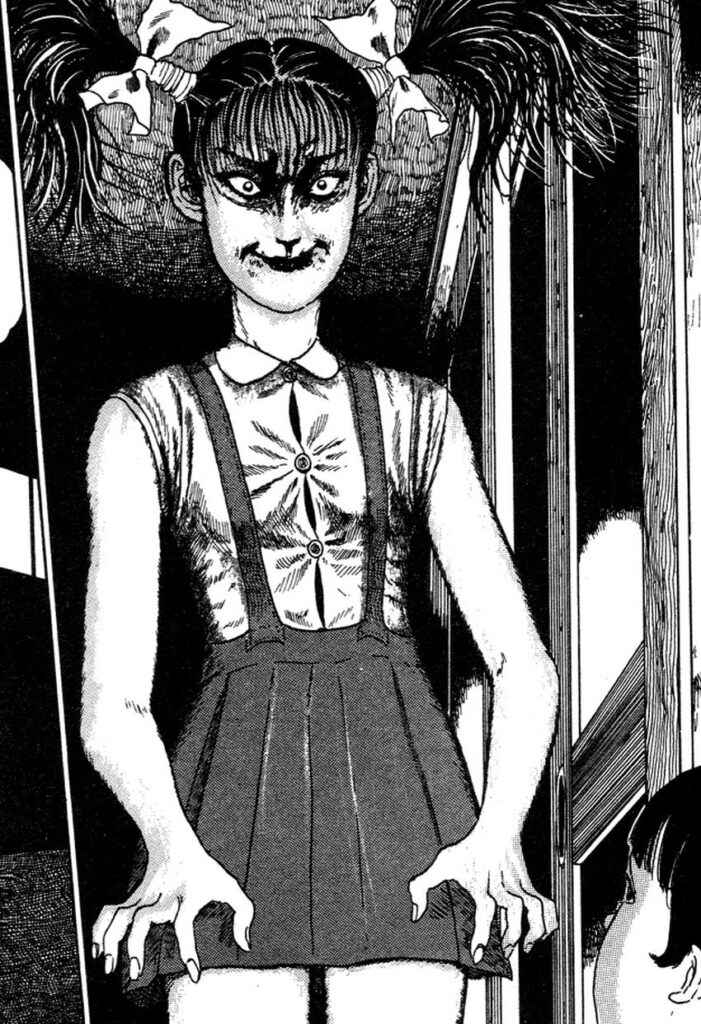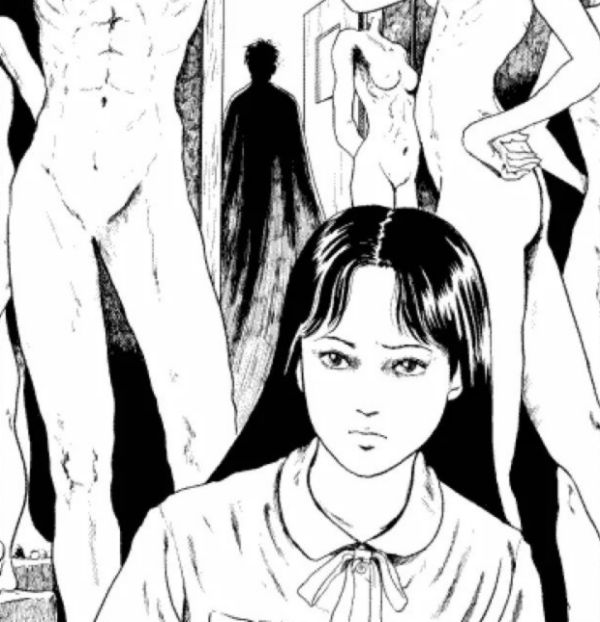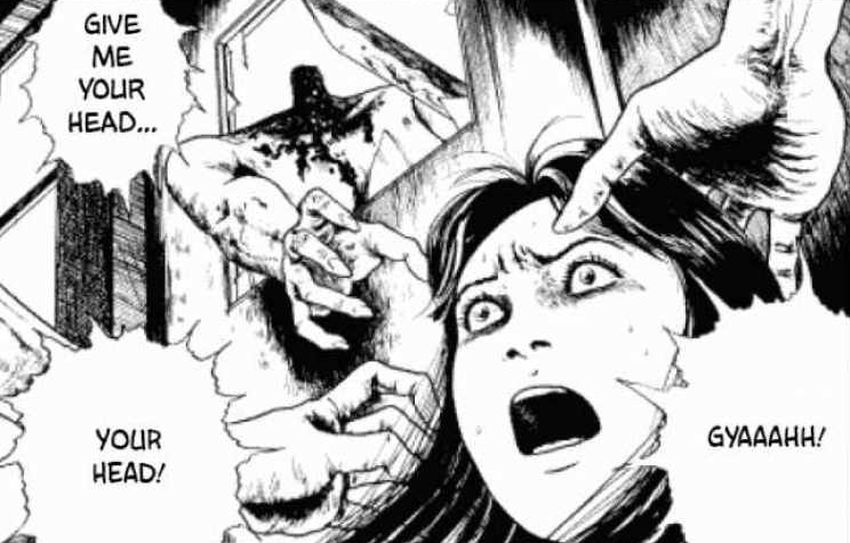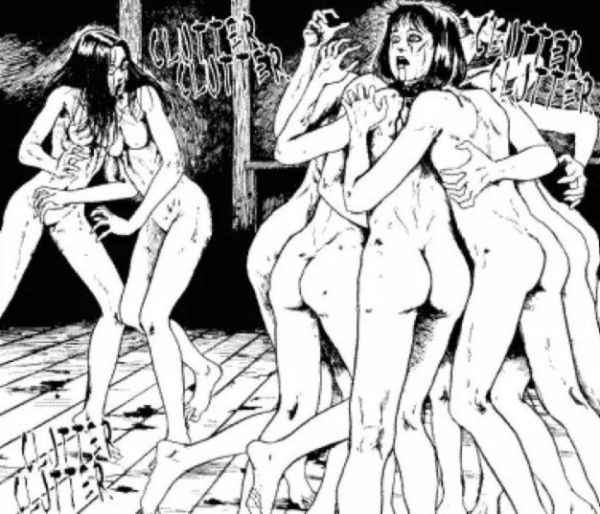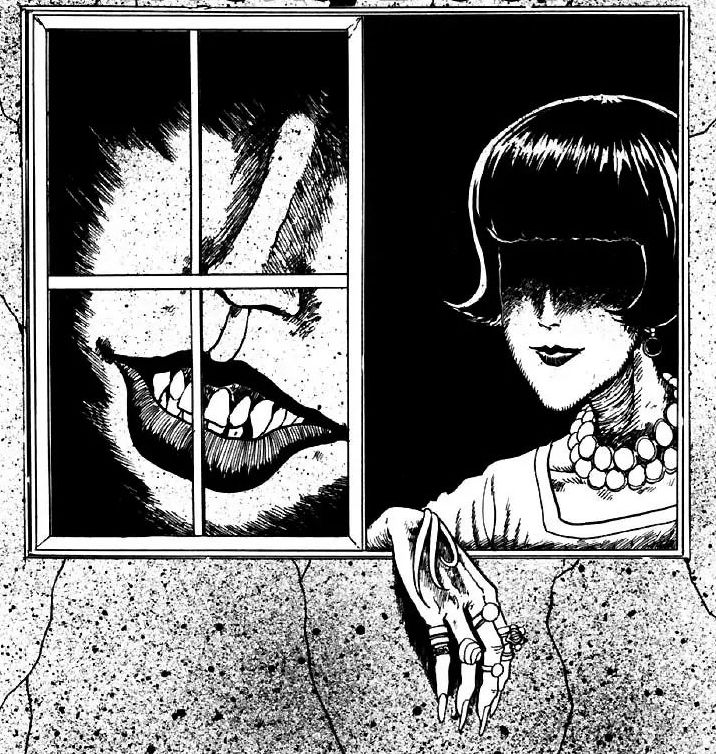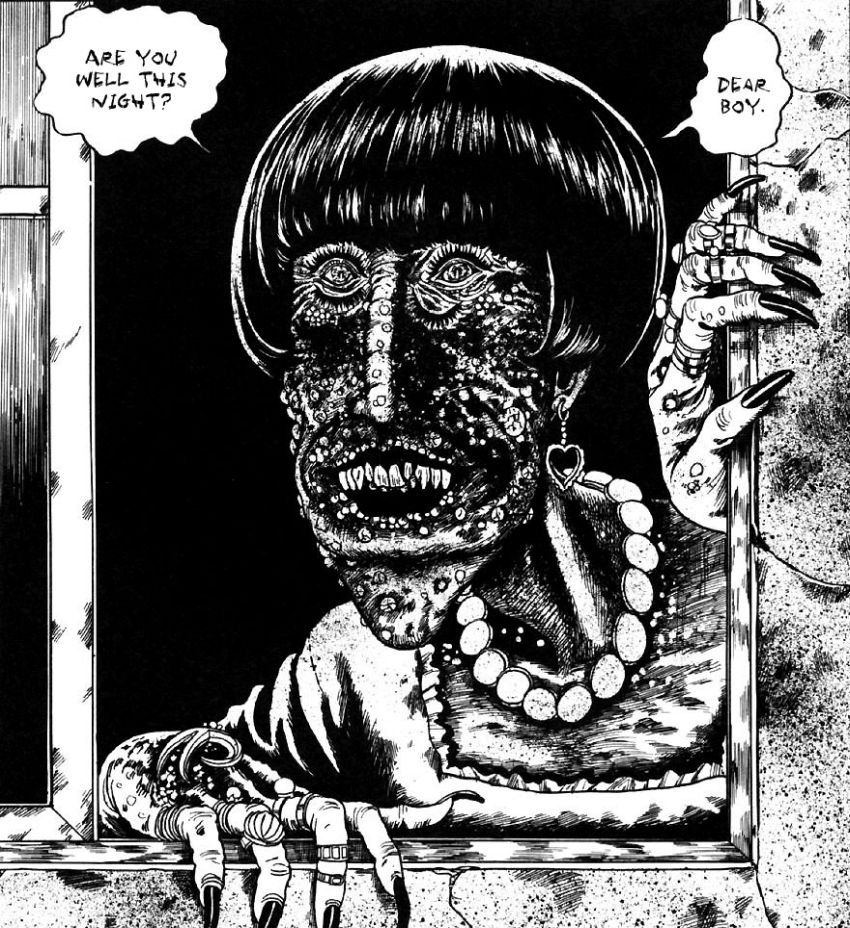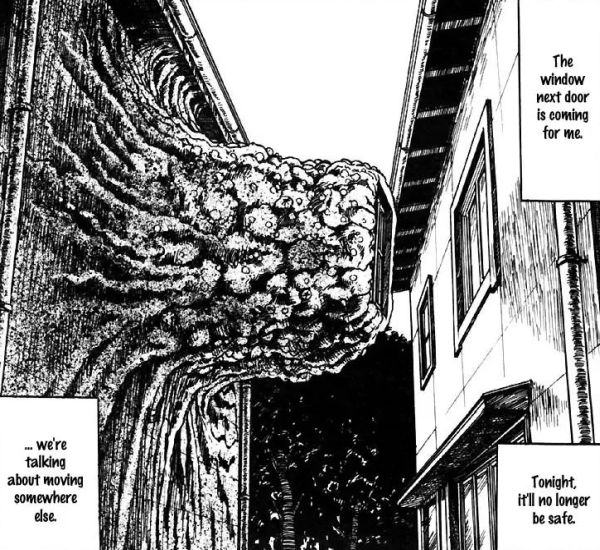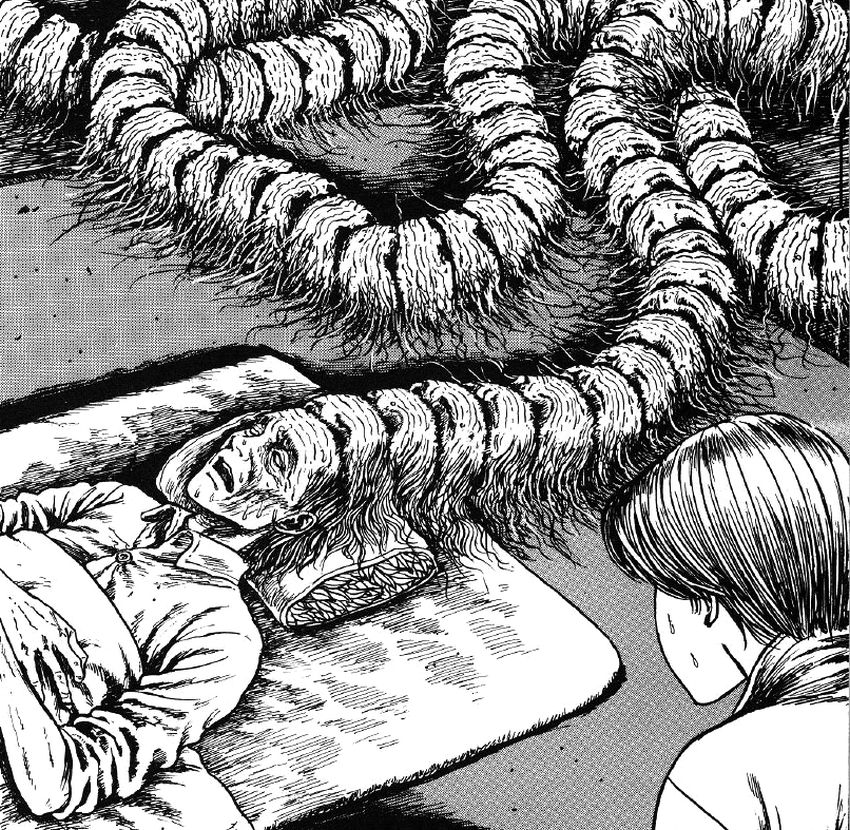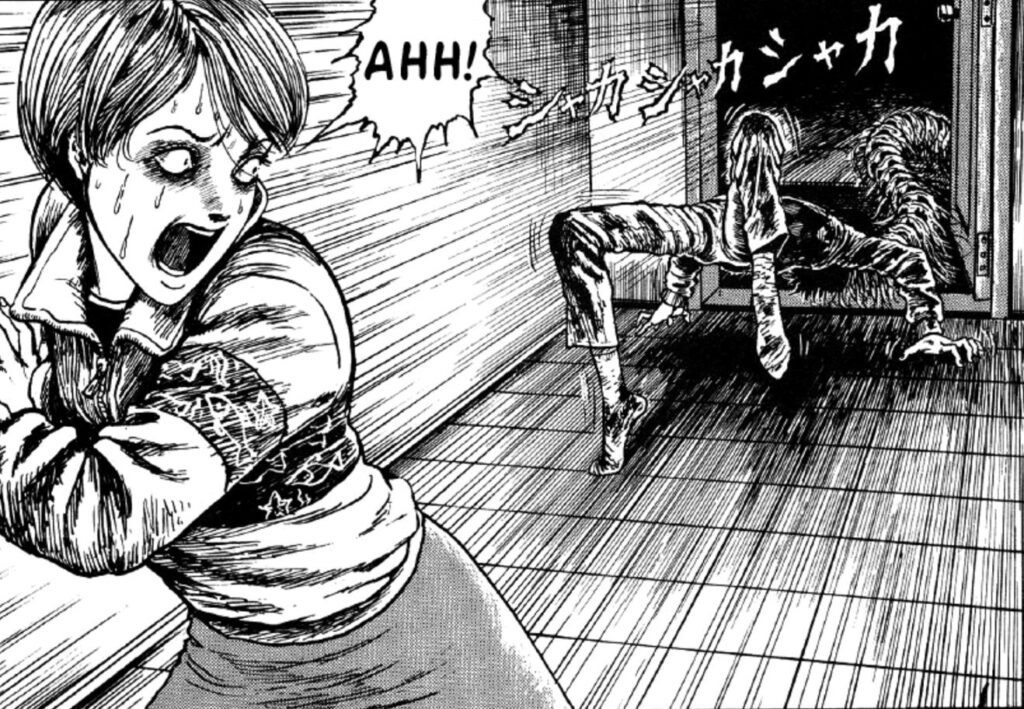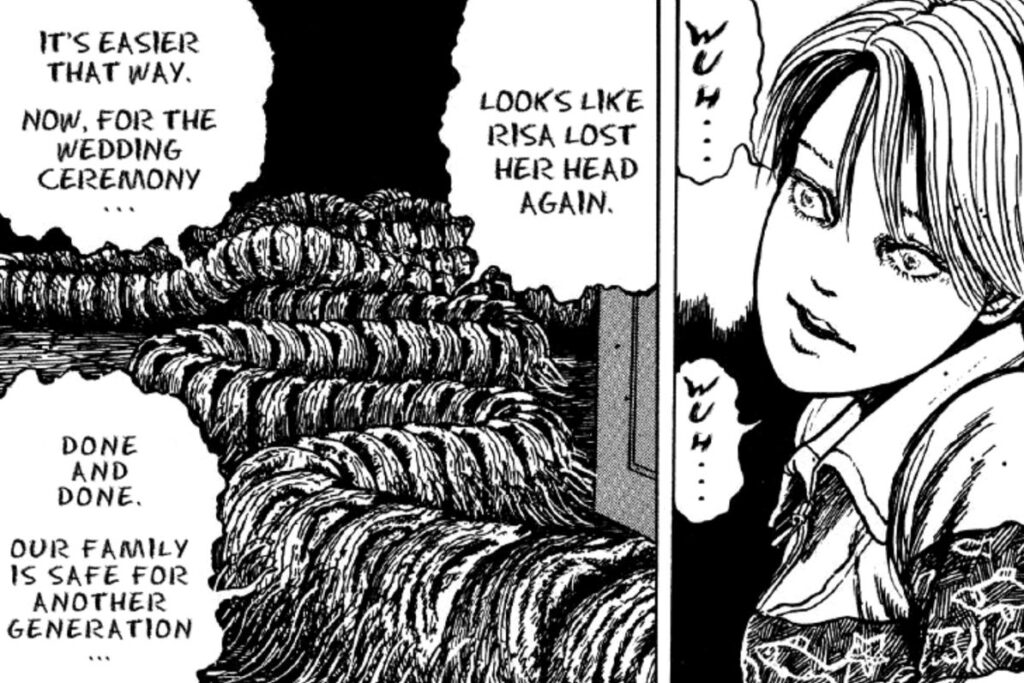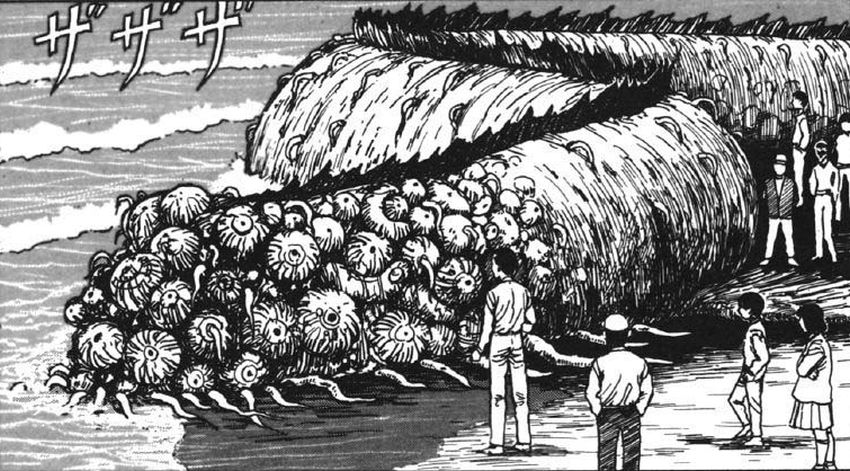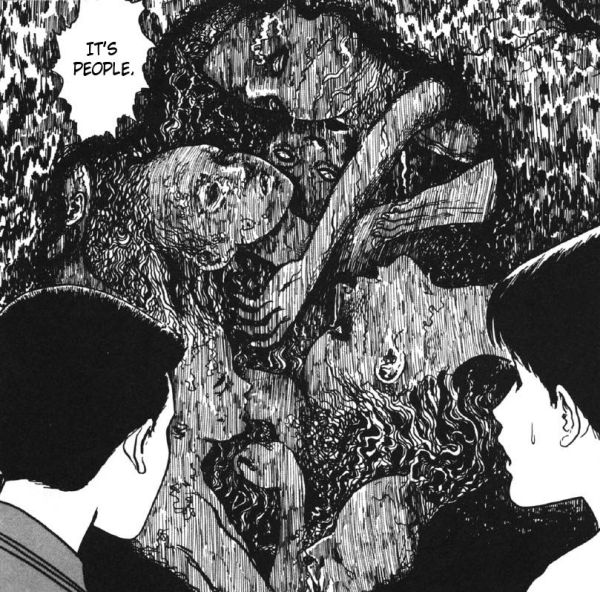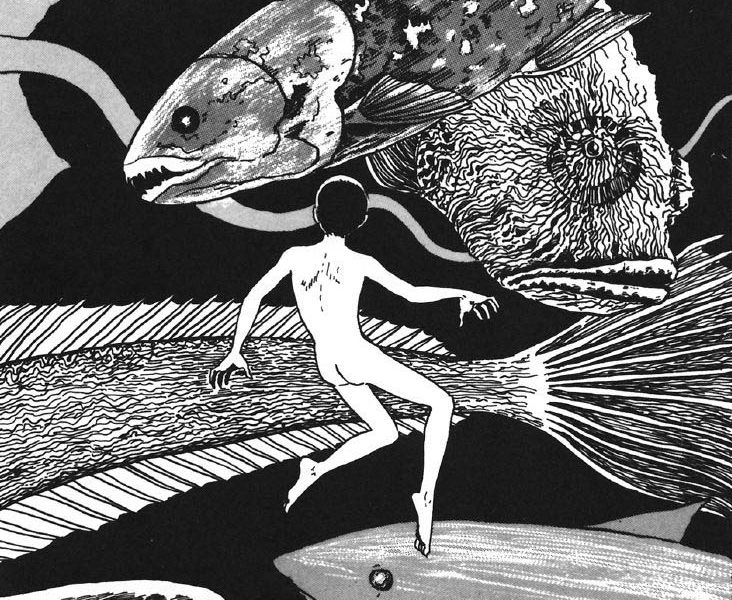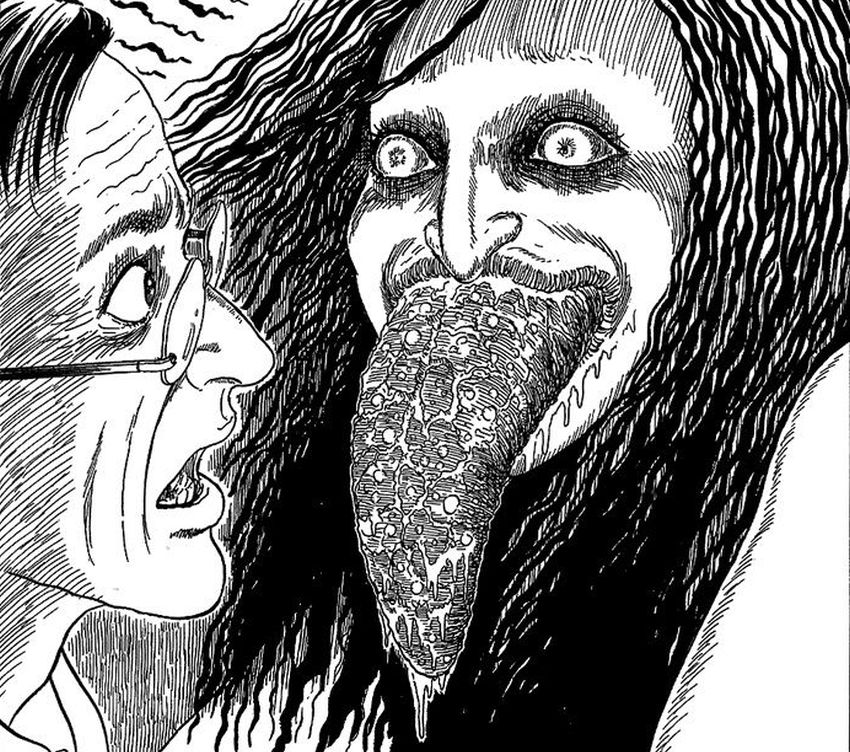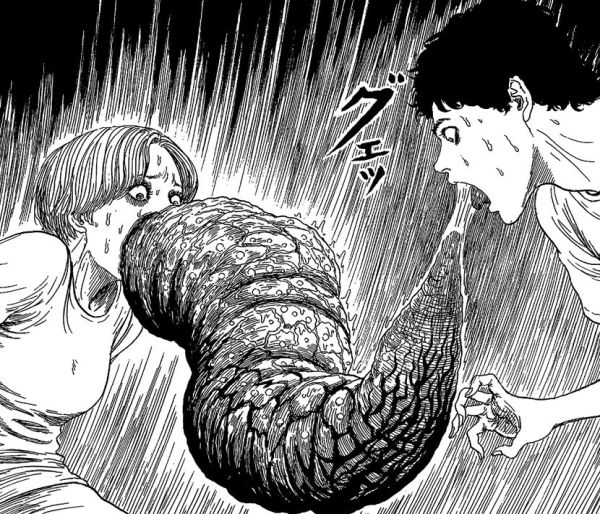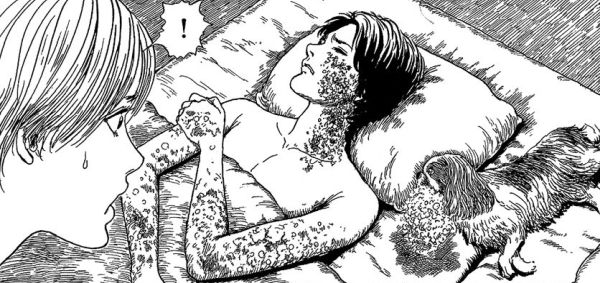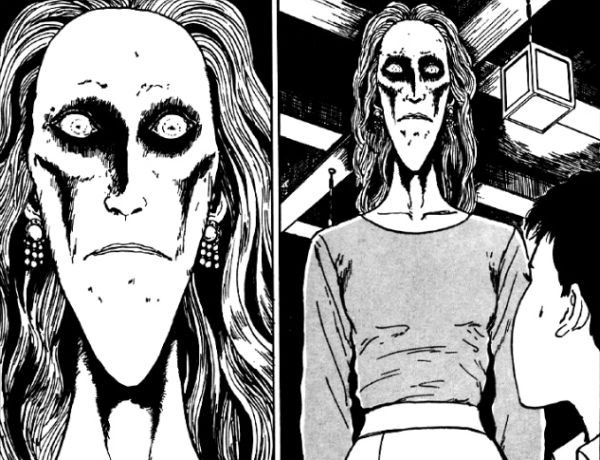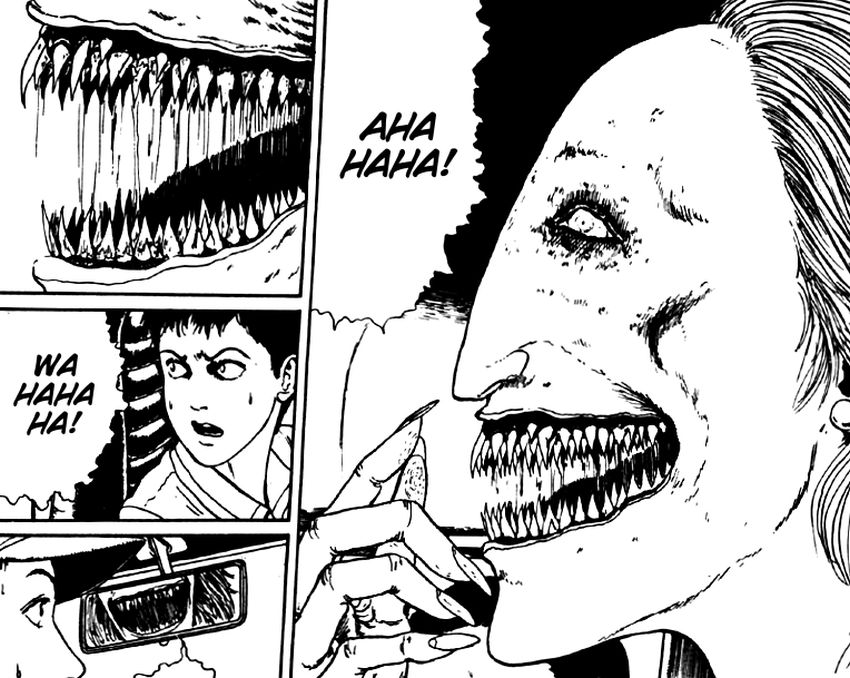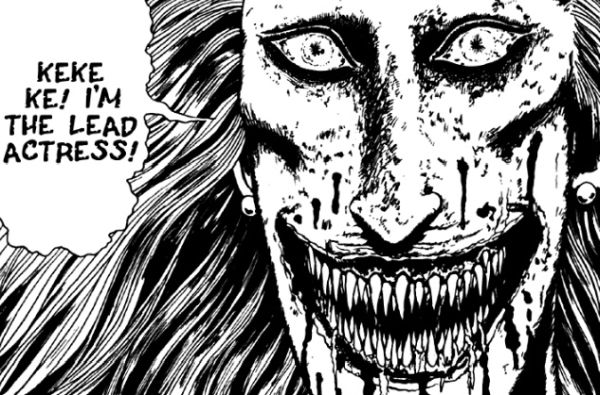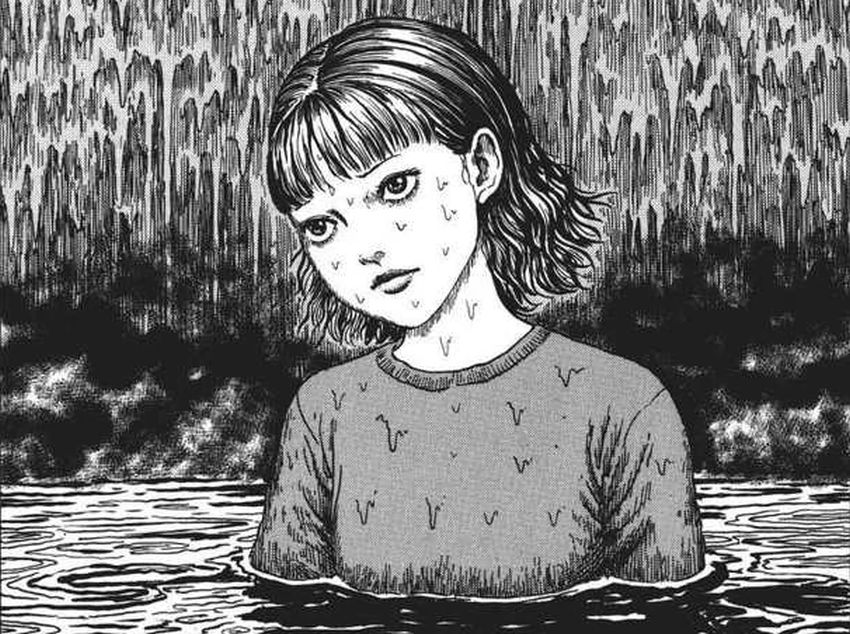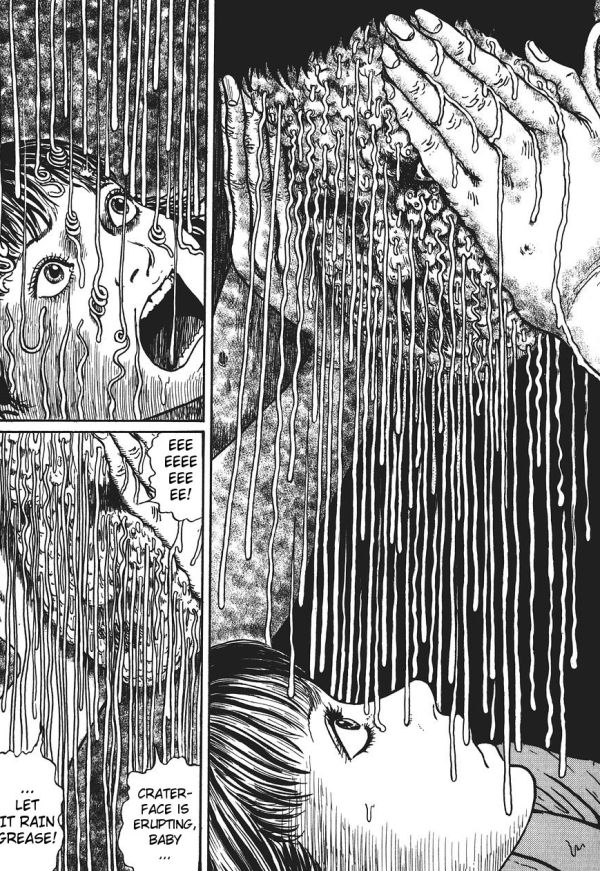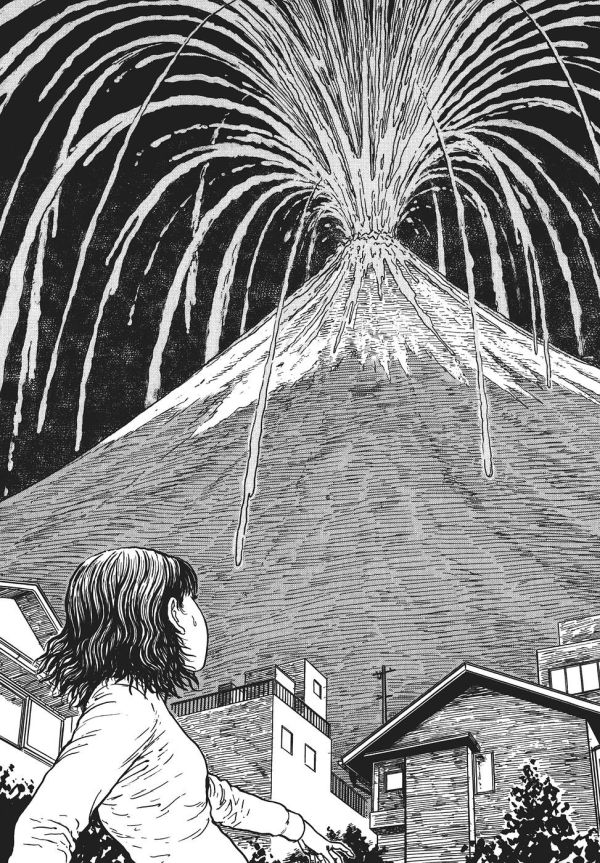As a horror writer, I’ve always been obsessed with the horror genre in all its forms. I devoured unsettling stories, disturbing movies and eerie folk tales. Few, however, capture horror quite like manga.
Horror manga blend stunning visual storytelling with psychological depth, surreal imagination, and a deep cultural connection firmly grounded in the supernatural. It’s a medium in which everything can happen. Grotesque ideas meet beautiful art, creating an entirely unique way to showcase horror.
Over the years, I’ve read hundreds upon hundreds of horror manga. Some are famous classics; others are hidden gems I discovered in the medium’s weirder corners.
This list serves as a testament to my dedication to the horror manga genre, and collects my personal favorites. You’ll find the most terrifying, most original, and most unforgettable horror manga I’ve ever encountered.
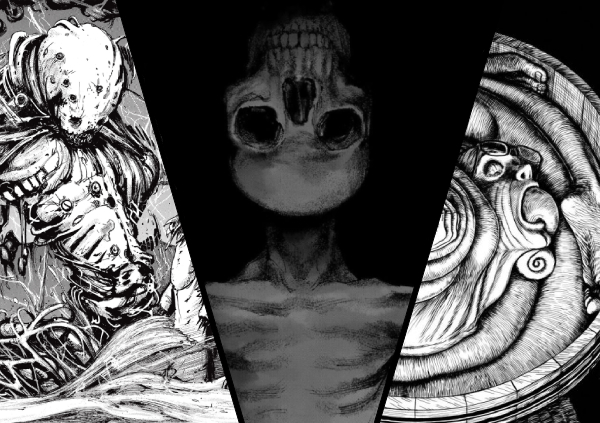
So if you’re looking for the best horror manga, from disturbing to deranged and outright bizarre, you’re in the right place.
On a quick note: horror is a broad term. On this list, you’ll find slow-burn thrillers, grotesque pieces of body horror, surreal mysteries, action-packed survival nightmares, and even horror-comedy hybrids. Some series might be pure horror, while others lean more into tragedy, sci-fi, crime, or even fantasy. So I’m sure there’s something for every horror fan out there.
Many of the horror manga on this list are completed; others are still ongoing. All of them, though, showcase horror at its most unforgettable.
Mild spoiler warning. I try to keep things vague, but sometimes it’s unavoidable.
So here’s my definite list of the 50 best horror manga anyone should read (last updated: July 2025).
50. Tonari no Jii-san
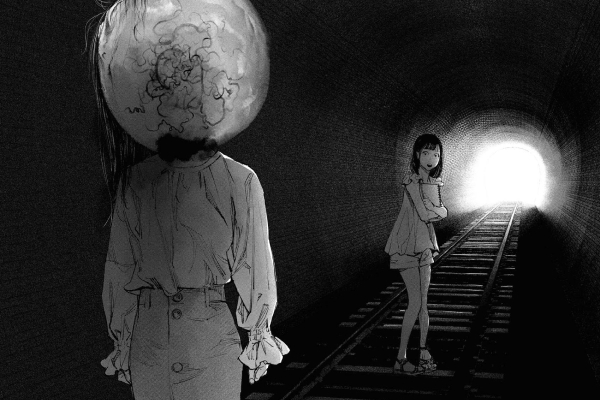
Sometimes horror isn’t about gore or graphic violence. Instead, it’s about the feeling that something is deeply wrong. That’s the kind and quiet, creeping dread at the heart of Tonari no Jii-san.
Written by Koike Nokuta, this haunting horror manga follows Yuki, a quiet girl living in a rural town who dreams of becoming a painter. When her older sister leaves the town behind, Yuki rides the train with her to see her off. While there, she witnesses something that shakes her sense of reality forever. And yet, no one cares, and even worse, no one seem to notice anything is wrong. Was it all just a hallucination? Is she going insane? Or was it actually… real?
As the manga continues, Yuki tries to find out the truth, and soon realizes she’s not the only one who can see the town’s true nature. What begins as personal paranoia gradually turns into a larger mystery that blends body horror with strange local folklore.
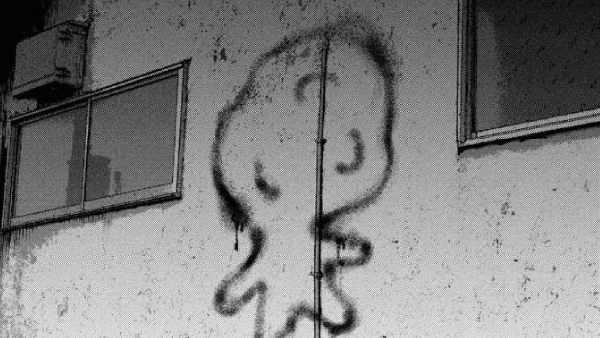
The art in Tonari no Jii-san is stunning. It comprises fine textures, shadowy tones, and surreal designs to bring its most outlandish scenes to life. The first chapter alone is one of the strongest openings in recent horror manga.
Though still in its early run, Tonari no Jii-san is already shaping up to be a modern classic. It’s a chilling, slow-burn mystery that captures the dread of being the only one who sees the cracks in reality, and the fear that the truth might be worse than madness.
Genres: Horror, Drama, Mystery, Psychological, Tragedy
Status: Ongoing (Seinen)
49. The Kurosagi Corpse Delivery Service
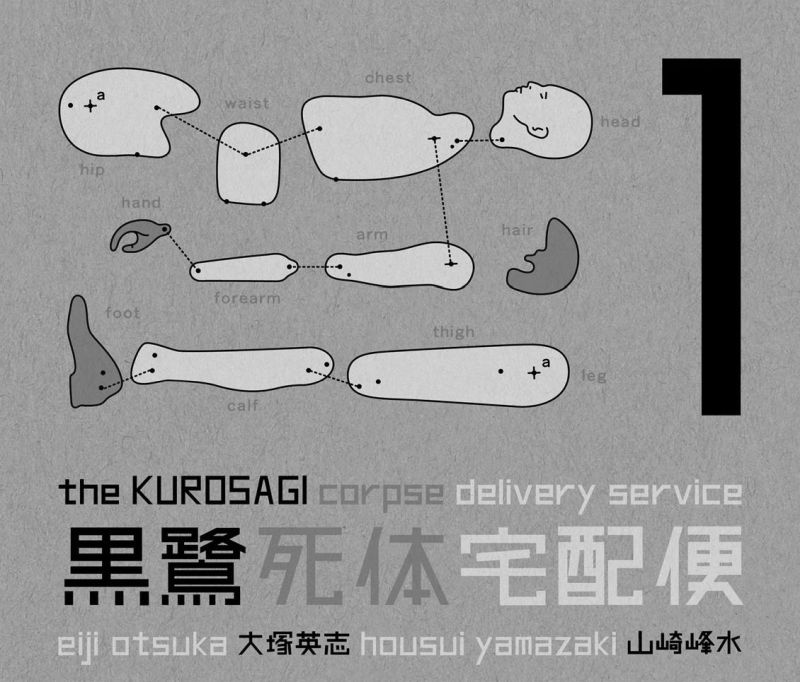
The Kurosagi Corpse Delivery Service is one of the most underrated horror manga of its kind. Written by Eiji Otsuka and illustrated by Housui Yamazaki, this quirky series follows five Buddhist university students who run a very unusual business: fulfilling the final wishes of the dead.
Each member of the team has a supernatural gift. Most notably, Kuro Karatsu, who can communicate with the dead, an ability that lets the group uncover how a person died and what they need to move on. The result is a horror-mystery blend where each case brings a new death to solve, often revealing crimes, conspiracies, or unresolved trauma.
While the series deals with dark and unsettling subject matter, it’s surprisingly light in tone. The characters are quirky; the dialogue is witty, and the black comedy is sharp.
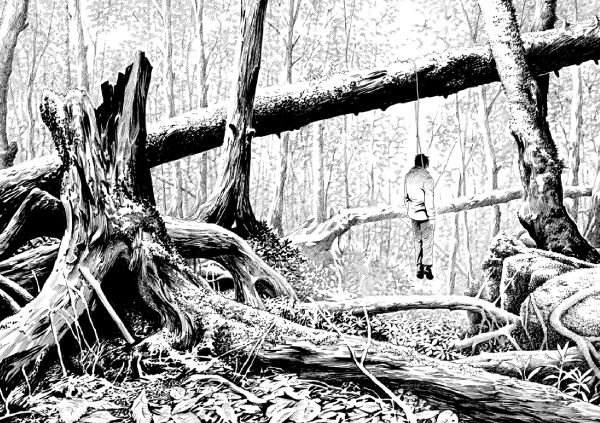
Even though the manga follows a mostly episodic structure, with each chapter centering on a new body, the storytelling remains fresh thanks to the wide variety of cases and strong character dynamics.
It’s not the most terrifying manga on the list, but its creativity, atmosphere, and unique ability to balance death, humor, and mystery make it a cult classic worth reading. Especially for fans of episodic horror and mystery with a supernatural twist.
Genres: Horror, Drama, Comedy, Mystery, Supernatural
Status: Ongoing (Seinen)
48. Domu: A Child’s Dream
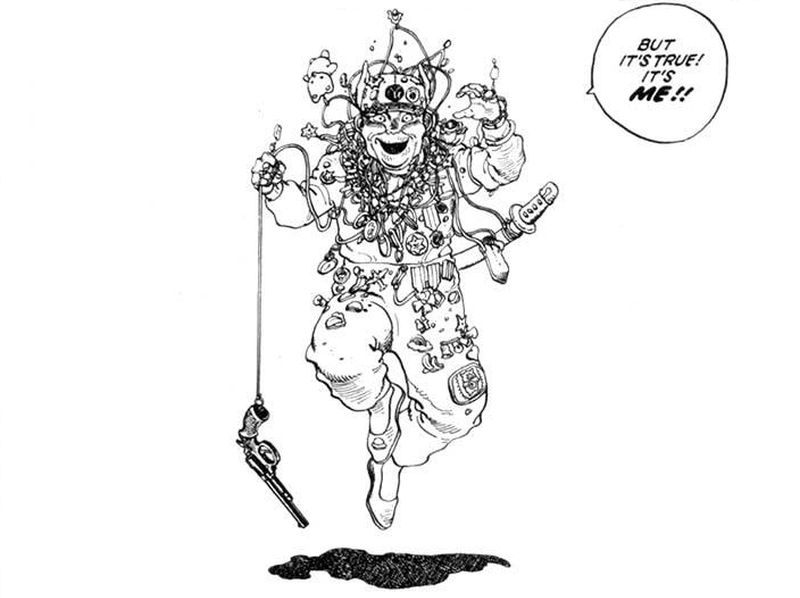
Domu: A Child’s Dream is a short but striking horror manga by Katsuhiro Otomo, best known as the creator of Akira. Though lesser known, Domu is a powerful, self-contained story that blends supernatural horror with psychological suspense, showcasing Otomo’s signature artistic talent on full display.
The story takes place in a massive apartment complex where a string of unexplained suicides and violent deaths have left investigators baffled. As the mystery deepens, the truth is revealed: an old senile man with psychic powers holds sway over the complex, manipulating and killing its residents for his own twisted amusement.

Yet when a young girl with powerful psychic abilities of her own moves in, a deadly confrontation begins. What follows is a psychic duel that tears through the concrete maze of the apartment complex with eerie, unforgettable intensity.
Domu’s often overshadowed by Akira, but it’s an essential read in its own right. With stunning paneling, cinematic tension, and a grounded urban setting, it’s a perfect one-volume horror manga that delivers in both story and spectacle.
Genres: Horror, Drama, Psychological, Slice of Life, Classic
Status: Finished (Seinen)
47. Devilman
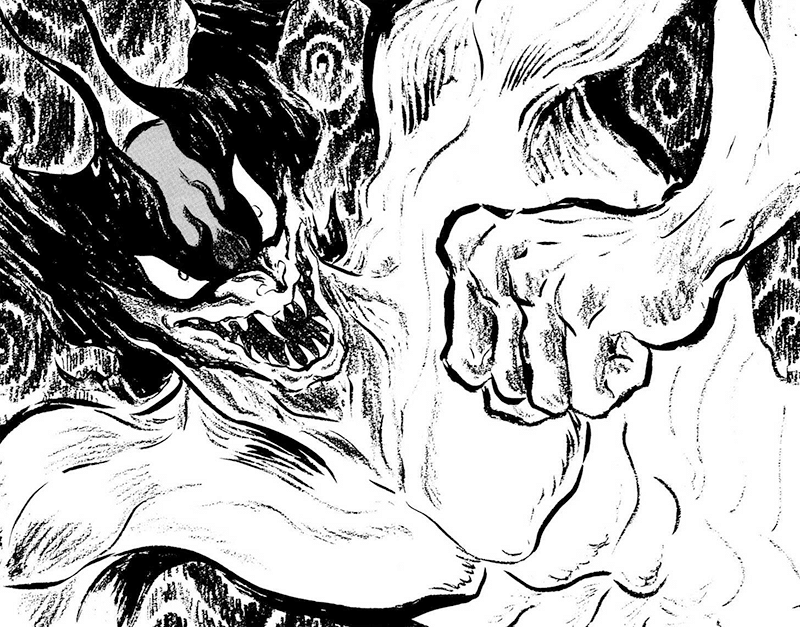
Devilman is a cult classic horror manga from the 1970s by Go Nagai, and one of the earliest titles to push the genre into darker, more transgressive territory. Though rough around the edges, it’s a foundational work that still resonates today, especially after its modern reimagining in Devilman Crybaby.
The story follows Akira Fudo, a timid teenager who fuses with the powerful demon Amon during a horrific ritual. This transformation gives him the strength to fight other demons secretly infiltrating society. Yet as the story unfolds, Devilman shifts its focus, exploring how humans, too, are capable of cruelty and evil.
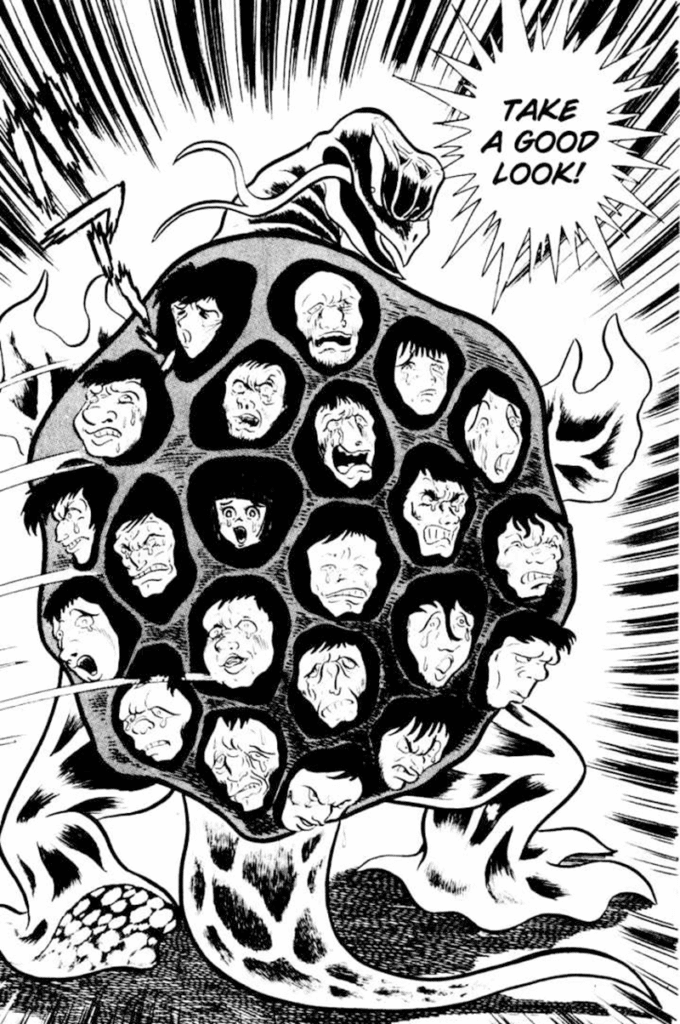
Make no mistake: Devilman is a chaotic manga. Its tone swings wildly, the pacing lurches, and its art, while expressive, is outdated and cartoonish by modern standards. Yet it’s a beautiful mess, one that’s raw and powerful, featuring the occasional moment of brilliance. This is especially the case in its fantastic final chapter, which delivers one of the most unforgettable endings in manga history.
Devilman isn’t a masterpiece in terms of structure or character, but its ambition, shock value and apocalyptic themes helped shape the landscape of horror manga. If you’re interested in the genre’s history, or enjoy experimental, surreal, and morally bleak narratives, it’s absolutely worth reading.
Genres: Horror, Action, Sci-Fi, Tragedy, Classic
Status: Finished (Shonen)
46. Hideout
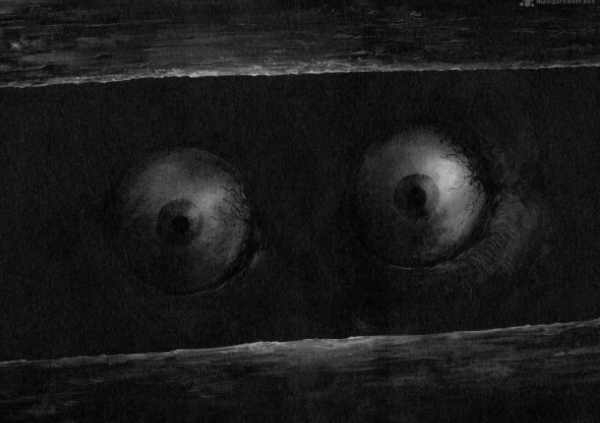
Hideout is a short, brutal descent into madness, grief, and revenge. Written and illustrated by Masasumi Kakizaki, this nine-chapter horror manga is both visually stunning and emotionally suffocating. It’s a pure psychological nightmare.
The story follows Seiichi Kirishima, a failed writer who travels to a remote island with his wife under the pretense of mending their relationship after losing their son. Yet Seiichi has a darker purpose in mind: he intends to kill her. When his plan fails and she escapes into the island’s jungle, the chase leads them into a hidden cave. But they soon learn, they’re not alone.
Told through a mix of real-time horror and grim flashbacks, Hideout unravels the tragedy behind Seiichi’s descent, revealing a man consumed by failure, guilt, and resentment. It’s a bleak, downward spiral with no happy ending in sight.
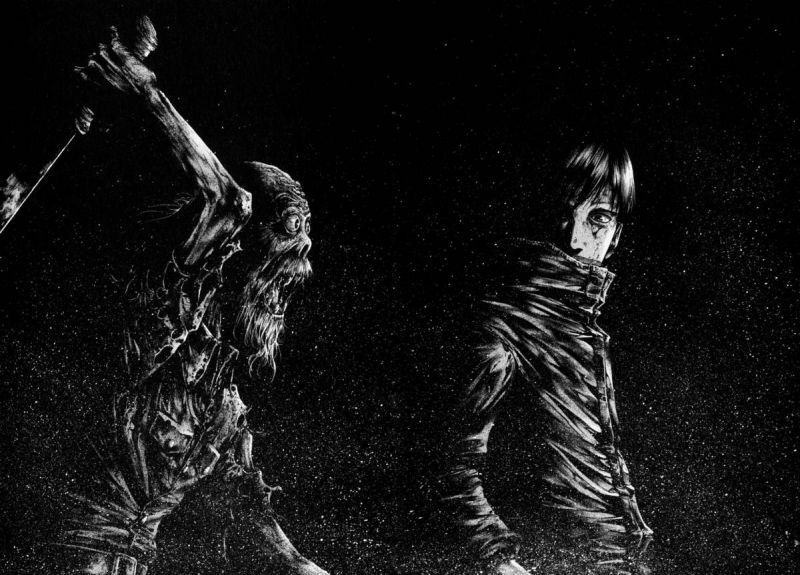
The manga’s art is breathtaking. Heavy shadows, oppressive blacks, and detailed line work make every page drip with atmosphere and heighten the manga’s already claustrophobic feeling.
Though short, Hideout leaves a lasting impact. It’s a lean, vicious story with zero filler and an unrelenting sense of dread. It’s a must-read for fans of psychological horror, survival horror, or simply great art.
Genres: Horror, Psychological
Status: Finished (Seinen)
45. Zashiki Onna
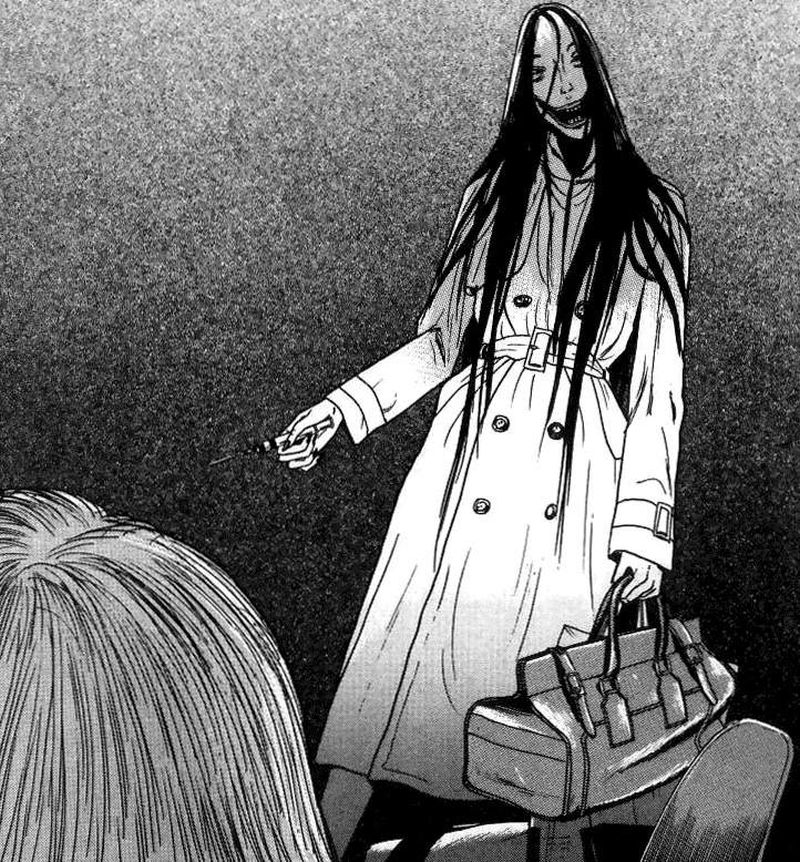
Zashiki Onna is one of the earliest horror manga to explore stalking in a grounded, realistic way, and laid the foundation for the stalker horror subgenre that followed. First published in the early 1990s, this short but deeply unsettling story proves you don’t need supernatural monsters to terrify.
The manga follows Hiroshi, a university student whose ordinary life begins to unravel after he encounters a strange, tall woman lingering outside his neighbor’s door. After a brief exchange, her attention shifts to him. At first, it’s unnerving, then it becomes invasive, and soon, dangerous.
What makes Zashiki Onna so effective is its eerie plausibility. The woman isn’t a ghost or a demon, just an unexplainable, relentless presence that slowly dismantles Hiroshi’s sense of safety. The horror lies in how real it feels.
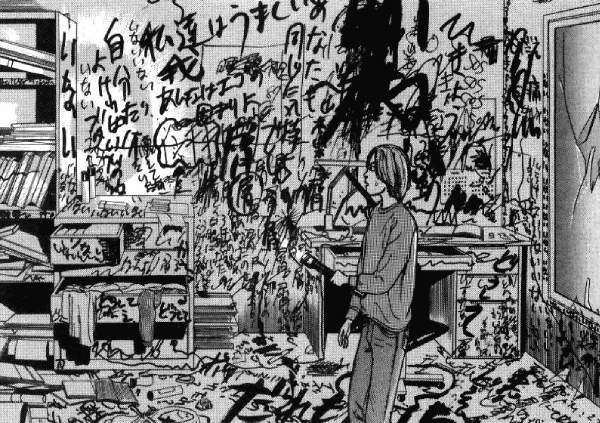
Clocking in at only eleven chapters, Zashiki Onna is a tight, creeping, psychological horror manga that lingers long after its final page. It’s a haunting portrayal of obsession, helplessness, and invasion of privacy. All without ever relying on gore or the supernatural.
In a list full of monsters and the supernatural, Zashiki Onna stands out by proving that sometimes the most terrifying threats are human.
Genres: Horror, Mystery, Psychological, Thriller
Status: Finished (Seinen)
44. Another
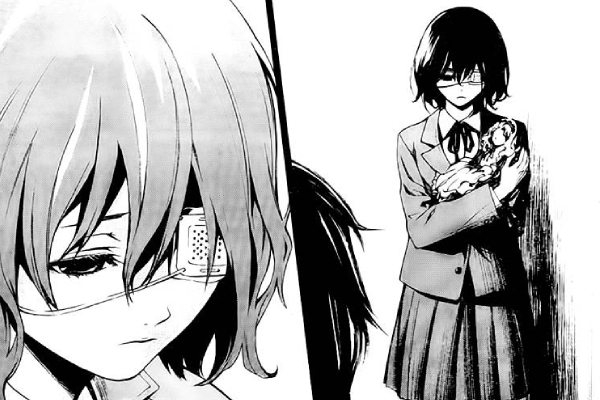
Another is a suspenseful horror mystery adapted from Yukito Ayatsuji’s novel of the same name. Set in 1998, the story follows Kouichi Sakakibara, a transfer student who joins Class 3-3 at Yomiyama North Middle School.
He soon discovers that something is deeply wrong. His classmates behave strangely, especially around Mei Misaki, a quiet girl they all pretend doesn’t exist. As Kouichi digs into the mystery, a chain of horrific, inexplicable deaths begins to claim the students one by one.
Compared to its anime counterpart, the manga adaptation offers a more grounded and coherent retelling of the story. While the deaths are still brutal, sometimes absurdly so, they’re fewer and more effectively placed, making it less of a gorefest. It also features a surprisingly emotional core, with a cast of characters that make human mistakes and struggle under pressure.
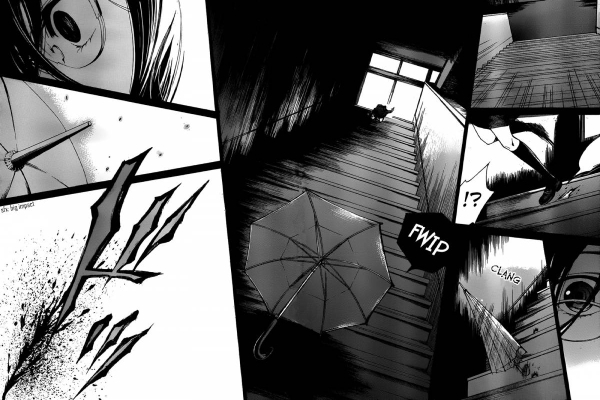
Hiro Kiyohara’s moody artwork suits the story well, particularly in its more quiet or tense moments. While some plot elements feel randomly placed or like late additions to the story, the final reveal makes up for it. It’s a genuinely surprising and tragic twist.
Though divisive, Another remains one of the most influential modern ghosts stories in horror manga. It blends small-town paranoia, curses, and a creeping sense of dread into a tight, tragic mystery. If you’re a fan of supernatural horror or Japanese ghost stories, Another is a solid choice.
Genres: Horror, Supernatural, Mystery, Tragedy
Status: Finished (Seinen)
43. Shiga Hime
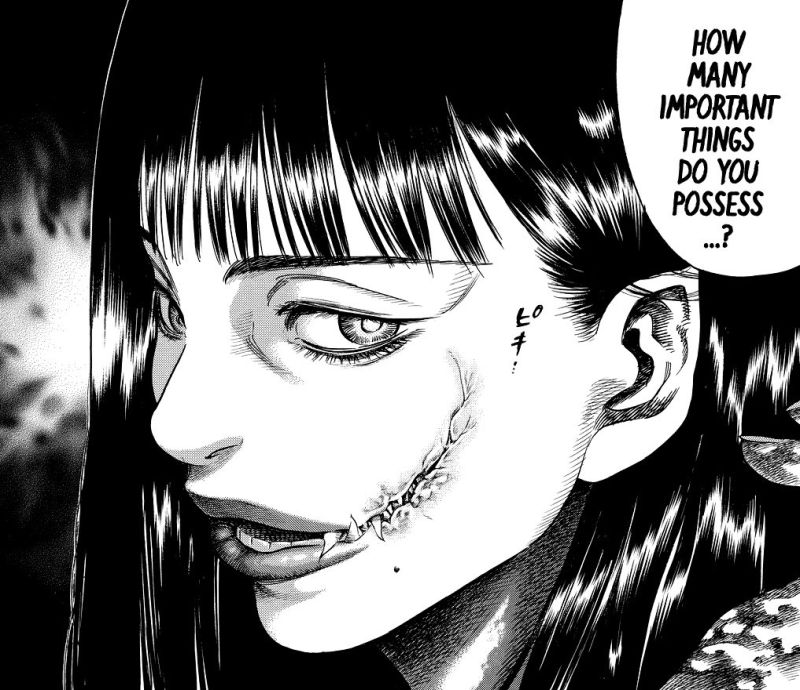
Shiga Hime is a stylish, violent, and perversely compelling vampire manga that twists classic tropes into something far more depraved, but also human. At first glance, it might seem trashy and overly sexual, but underneath this provocative nature lies a deeper and more tragic story.
The story follows Osamu Hirota, an average boy whose life spirals out of control after he’s lured to the mansion of the mysterious Miss Miwako, a beautiful vampire. After a grim encounter, Osamu finds himself transformed into a grotesque monster, forced to kill to maintain his human form. Bound to Miwako as her familiar, he’s drawn into a world of rival vampires, monstrous servants, and violent power plays.
As mentioned before, Shiga Hime is highly sexualized. Miwako uses her body to both seduce and dominate. This reliance on erotic horror imagery may turn some readers away, but those who stay will find that Shiga Hime is more than mere exploitation.
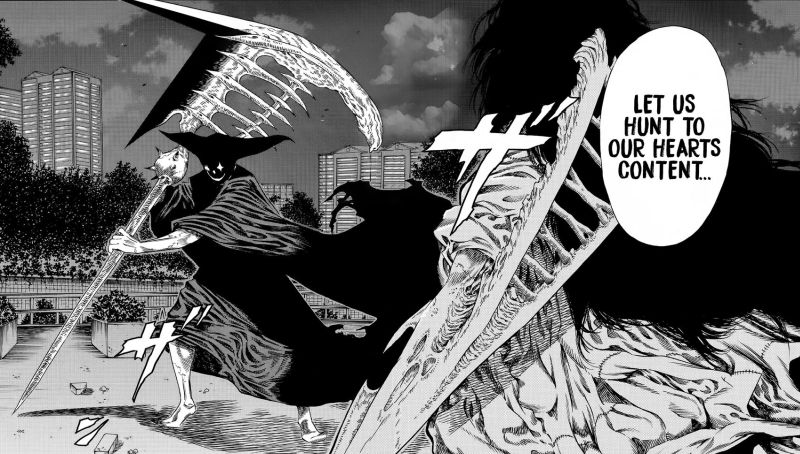
As the story progresses, this horror manga’s themes deepen. What begins as a tale of grotesque bodily transformation becomes a multi-layered exploration of desire, vanity, jealousy, and the slow decay of morality.
Sato Hirohisa’s artwork is exceptional. His distinct, evolving style blends sharp character design with elaborate creature design. Especially later battles look downright stunning, and the detailed illustrations more than elevate the story’s emotional stakes.
Though Shiga Hime starts rough, both tonally and thematically, it quickly becomes one of the more unique horror manga on this list. If you can handle its provocative edge, you’ll be rewarded with a twisted, multi-layered and tragic vampire tale.
Genres: Horror, Psychological, Supernatural, Vampire
Status: Finished (Seinen)
42. Dragon Head
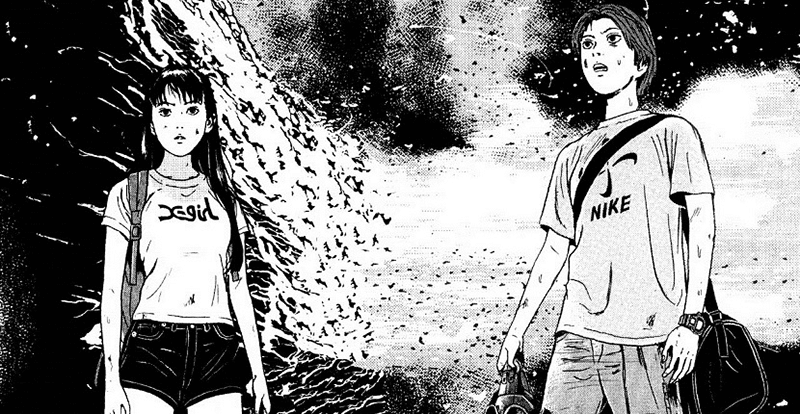
Dragon Head is a harrowing survival manga with intense psychological horror at its core. Written by Minetarou Mochizuki in the late 1990s, it begins with a terrifying train accident that leaves only three teenagers alive: Teru, Ako, and Nobuo. Trapped inside the wreckage with no light and dwindling supplies, the survivors must battle claustrophobia, despair, and the creeping threat of madness.
And that’s only the beginning.
Once they escape the tunnels, they are thrust into an apocalyptic landscape filled with destruction, paranoia and the growing signs of civilization’s collapse. Dragon Head’s horror doesn’t come from monsters, but from people breaking down, from losing hope, and from confronting the terrifying idea that the world may never make sense again.
What makes Dragon Head stand out is its realism. The characters act like real people in an extreme crisis: they panic, lash out, and desperately cling to survival. As the story unfolds, the line between sanity and delusion blurs, especially for Nobuo, whose psychological collapse is one of the most haunting parts of the manga.
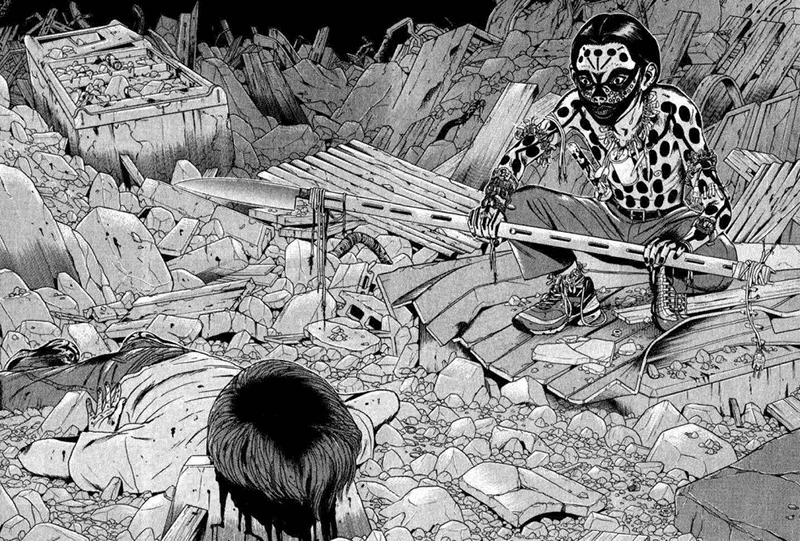
The artwork is gritty, expressive, and, at times, breathtaking. Mochizuki’s detailed backgrounds and bleak landscape lend a tangible weight to the destruction. You can almost feel the dust, the silence, the scale. It’s a masterclass in visual storytelling.
While the manga loses momentum toward the end and leaves many questions unanswered, this ambiguity may be intestinal. After all, what kind of closure is there when the world ends?
At its core, Dragon Head is a psychological survival manga. It’s exploration of fear, madness and societal breakdown, more than erns it a place amongst the best horror manga of all time. If you’re looking for grounded, tension filled horror, read Dragon Head.
Genres: Horror, Adventure, Tragedy, Psychological, Post-Apocalyptic
Status: Finished (Seinen)
41. The Laughing Vampire
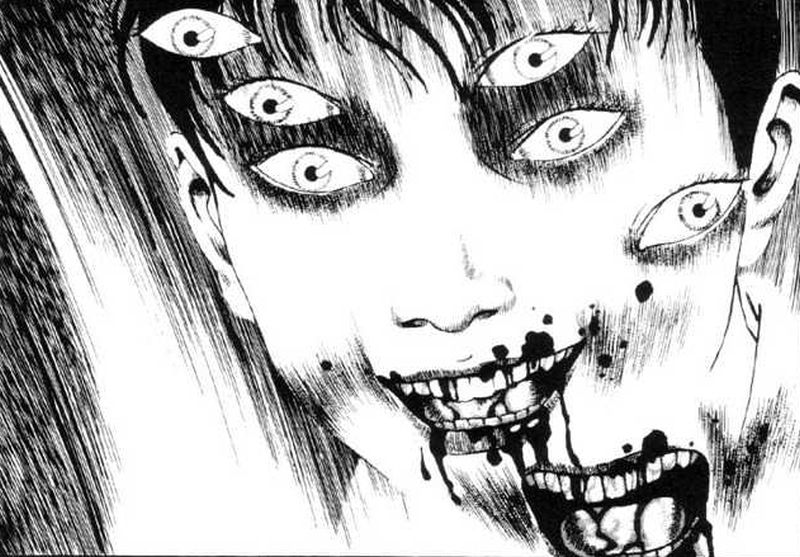
The Laughing Vampire by Suehiro Maruo is a deeply disturbing descent into the grotesque, erotic and surreal. We’re now diving into the deep end of horror manga.
Known for his ero-guro (erotic grotesque) work, Maruo is infamous for blending sex, violence, and social decay. The Laughing Vampire contains all these elements, but stands out due to its chilling story. Set in a warped version of post-war Tokyo, we follow a newly resurrected vampire boy who goes on a brutal killing spree, but also a variety of other characters, all committing various atrocities.
What makes this manga so effective and so deeply unsettling, is that the supernatural horror is barely worse than any of the real-life cruelties it depicts.
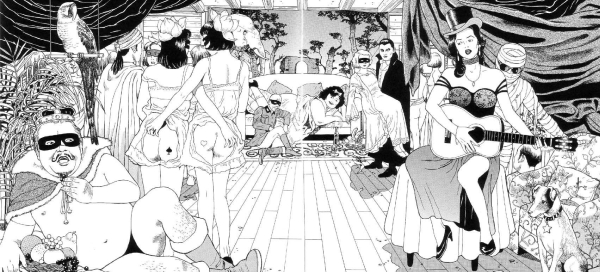
The manga becomes even more interesting in later chapters, when it introduces new character and mythic imagery, turning it into a nightmarish fairy tale soaked in blood, madness and depravity. Its experimental structure and abstract symbolism draws heavy influence from European cinema and literature, lending it a strange art-house flair.
This is most noticeable in its mesmerizing art. It is clean, expressive, and grotesquely beautiful. Every panel feels meticulously composed, making the horrific content hit even harder.
Be warned: this is the most twisted and sexual explicit horror manga on this list. But for those who can stomach it, The Laughing Vampire is a bold, visionary work that pushes the genre’s boundaries both stylistically and thematically.
Genres: Horror, Psychological, Supernatural, Vampire
Status: Finished (Seinen)
40. Shiki
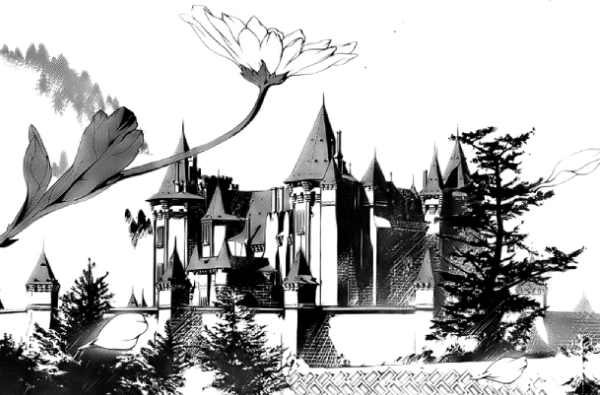
Shiki is a slow-burning, morally complex vampire manga set in a quiet mountain village where the dead begin to rise. Adapted from Fuyumi Ono’s novel, the story explores what happens when denial, fear, and survival instincts collide.
At first glance, Shiki’s biggest hurdle is its presentation. The stylized art can feel jarring or even silly. Combined with its sluggish first half and a more than obvious setup (a mysterious family moves into a remodeled European-style mansion, and soon after people die of anemia), it is easy to dismiss Shiki before it truly begins.
Over multiple volumes, we follow the village’s doctor, Ozaki, as he methodically investigates the deaths while dismissing any kind of superstition. The manga doesn’t solely focus on him, though. We witness the lives and deaths of countless other people, watch as families are torn apart, and how people struggle to cope with tragedy. This is Shiki at its most dense, but also most essential.
Eventually, the truth becomes unavoidable: vampires are real.
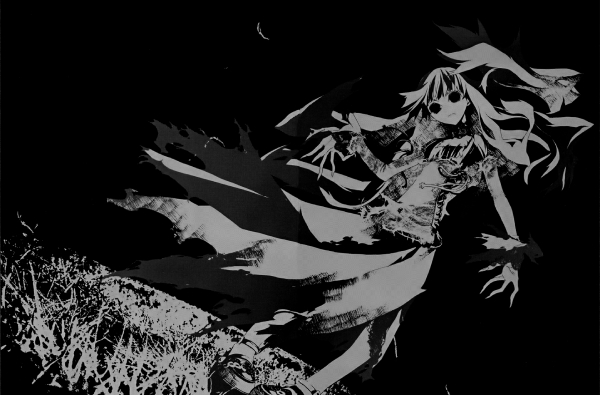
And that’s when Shiki hits truly hard. The second half turns into one of the most brutally haunting and deeply disturbing stretches in horror manga. It raises the manga’s central question: Who are the real monsters?
Beneath the bloodshed lies a deep meditation on prejudice, moral compromise, and how easily we justify atrocities once we stop seeing others as human.
Shiki isn’t for everyone. It’s an extremely slow-burning, dense, and uneven manga, but by the end, you’re rewarded with one of the most philosophically rich and emotionally devastating horror manga on this list. It earns its place not just for scares, but for daring to ask what separates survivor from killer.
Genres: Horror, Mystery, Drama, Tragedy, Vampire
Status: Finished (Shonen)
39. Lychee Light Club
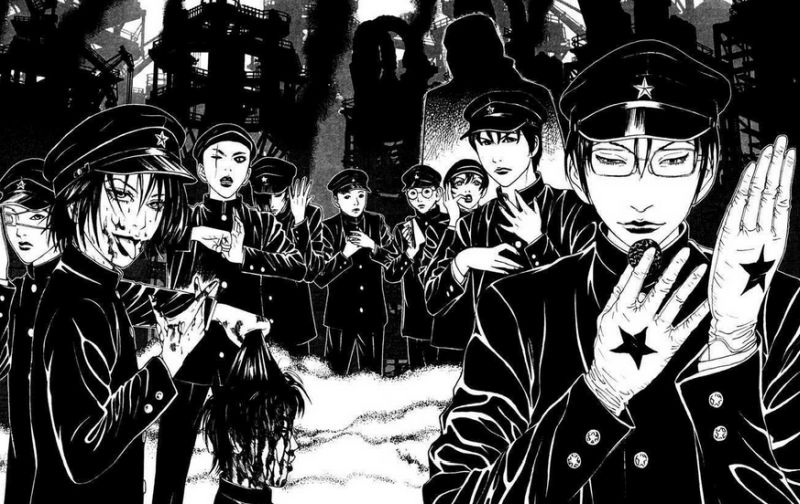
Lychee Light Club is one of the most bizarre and grotesque horror manga on this list. Inspired by a 1980s stage play and heavily influenced by the works of Suehiro Maruo, this short series by Usamaru Furuya blends ero-guro sensibilities with dystopian absurdity.
The story follows a group of middle schoolers who form the secretive, cult-like Hikari Club. Obsessed with beauty and power, they build an AI-powered robot named Lychee to abduct beautiful girls from the nearby town. As the club’s ideas grow more extreme, however, internal tensions mount, and things spiral into sadism, betrayal and murder.
What makes Lychee Light Club so disturbing isn’t the copious amounts of gore and depravity on display, but how it mirrors fascist group think. We witness emotional repression, but also the violent fantasies of adolescent boys. It’s a descent into madness, framed as a theatrical tragedy.
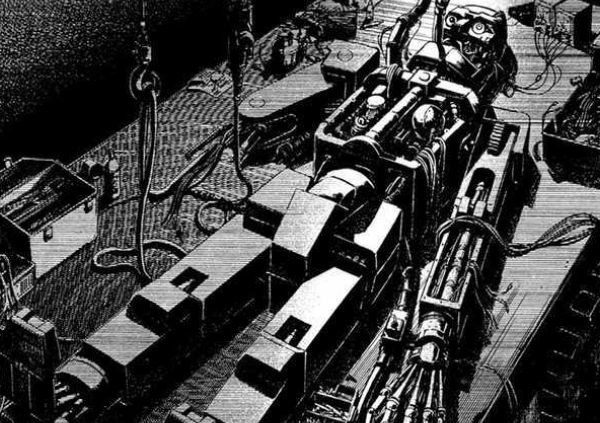
Furuya’s artwork is sharp, dramatic, and reminiscent of Maruo’s. His clean line work contrasts heavily with the brutal content, enhancing the manga’s already surreal tone. It’s not just grotesque, it’s almost operatic.
Lychee Light Club is not for the faint of heart, and amongst the most deranged manga on this list. It’s surreal, violent and often disgusting. Yet it’s also oddly brilliant. It’s a satirical and horrifying take on group obsession and toxic ideology.
Genres: Horror, Psychological, Sci-Fi, Thriller, Romance
Status: Finished (Josei)
38. Starving Anonymous
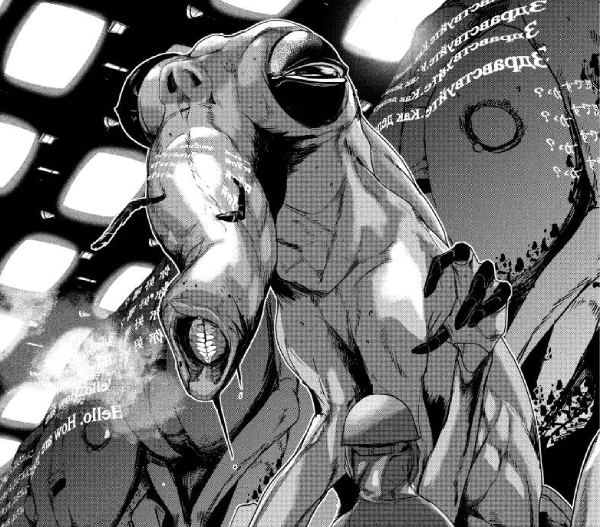
Starving Anonymous is one of the most grotesque and disturbing horror manga on this list. What starts as a surreal survival nightmare quickly escalates into a full-blown descent into bio-industrial hell.
The story begins when two high school students, Ie and Kazu, fall unconscious after their bus is flooded with mysterious gas. They awaken in a truck packed with frozen human corpses, only a stop away from a human meat processing conveyer belt. The facility they’re in is pure nightmare fuel: people are fattened up with synthetic feed, then dismembered, bred or fed to monstrous, alien-like creatures with insectoid features.
It’s a twisted and relentless manga, packed with gore, body horror and sci-fi dystopia. The creature design is fantastically repulsive, and the art is consistently intense and brutal. We witness graphical violence, breeding chambers and fleshy, bug-eyed monsters.

While Starving Anonymous starts as pure survival horror, it gradually shifts into action territory, introducing regenerating humans and other bizarre twists. It can get wild and uneven, but its core terror never fades. The central premise of humans as livestock for an alien species is strong enough to sustain the madness.
While it’s not the most refined or philosophical horror manga out there, Starving Anonymous earns its place for its sheer shock value and relentless grotesquery. For those who enjoy it, there’s also a sequel series that continues the story in an unexpected but compelling new direction.
Genres: Horror, Alien, Survival, Gore
Status: Finished (Seinen)
37. Godchild
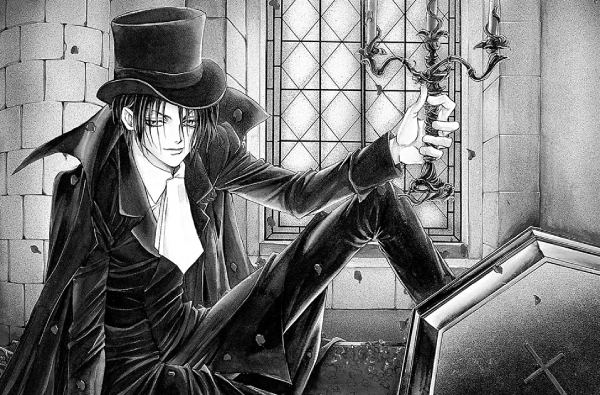
Godchild might be a shojo manga, but it’s far more haunting and disturbing than it first appears. It’s a gothic thriller set in 19th century London and follows Cain Hargreaves, a young nobleman with a tragic past. Over the course of the story, he investigates a string of macabre crimes alongside his loyal servant Riff and his half-sister Mary Weather.
At first glance, Godchild may not look like a traditional horror manga. Its delicate, ornate artwork reflects its shojo roots, and the story carries an almost theatrical tone. But underneath its beauty lies a world filled with deadly poisons, child murders, twisted cults, and psychological torment.
The crimes Cain uncovers are often shocking and deeply unsettling plots drenched in Victorian horror. It almost feels like a gothic, horror-infused version of Sherlock Holmes.
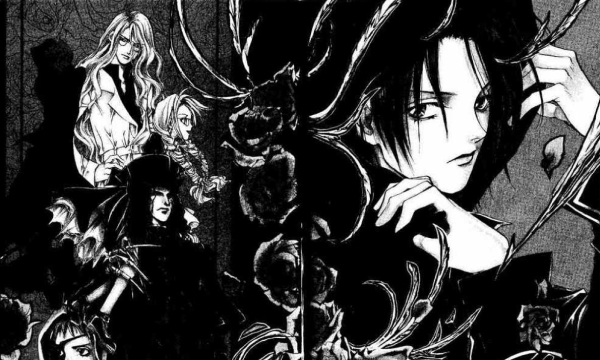
What truly elevates Godchild, however, is its overarching narrative. As Cain digs deeper into London’s dark underbelly, he unearths a sinister web of secrets tied to his own family and a secret organization known as Delilah.
The manga also features elements of BL (boys’ love), but they’re subtle, tragic and thematically rich rather than fanservice-driven.
Godchild is actually the continuation of The Cain Saga, also by Kaori Yuki. While the prequel is very much worth reading, Godchild stands as the superior work, boasting more refined art, stronger storytelling and deeper emotional stakes.
While not a horror manga in the traditional sense, its gothic atmosphere, disturbing crimes, and psychological cruelty absolutely justify its inclusion. Godchild is a must read for fans of gothic mystery, dark romance, and elegant horror.
Genres: Horror, Historical, Mystery, BL
Status: Finished (Shojo)
36. Soil
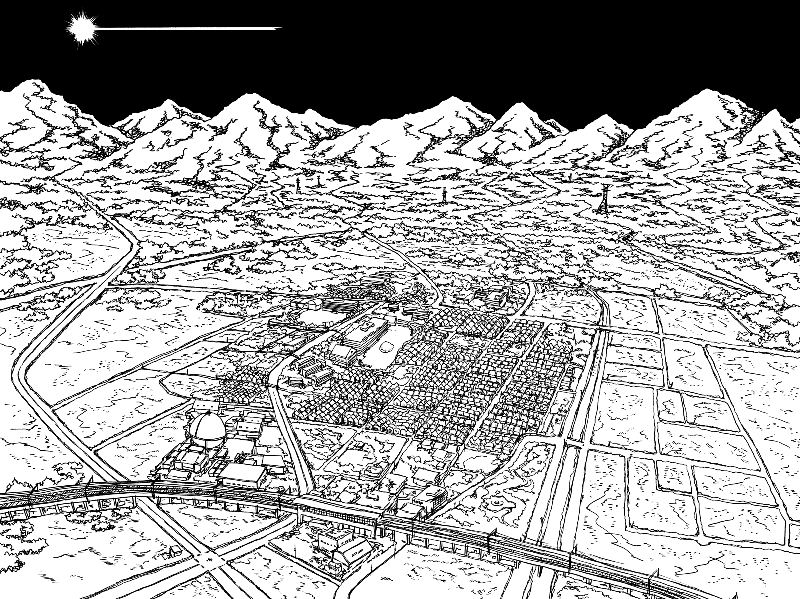
Soil by Atsushi Kaneko is one of those rare manga where you reach the end, realize you loved the experience… and still don’t know what you just read.
What starts as a routine mystery, the disappearance of a family in the idyllic, suburban ‘Soil New Town,’ quickly spirals into a surreal, increasingly incomprehensible descent into madness. Two detectives, the abrasive Yokoi and the more grounded Onada, begin investigating, but as they dig deeper, the town’s strange underbelly reveals itself through eerie characters, bizarre events, and an atmosphere thick with dread and absurdity.
The art in Soil takes some time getting used to. At first glance, it may seem stiff or simplistic, but it evolves as the story descends into chaos. Kaneko’s stylized visuals gradually shift into a distorted, dreamlike visual language that mirrors the story’s unraveling logic.
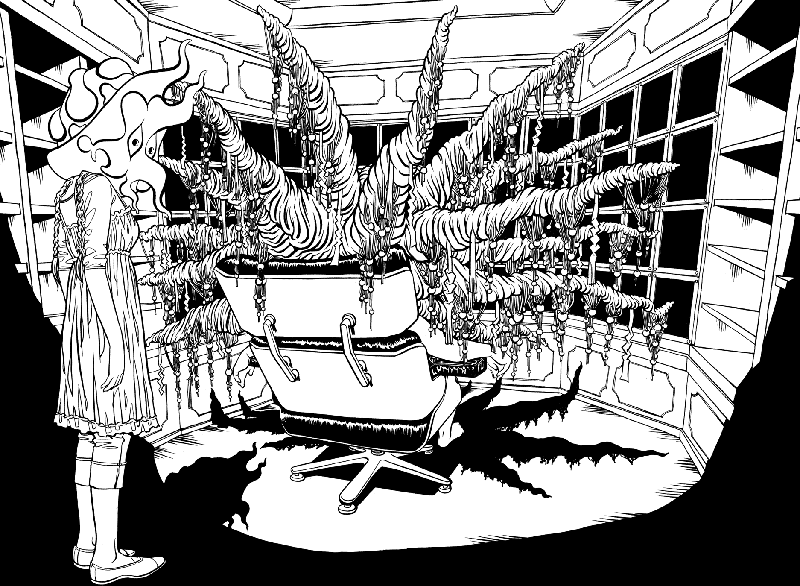
While Soil’s mystery is gripping in the beginning, it eventually becomes less about plot resolution and more about immersing the reader in creeping unease. Its characters are flawed and human, sometimes eccentric to the point of discomfort. Especially Yokoi stands out, who is among the most unpleasant protagonist I came upon.
The final act becomes almost impenetrably strange. Questions multiply, logic dissolves, and the manga offers almost no answers. Whether this is genius or indulgence will depend on your taste, but one thing is certain: Soil is an unforgettable experience.
It’s a disturbing, surreal and, at times, frustrating journey, but for fans of weird fiction, psychological horror, and unconventional storytelling, it’s one of the most unique horror manga you’ll ever read.
Genres: Horror, Crime, Mystery, Psychological, Philosophical
Status: Finished (Seinen)
35. I Am a Hero
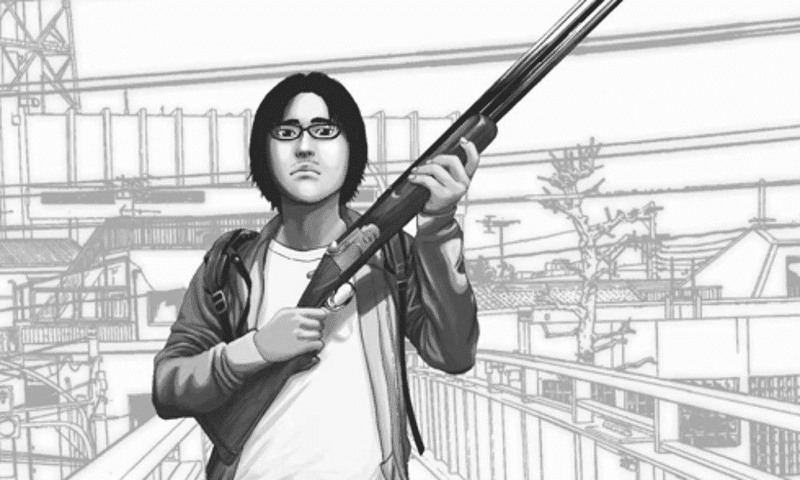
I Am a Hero by Hanazawa Kengo is one of the most unique zombie horror manga ever written. What sets it apart isn’t just the grotesque infected, or the bleak apocalyptic setting, it’s the protagonist. Hideo Suzuki is a 35-year-old manga assistant suffering from schizophrenia. He talks to people who aren’t there, hallucinates, and is deeply insecure and alienated from society.
And then the world ends.
The outbreak begins slowly, but once the infected finally appear, they aren’t just zombies. Instead, they are malformed horrors frozen mid-sentence, often repeating their final thoughts while tearing people apart. Over time, they take on more bizarre forms, mutating into fleshy, towering abominations, and even merging into monstrous hive-minds. The body horror here is exceptional.
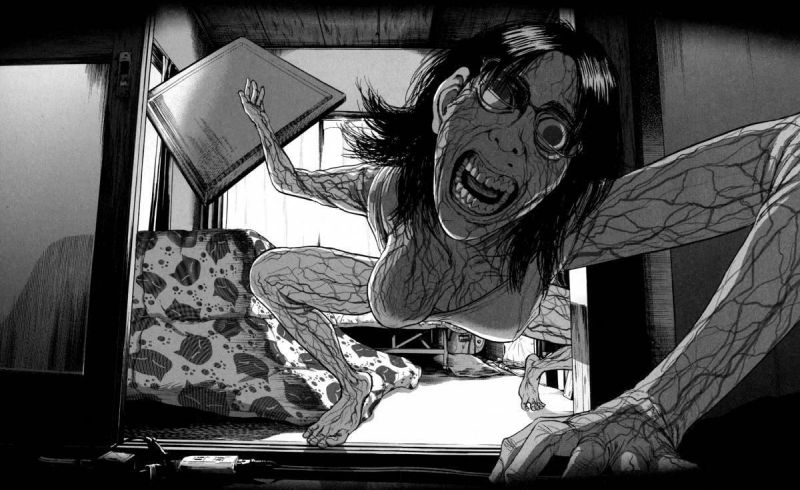
What makes I Am a Hero shine most, though, is its grounded realism. Hideo is not your typical action hero. He hesitates, panics, and overthinks constantly. Watching someone so mentally fragile trying to survive in such a brutal world gives the story its unique emotional core.
The series later shifts focus to other characters, some even stranger, and less compelling, making the manga slightly less enjoyable. The most controversial part, however, is the manga’s abrupt ending. Many readers were left wondering if the manga was cut short (officially it wasn’t, but it feels that way).
Still, even with its flaws, I Am a Hero remains a masterclass in zombie horror. Its psychological depth, surreal atmosphere and terrifying creature design make it an unforgettable experience, and one of the best horror manga of all time.
Genres: Horror, Thriller, Zombies, Survival, Psychological
Status: Finished (Seinen)
34. Centuria
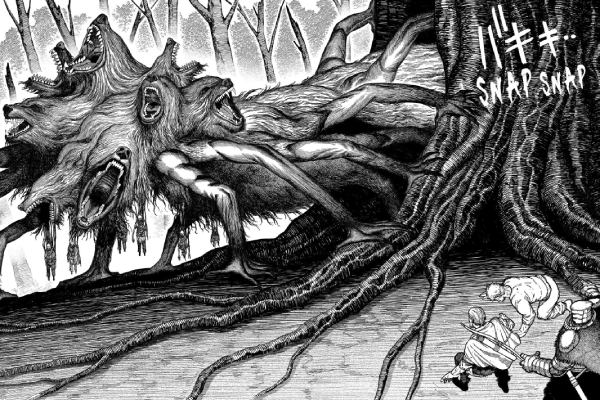
Centuria by Tooru Kuramori is a stunning new dark fantasy manga. It opens with a brutal prologue that outshines many modern horror manga. Set aboard a slave ship adrift in a storm, 99 slaves are slaughtered before a mysterious sea god intervenes. In exchange for one last sacrifice, the god bestows incredible power upon a lone survivor, a teenage boy and former slave named Julian.
After he survives an onslaught of sea creatures, he comes to live in a small village, befriending the locals. Yet his unique situation soon draws the attention of darker forces.
Centuria blends historical grit with supernatural horror. From tentacled sea gods to grotesque multi-headed beasts, it evokes a distinct Lovecraftian energy. The creature design is nothing short of fantastic, and rivals the best in the medium: twisted, organic, and deeply unsettling.
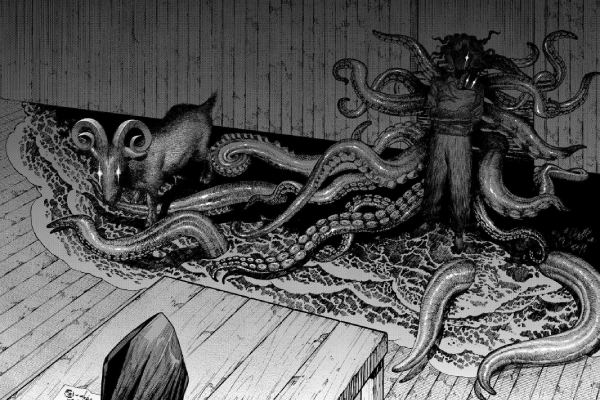
Visually, this manga is breathtaking. The art is richly detailed and cinematic, drawing comparison to such masterpieces as Berserk and Dorohedoro. Its world is beautiful, highly detailed, showcasing vast nature and terrifying threats in all their glory.
That said, while Centuria’s aesthetic and its early chapters scream grim dark fantasy, the story leans closer into dark shonen than seinen. The moral complexity I was hoping for is almost nonexistent. Characters are painted in broad strokes. They are good or bad, heroic or cruel. Yet Centuria is still early in its run, so these aspects might deepen as the story continues.
Even so, Centuria is a must-read for fans of dark fantasy and horror manga. It may not be the next Berserk, but its vivid art and cosmic undertones make it a standout amongst recent manga.
Genres: Horror, Fantasy, Action, Supernatural (Shonen)
Status: Ongoing (Shonen)
33. Noah of the Blood Sea
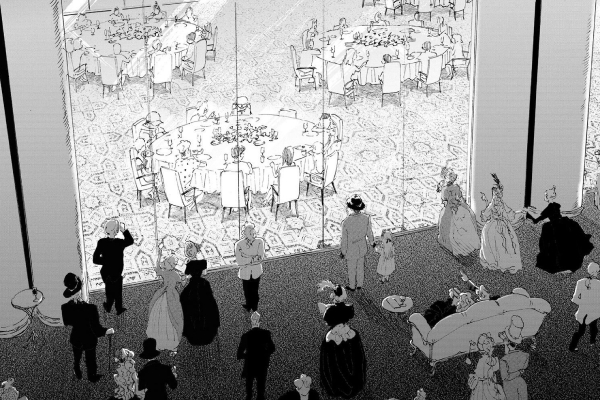
Noah of the Blood Sea by Yuu Satomi is a stylish, emotionally charged vampire horror manga set aboard a cruise ship, but with a deeply gothic twist. What begins as a glamorous family vacation quickly devolves into a claustrophobic nightmare filled with bizarre, violent events and vampiric terror.
The manga opens strong. Early chapters are easily the most compelling, immersing the reader in slow-burn dread. A standout moment involves a stage show gone wrong, in which passengers are seemingly murdered, only to return unharmed. And yet, our protagonist, Kakeru, suspects something impossible: are those really the same people?
From here on out, the horror only ramps up.
Noah of the Blood Sea plays with classic vampire tropes: the predator prey dynamic, the human livestock metaphor, and the pain of transformation. Yet it gives all of it a unique flavor.
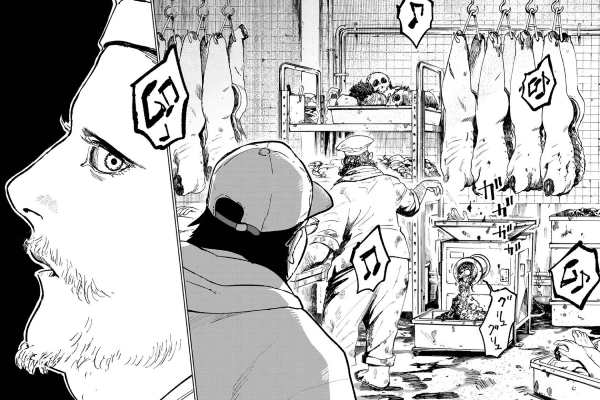
While the emotional and disturbing moments hit hard, the manga has its weaknesses. It is face-pasted, almost too fast. Many side characters are only introduced to be killed, and shifting perspectives can make it hard to grow attached to anyone. Especially towards the end, the narrative spirals into chaos, leaving more threads hanging than it resolves.
That said, the art is consistently strong. Interiors are lavish and atmospheric, and the visual horror is delivered with striking impact.
Noah of the Blood Sea may not be perfect, but it’s still a unique blend of horror, mystery, dread, and outright vampire carnage. It absolutely earns a spot on this list of the best horror manga.
Genres: Horror, Mystery, Vampire, Psychological, Tragedy
Status: Finished (Seinen)
32. Parasyte
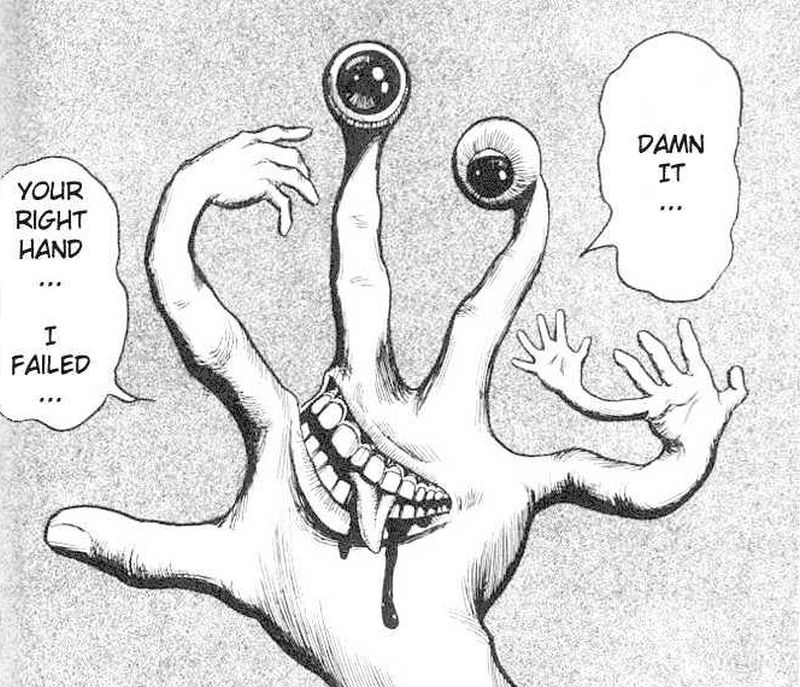
Parasyte is one of the foundational horror manga of its kind. It’s a blend of sci-fi and body horror from the late 80s and early 90s that still holds up today. Written and illustrated by Hitoshi Iwaaki, it explores themes of identity, survival, and what it truly means to be human.
The story follows high school student Shinichi Izumi, whose life is upended when a mysterious worm-like creature burrows into his body. He wakes up mid-invasion, preventing the parasite from reaching his brain, and only inhabits his right arm. The result is a bizarre symbiosis: both Shinichi and the creature, Migi, keep their individual consciousness and must learn to coexist.
Yet Migi is one of many. Other parasites are successfully taking over human hosts and using their bodies to hunt and consume other humans. As Shinichi becomes entangled in their world, he’s forced to confront his own humanity, as the lines between man and monster begin to blur.
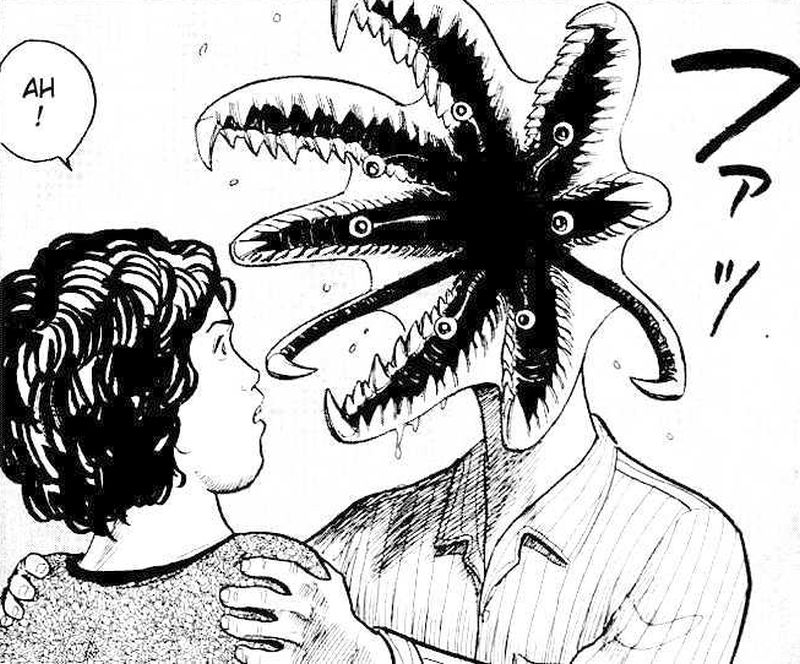
Parasyte thrives on paranoia and disgust. You never know who’s still human and who’s an alien shapeshifter. While there are moments of black humor, the horror is front and center. Parasyte is gruesome, featuring copious amounts of graphic and visceral violence. Bodies are shredded, twisted and contorted in nightmarish ways.
Despite being over three decades old, Parasyte remains one of the most compelling horror manga ever written. It’s a brilliant mix of action, philosophy, and grotesque alien terror.
Genres: Horror, Action, Alien, Sci-Fi
Status: Finished (Seinen)
31. MPD Psycho
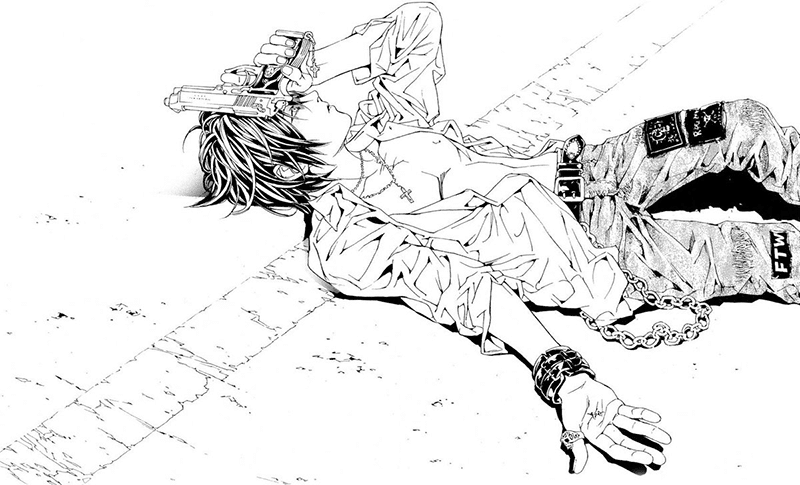
MPD Psycho is a manga I started reading years ago, back when it first began serializing. I only read a few chapters, but the imagery stayed with me. It was sharp, shocking and unforgettable. Recently, I picked it back up and finally finished it, and I’m more than glad I did.
The story follows Kazuhiko Amamiya, a detective suffering from multiple personality disorder. At first, the manga seems like a gritty, episodic crime thriller in which Amamiya, or one of his personalities, solves grotesque and bizarre murder cases. Yet things quickly spiral into something much bigger. What begins as detective noir turns into in an elaborate conspiracy layered psychological horror thriller.
Visually, MPD Psycho is stunning. Shou Tajima’s art is clean, detailed, and disturbingly precise. Crime scenes are intricately rendered and full of graphic violence. We witness dismembered bodies, twisted corpses, and brutal torture. It’s stomach churning, but also eerily fascinating.
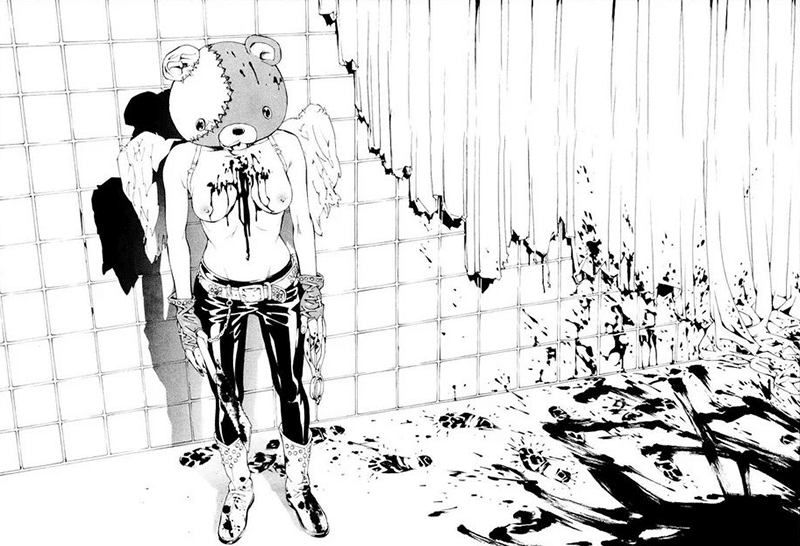
MPD Psycho is much more than gore and shock value, though. It’s a deeply psychological horror manga. The manga explores the fragility of identity, memory, and morality, using Amamiya’s fractured mind as a lense. This fractured mind, however, is also the manga’s biggest hurdle. The shifting personalities can become difficult to follow, especially as the overarching plot grows more convoluted.
It’s a challenging read, narratively dense, morally bleak and full of disturbing imagery. But if you’re looking for a horror manga that pushes boundaries, both visually and psychologically, I highly recommend MPD Psycho. It’s brutal, brilliant and unforgettable.
Genres: Horror, Mystery, Psychological, Crime, Thriller
Status: Finished (Seinen)
30. My Dearest Self With Malice Aforethought
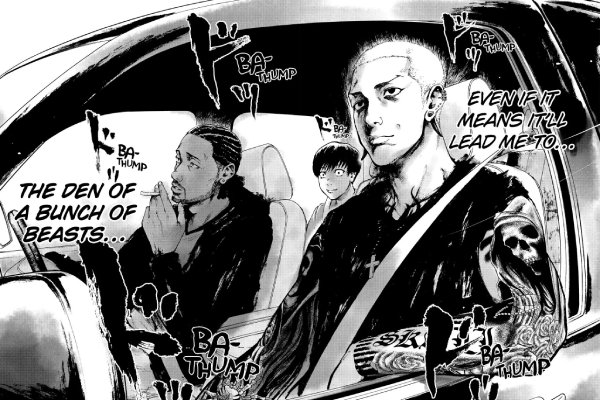
My Dearest Self With Malice Aforethought is one of the most addictive thriller manga I’ve ever read in years. It’s not a horror manga per se, but I’d still like to include it on this list.
The story follows Eiji Urashima, a seemingly average college student who wakes up one morning next to a beautiful girl claiming to be his girlfriend. The problem is, he doesn’t know who she is. Even worse, when he tries to piece things together, he realizes several days have passed without him noticing.
What starts as a mild case of memory loss quickly escalates into something much darker and much more twisted.
This manga is absolutely insane when it comes to plot twists. In the first half, there’s a massive revelation every few chapters, throwing everything you knew completely out the window. I loved it. The pacing was relentless, and the sheer unpredictability of the story kept me glued to every chapter. Yet this is not for everyone, and some people might find it not only overwhelming, but disjointed and cheap.
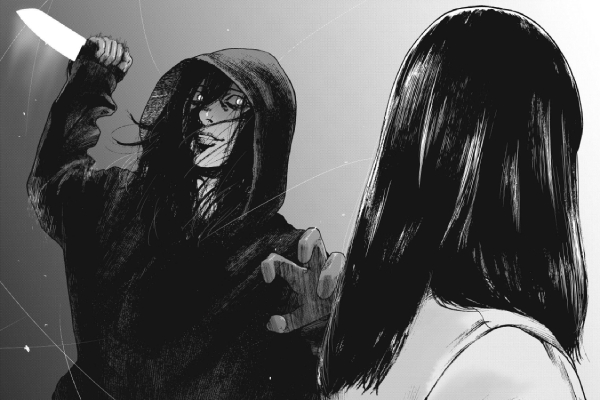
Even worse, while I thought all the twists made sense in the story’s internal logic, the plot becomes downright outlandish as it goes on.
Another downside is the manga’s second half. After it’s thrilling first half, the story slows down, the chaos is reigned in, and it moves steadily toward resolution. It’s not bad, but it lacks the electrifying tension of its earlier chapters.
Even so, My Dearest Self With Malice Aforethought left a strong impression on me. It’s the type of manga that gets under your skin, not because of gore or graphical violence, but because of how it manipulates your expectation.
Genres: Psychological, Thriller, Mystery, Drama
Status: Finished (Seinen)
29. Attack on Titan
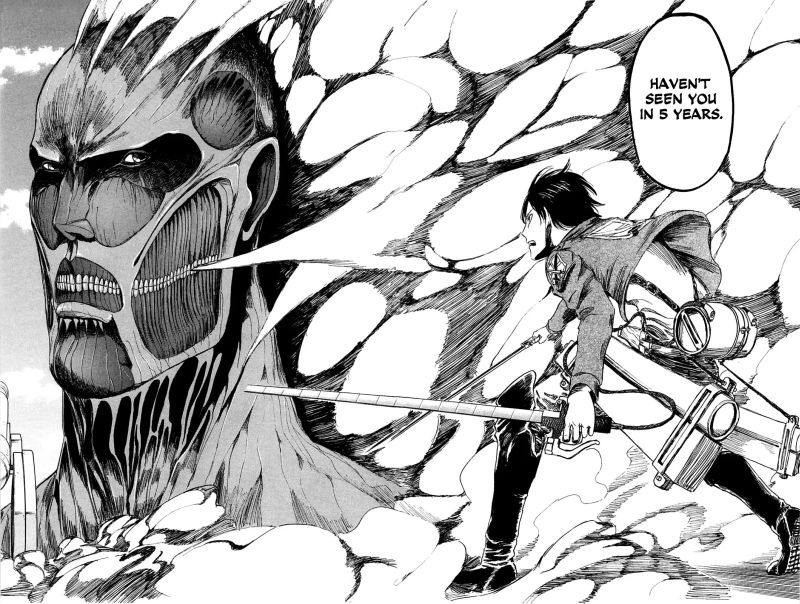
Attack on Titan is one of the most iconic and ambitious manga of the past two decades. While it’s more a dark fantasy action series than outright horror, its early arcs are full of gruesome deaths, relentless dread, and terrifying humanoid monsters. Thus, it deserves a place on this list.
The story is set in a world where humanity is on the brink of extinction, hiding behind enormous walls to protect themselves from Titans, giant mindless beings who devour humans for no reason. What starts as a simple survival manga about a boy named Eren Yeager soon turns into something much bigger and far more complex.
At first, Attack on Titan feels like a desperate fight for survival. The Titans are horrifying, not because they are grotesque, but because they aren’t. They look like blank-faced, grinning humans. They are uncanny and emotionless. Their violence is sudden, senseless and deeply disturbing. The earlier chapters deliver constant tension, fear and high-stakes action.
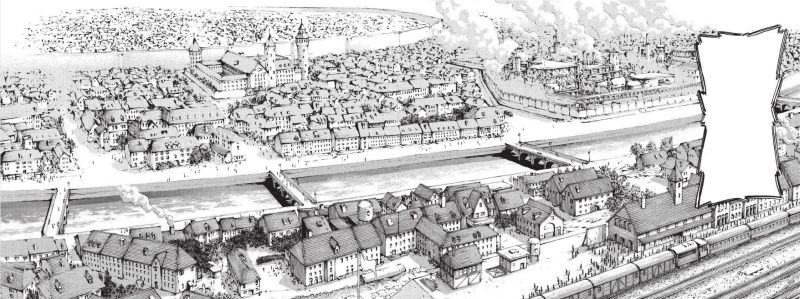
As the story progresses, though, it shifts. The latter half pivots into political intrigue, conspiracies, and war. The mystery of the Titans is peeled back, and the horror gives way to something more grounded, but equally dark, eventually culminating in one of manga’s most divisive endings.
The art is another point of contention. Early chapters are rough, distractingly so. Hajime Isayama’s style improves rapidly though, and the manga shines in later arcs. The fight scenes become more visually striking and fluid, and the wide shots of cities are gorgeous.
Attack on Titan may not be a traditional horror manga, but its haunting atmosphere, brutal world and terrifying monsters make it one of the most unforgettable dark manga ever created.
Genres: Horror, Fantasy, Action, Military, Survival
Status: Finished (Shonen)
28. The Summer Hikaru Died
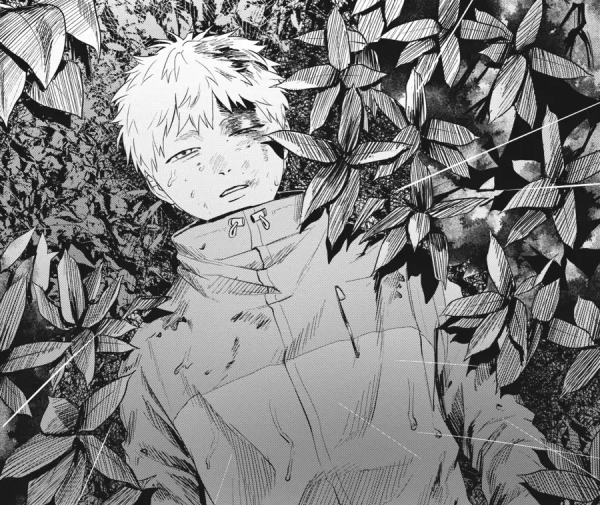
The Summer Hikaru Died by Mokumokuren is one of the most compelling new horror manga in recent years. It begins with a simple but chilling premise: Yoshiki, a boy in a quiet mountain village, knows his best friend Hikaru is no longer the same. He looks like Hikaru, he talks like Hikaru and even remembers things that only the real Hikaru would know. Yet he’s something else.
The manga wastes no time revealing this. Hikaru’s true nature is established in the manga’s first chapter, giving the story a cosmic horror edge. At times, Hikaru’s true form spills out into something massive and otherworldly: a writhing, incomprehensible shape of pulsating patterns and alien beauty.
What makes The Summer Hikaru Died so powerful isn’t just the horror, though the tension and unease are real and almost constant. It’s the emotions. This is a tender, deeply introspective story about grief, love and identity. Yoshiki isn’t just afraid. He’s in mourning. But he can’t let go. There’s a quiet emotional resonance in his decision to stay by the new Hikaru’s side, even when he knows this being is something else entirely.
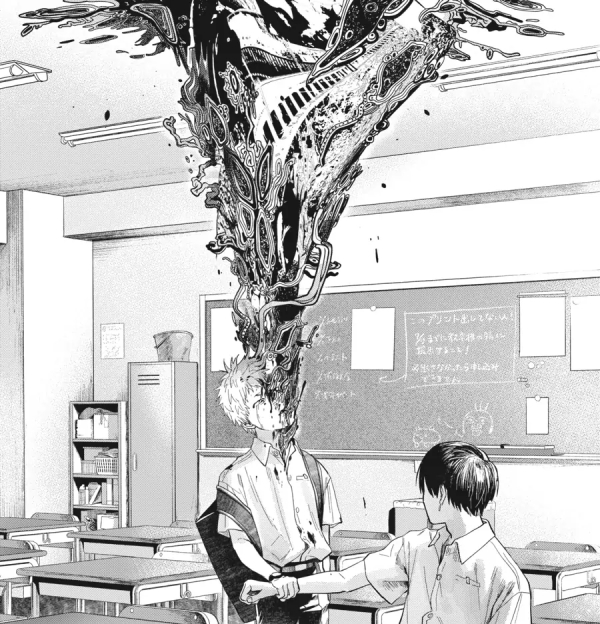
There are clear BL (boys’ love) elements here, but they’re handled with care and sincerity. There’s even an early scene in which Yoshiki plunges his hand into Hikaru’s body. It’s unsettling and uncomfortable, but undeniably intimate, a metaphor for connection, sex, and the confusion of adolescence.
The manga also draws from Japanese rural folklore, adding a creeping mystery to the story, centering on a local deity known as Nounuki-sama.
If you like cosmic horror mixed with emotional intimacy, coming-of age melancholy, and a creeping mystery, this one’s a must read.
Genres: Horror, Mystery, Supernatural, BL
Status: Ongoing (Seinen)
27. Franken Fran
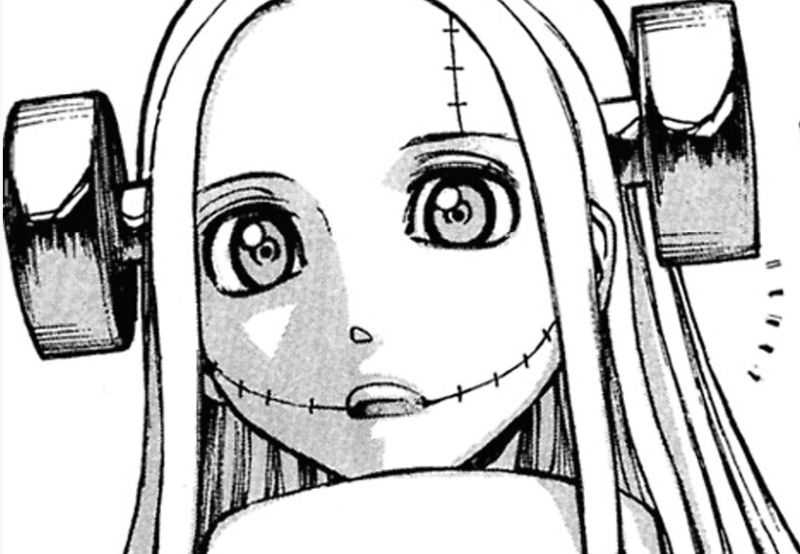
Franken Fran by Katsuhisa Kigitsu is one of the most bizarre and unforgettable horror manga out there, and that’s why it belongs on this list.
At its core, Franken Fran is an episodic, medical horror manga. Each chapter introduces a new patient, a new problem and a new grotesque solution offered by Fran, the stitched-up successor of a famous mad scientist. She means well, but her surgical experiments often end in horror.
Tonally, the series is all over the place. It bounces between twisted satire, gross-out horror, and surprisingly tender vignettes. There’s an unforgettable chapter about a vampire who longs to die. Another about a girl rebuilt into something unrecognizable. Then there’re the brain babies, stitched-up dog-men, bug transformations, and so many more.
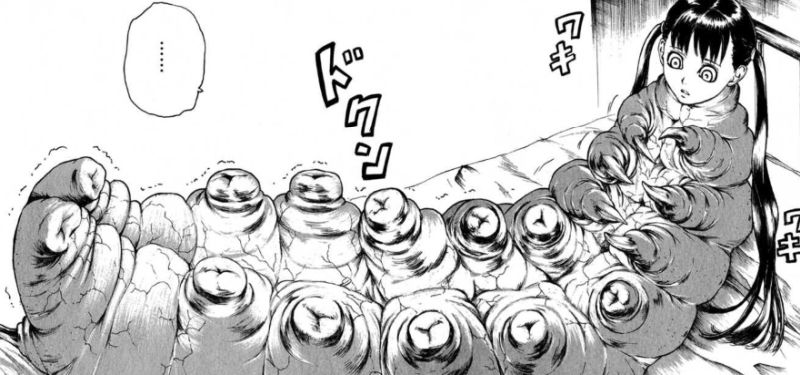
The artwork is excellent, especially when it comes to the horror. Organs, gore, surgeries, and bizarre body horror are rendered with precision and flair. Fran’s world is one where intestines spill freely, and science stretches the limits of life and death.
Not every chapter lands, though. Some veer a little too silly or shallow. But even then, the sheer imagination at play keeps you reading. There’s also its sequel Franken Fran Frantic, but it’s quite a bit weaker than its predecessor and leans even more into dark satire.
Despite its flaws, Franken Fran is a standout in the medical horror niche. It’s gross, funny, sometimes thoughtful, but always weird. If you’ve got the stomach for it, and a love for episodic madness, it’s absolutely worth reading.
Genres: Horror, Science / Medical, Sci-Fi, Comedy (Shonen)
Status: Finished (Shonen)
26. N
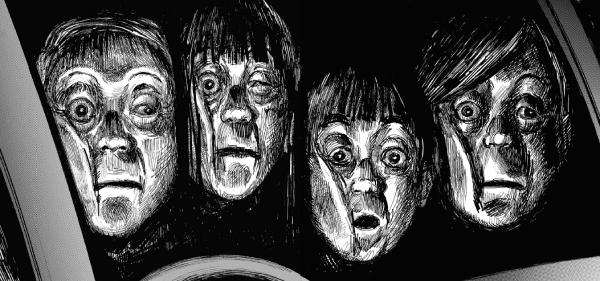
N is one of the most chilling modern horror manga. Written by Kurumu Akumu and illustrated by Niko to Game, this horror manga delivers creeping dread and disturbing imagery in spades.
At first glance, N feels like an anthology. Each chapter presents a different short horror tale: a strange disappearance, an unsettling live stream, a haunting urban legend. As you read on, however, a sinister thread pulls everything together. A mysterious group called N seems to be behind it all.
While the plot is cryptic, it’s never directionless. Slowly, pieces fall into place, and by the end of volume two, the story ties its events together, but still leaves you with enough unanswered questions to keep you curious. It’s the type of manga that rewards careful reading.
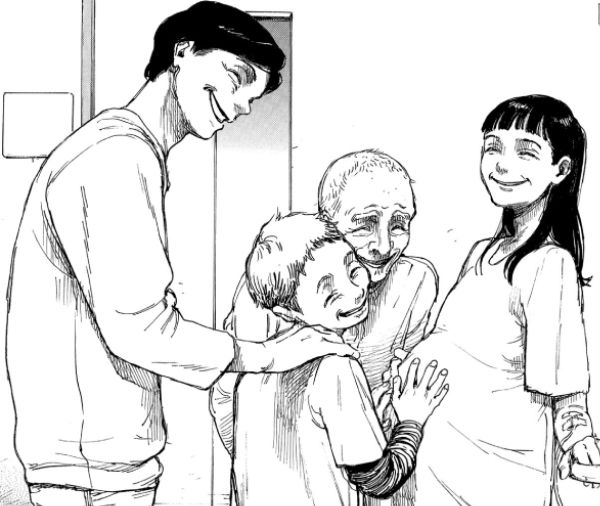
The art might seem rough at first. It’s sketchy, the line work can be chaotic, but when the horror hits, it hits hard. The distorted faces, uncanny smiles, and surreal composition create genuinely terrifying panels. This style adds to the unease, amplifying the fear that runs through every chapter.
N stands alongside such horror staples as PTSD Radio and Fuan no Tane, continuing the tradition of Japanese urban horror while introducing its own unique mythos. It’s unsettling, gripping and genuinely frightening in a way few modern horror manga are.
Though currently on hiatus, a continuation has been teased, and based on what’s been published so far, N is absolutely worth reading. If you’re looking for a modern horror manga that will make your skin crawl and keep you up at night, this one’s for you.
Genres: Horror, Mystery, Supernatural, Psychological
Status: Ongoing (Seinen)
25. Mieruko-chan

Mieruko-chan is one of the most unique horror manga I’ve read, and that’s exactly why I love it.
The premise is simple but effective. Miko Yotsuga is a high school girl with the ability to see ghosts. They are horrible and grotesque things that no one else can perceive. But here’s the twist: she doesn’t confront them, doesn’t run from them, or even acknowledge them. Instead, she does everything in her power to pretend she can’t see them, because the ghosts only target people who react.
That’s the brilliance of Mieruko-chan. It’s not about surviving an attack or solving a mystery, it’s about enduring the unbearable. Miko navigates her daily life, often surrounded by horrifying creatures, while doing her best to stay calm, composed, and unnoticed.
This leads to a fantastic blend of horror and slice-of-life comedy. Some scenes are laugh-out funny, while others are deeply unsettling. This contrast works surprisingly well, keeping the story fresh and unpredictable.
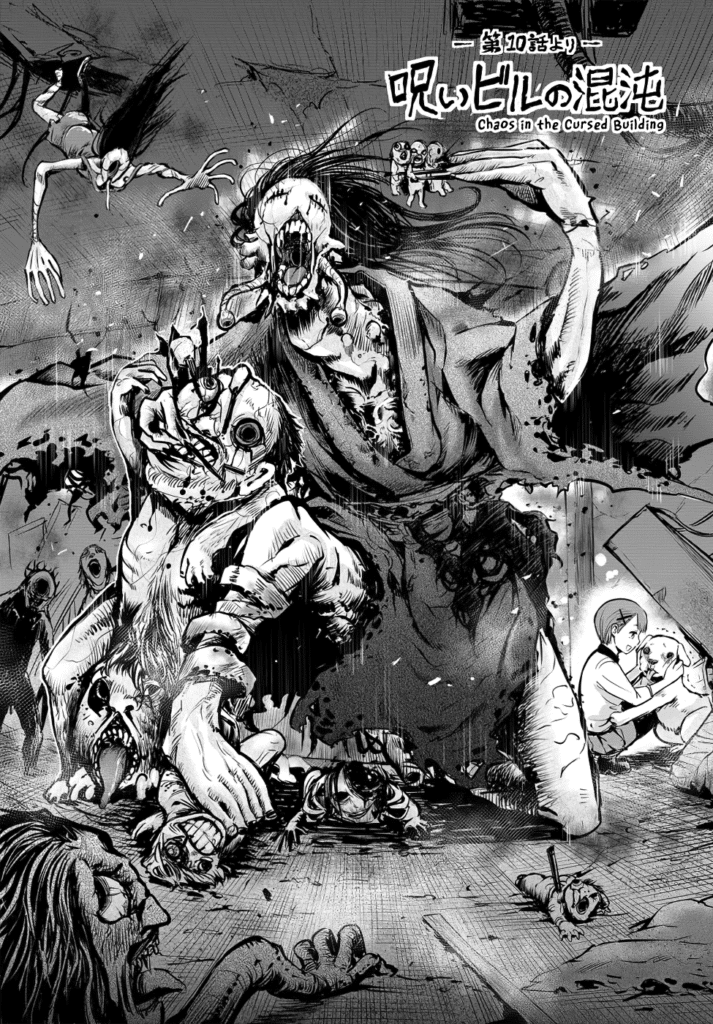
The greatest part about the manga is, without a doubt, the creature design. It’s easily amongst the best in modern horror. The ghosts Miko encounters are pure nightmare fuel. They are twisted, dripping and howling entities that feel both imaginative and wrong in all the right ways. The level of detail in their design is staggering, contrasting extremely well with the manga’s otherwise cute and simple style.
While the plot expands with new characters and lore, it never strays far from its core premise: the quiet horror of pretending everything is okay when it’s very much not.
It’s weird, creepy, and oddly funny, but that’s what makes Mieruko-chan so special.
Genres: Horror, Comedy, Supernatural, Mystery, Slice of Life
Status: Ongoing (Seinen)
24. DRCL Midnight Children
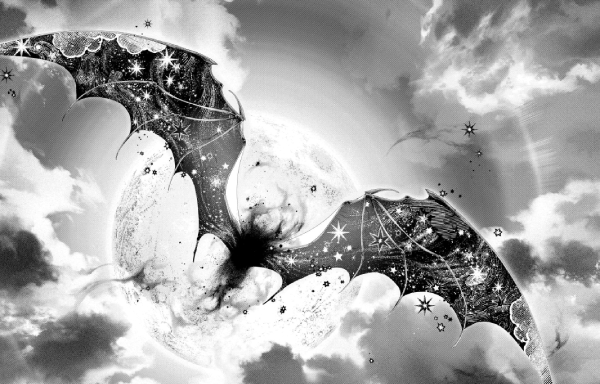
DRLC Midnight Children is one of the most stunning horror manga on this entire list, perhaps even the most beautiful. Created by Shinichi Sakamoto (The Climber, Innocent), this gothic horror retelling of Dracula is a surreal, elegant nightmare drenched in atmosphere and drawn with breathtaking detail.
Set in Whitby School, where a young girl named Mina becomes the first female student, the story begins grounded but soon slips into darkness. Count Dracula arrives, bringing unspeakable evil that threatens not only Mina, but her dear friend Lucy. What follows is a twisted and artistic reimagining of Bram Stoker’s classic full of cryptic dreams, monstrous transformations, and eerie, poetic horror.
Sakamoto’s art is nothing short of jaw-dropping. Every page is intricately composed, from haunting graveyards bathed in moonlight to grotesque monstrosities that emerge from the shadows. The manga’s beauty enhances the horror, creating a dreamlike quality where even the most terrifying moments feel mesmerizing. The paneling is unorthodox, the sequencing fluid and cinematic, and the whole thing reads like a fever dream.
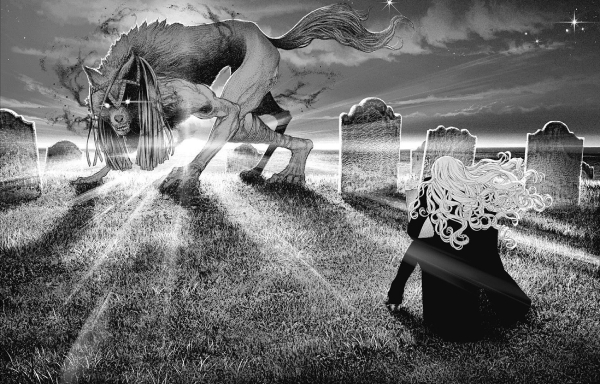
The storytelling is deliberately complex. Sakamoto embraces a non-linear structure, often weaving thoughts, memories and metaphors into the narrative. It can be challenging to follow at times, but that complexity is part of the mangas allure.
DRCL Midnight Children is not just a vampire manga. It’s gothic horror in its purest form: a sensual, unnerving descent into blood, darkness, and obsession. If you’re looking for a traditional horror work, you might find it too abstract. But if you want a visually intoxicating, emotionally layered retelling of Dracula, this is one of the most unique and beautiful horror manga you’ll ever read.
Genres: Horror, Vampire, Fantasy, Drama
Status: Ongoing (Seinen)
23. Goth
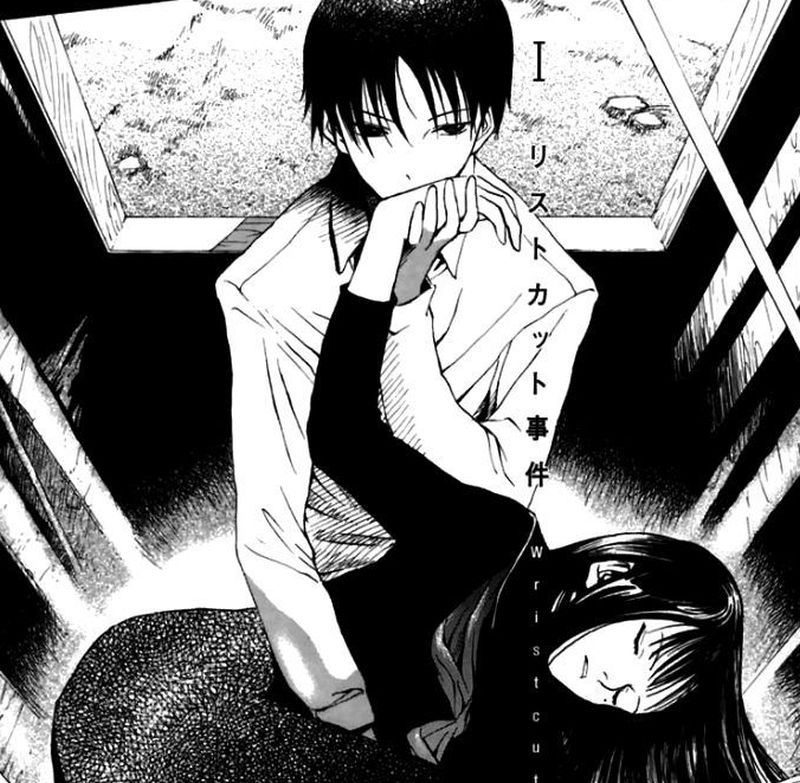
Goth is a short but striking horror manga that holds a special place in my heart because it was one of the first horror manga I ever read. Even now, I consider it one of the best.
Based on the novel by Otsuichi and illustrated by Kenji Ooiwa, Goth follows two high school students, Itsuki Kamiyama and Yoru Morino, who share a fascination with death and murder. But unlike typical horror protagonists, they aren’t innocent victims or heroic investigators. They are just as twisted and disturbed as the killers they observe. This inversion alone makes Goth stand out.
The manga is told as a series of loosely connected cases. Each chapter is dedicated to a different, gruesome murder. While Kamiyama often ends up solving the crime, it’s clear he’s more interested in the killers and their gruesome deeds than in justice.
Goth isn’t a long read, but it’s dense with morbid atmosphere. Its art isn’t outstanding, but shines with comes to depicting graphic violence and disturbing scenarios. The murder scenes are vivid, unsettling and downright grotesque.
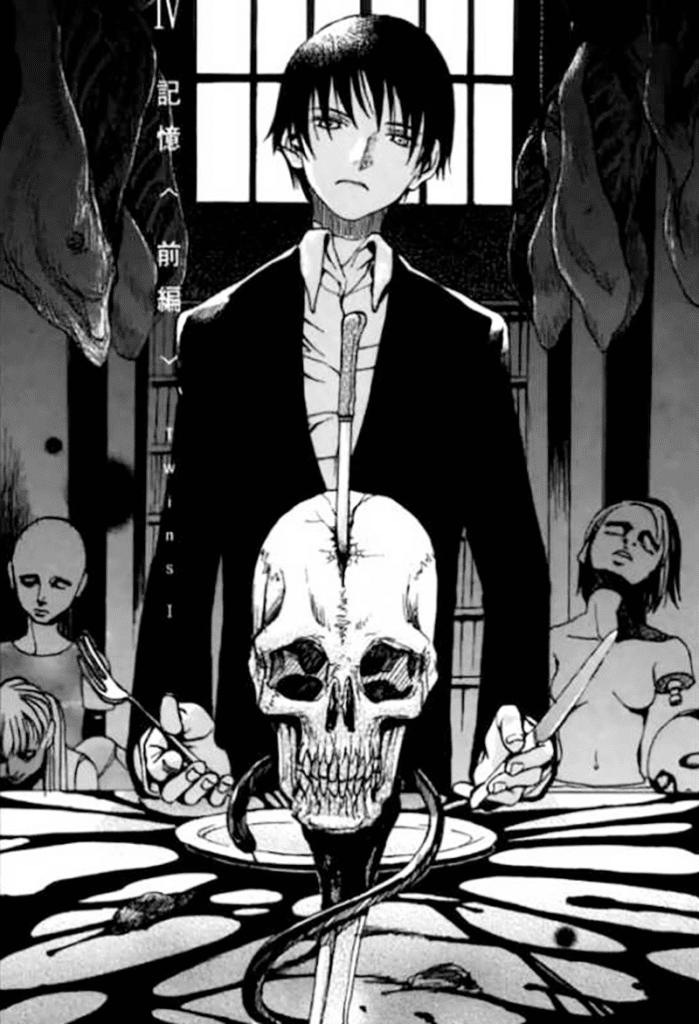
That said, the manga’s brevity is double-edged. Itsuki’s dark tendencies are intriguing, but are never fully explored. The same goes for Morino, whose past is lightly touched upon. Thus, both characters can feel rather shallow by the end.
Still, Goth is memorable and disturbing and quite different from other horror manga. Even with its flaws, it delivers a chilling narrative full of twisted characters.
While I’m sure nostalgia plays a role in how much I love it, Goth remains one of my favorite horror manga.
Genres: Horror, Psychological, Mystery
Status: Ongoing (Shonen)
22. Fraction
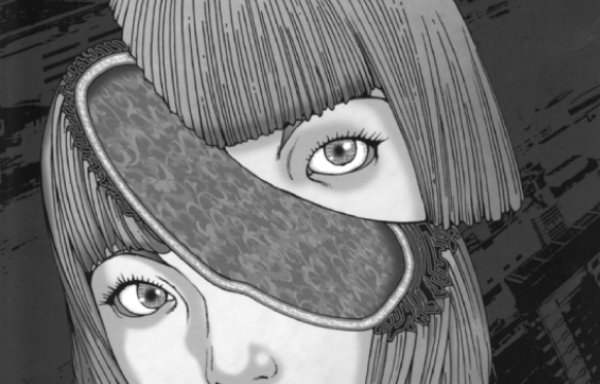
Fraction is one of the most insane, inventive and disturbingly brilliant horror manga I’ve ever read. Written and illustrated by Shintaro Kago, the king of absurdist horror, the manga starts as a gruesome serial killer mystery. Yet it quickly devolves into a mind-bending meta-narrative masterpiece that plays with form, structure and your expectations.
The story opens with The Slicing Devil, a deranged serial killer who murders his victims by slicing them in half. That alone would make for a solid, violent thriller. But then Kago does what he does best: he breaks the narrative and inserts himself as a character in his own manga.
What follows is a surreal exploration of storytelling itself. Kago’s character analyzes the serial killer case while giving long explanations of narrative techniques, genre conventions, and authorial intent. These moments are wildly self-aware, deeply clever, and ultimately lead to one of the greatest twists in manga. When it hit, I dropped my jaw and could only stare at the page. That’s how good it is.
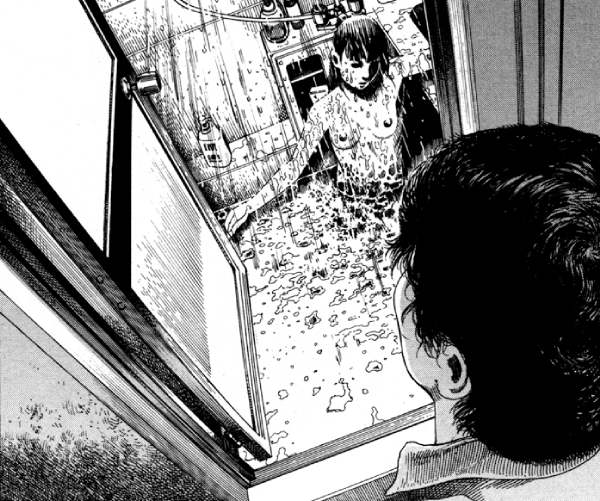
After this, we return to the Slicing Devil, but with a tonal shift that leans into the typical absurdist nonsense Kago is so known for.
The volume also includes several standalone stories, each bizarre in their own right. Voracious Itches is the standout here. It’s an absolutely revolting piece of body horror that has stayed on my mind for years now.
Fraction is not for everyone. It’s chaotic, offensive, and structurally insane. But for fans of experimental horror and meta-narratives, this is essential reading.
Genres: Horror, Mystery, Psychological, Meta
Status: Finished (Seinen)
21. Hellsing

Hellsing is a cult classic horror-action manga, and one of the most stylish, over-the-top series on this list. Written and illustrated by Kouta Hirano, this blood-soaked saga follows Alucard, an immortal vampire who works as the ultimate weapon for the Hellsing Organization, a secret British group dedicated to hunting monsters.
Unlike the gothic elegance of something like DRCL Midnight Children, Hellsing is pure chaos and carnage. Alucard is the definition of an overpowered antihero. He’s smug, sadistic, and nigh unstoppable. He’s joined by Seras Victoria, a newly turned vampire struggling with her humanity, and Integra Hellsing the no-nonsense leader of the organization.
Together they battle their way through a barrage of grotesque enemies, including zombies, werewolves, and most infamously, the Nazi vampires of the Millenium organization.
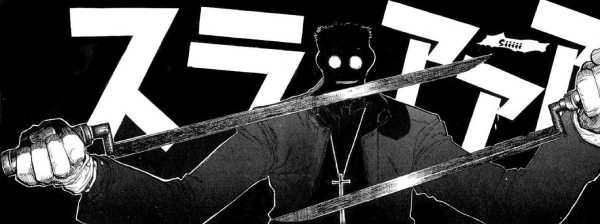
Hellsing’s tone is consistently outrageous, but that’s part of its charm. Everyone is this manga is a badass, from the fanatical priest Alexander Anderson to the cigar-smoking Major, whose villain speeches are as theatrical as they are insane. Every battle is brutal, explosive, and dripping with dramatic flair.
While the art starts off rough, by volume 3 it evolves into something truly distinctive. Hirano’s use of heavy line work, crisp backgrounds, and intense panel composition gives the series a gritty, cinematic feel. It’s messy, but stylish in a way few other manga pull off.
Hellsing isn’t for readers looking for subtle or slow-burn horror. This is adrenaline-pumping, over-the-top vampire carnage, and it’s incredibly fun.
Genres: Horror, Action, Supernatural, Vampire
Status: Finished (Seinen)
20. Nikubami Honegishimi
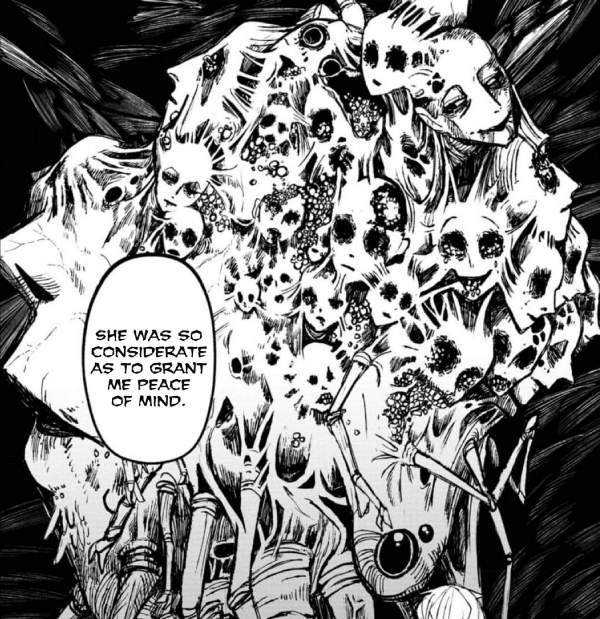
Nikubami Honegishimi by Paregoric is one of the most promising new horror manga out there. Told across two timelines, this atmospheric mystery blends urban legends, grotesque creatures, and a creeping sense of dread.
The story begins in 1999, with eccentric occult magazine editor Inubosaki and her photographer friend Asama investigating a wave of bizarre paranormal events. Each case feels like its own short horror story, featuring cursed dolls, twisted monsters, or surreal sightings. Decades later, in 2023, Inubosaki’s nephew seeks the truth behind her untimely death and tracks down Asama, now a full-fledged psychic. The story flips between past and present, weaving a dark mystery tied to Inubosaki herself.
Nikubami Honegishimi is episodic at first, but there’s a clear overarching plot brewing beneath it. It’s deliberately paced, which gives the horror room to breathe. The scares don’t rely on gore or violence, but stem from slow-burning tension.
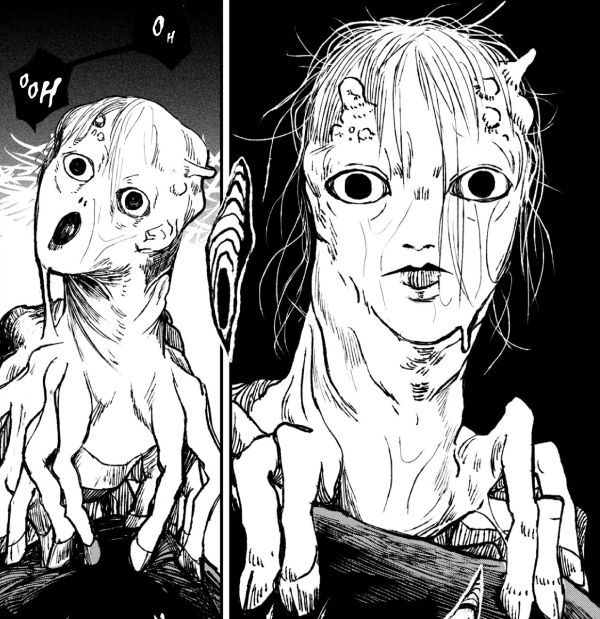
The art in this manga needs some getting used to. It’s sketchy, and the character design can look odd or exaggerated, especially in the case of Inubosaki’s cat-like, comical expressions. Where it truly shines is in terms of atmosphere and creature design. The monsters are grotesque, surreal, and genuinely nightmarish, with some of the best horror imagery in recent manga.
It’s still early in its run, but if you’re a fan of horror manga, urban legends, or unique art styles, Nikubami Honegishimi is a must-read title. Keep your eye on this one. It might very well become a modern horror classic.
Genres: Horror, Supernatural, Mystery
Status: Ongoing (Seinen)
19. Tokyo Ghoul
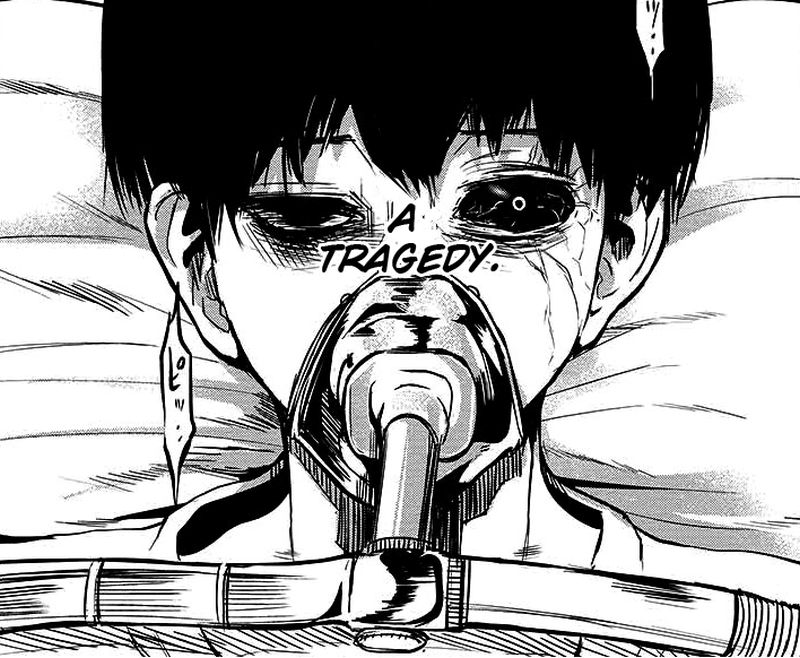
Tokyo Ghoul is one of the most iconic and widely read horror manga of the 2010s. Written and illustrated by Sui Ishida, it blends supernatural horror with action, tragedy, and urban fantasy in a unique and stylish way. At its peak, it delivers some of the most atmospheric and beautiful drawn scenes in modern manga.
The story follows Ken Kaneki, a bookish college student who is attacked by a ghoul, monsters that look human but must feed on human flesh to survive. After an emergency organ transplant, Kaneki becomes half-ghoul himself. Unable to eat normal food and teetering between two worlds, he takes refuge at Anteiku, a cafe that secretly shelters ghouls. What begins as a tale of survival soon spirals into something much bigger, involving secret organizations, ghoul investigators, and devastating battles.
Tokyo Ghoul’s early chapters are where the horror truly shines. We witness the terror of bodily transformation, the eerie coexistence of ghouls among humans, and the existential dread of losing one’s identity.
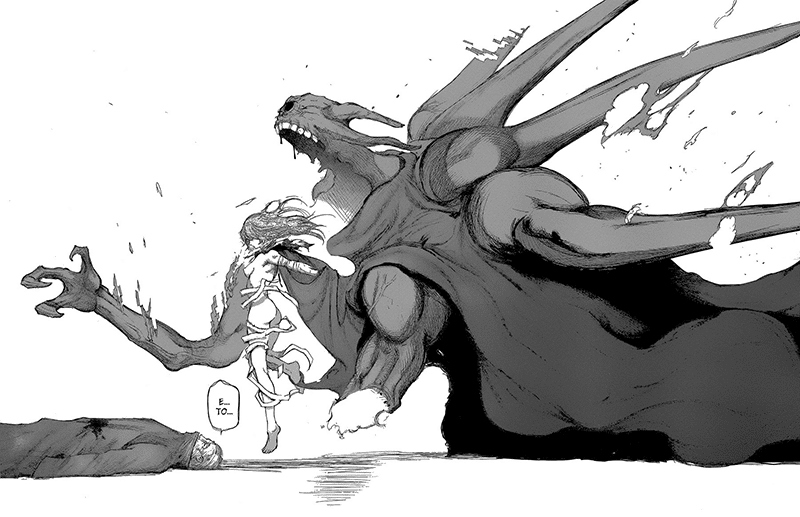
The art is a major standout. Ishida’s use of inky shadows, abstract layouts, and detailed character designs gives Tokyo Ghoul a moody, distinctive look. His designs for kagune, ghoul weapons, are especially striking. However, action scenes can become chaotic or hard to follow, particularly in later parts of :re.
As for characters, reactions vary. Kaneki’s transformation from meek student to tragic antihero is divisive. Some see it as a compelling arc of trauma, others as overly edgy. The supporting cast is robust all around, with fan-favorites like Amon, Arima, and Urie, adding depth and drama.
Despite its flaws, Tokyo Ghoul remains a must-read. It’s dark, ambitious and often breathtaking, especially if you’re drawn to horror manga with emotional weight, heavy themes, and stylish carnage.
Genres: Horror, Action, Mystery, Tragedy
Status: Finished (Seinen)
18. Yuuan no Kanata
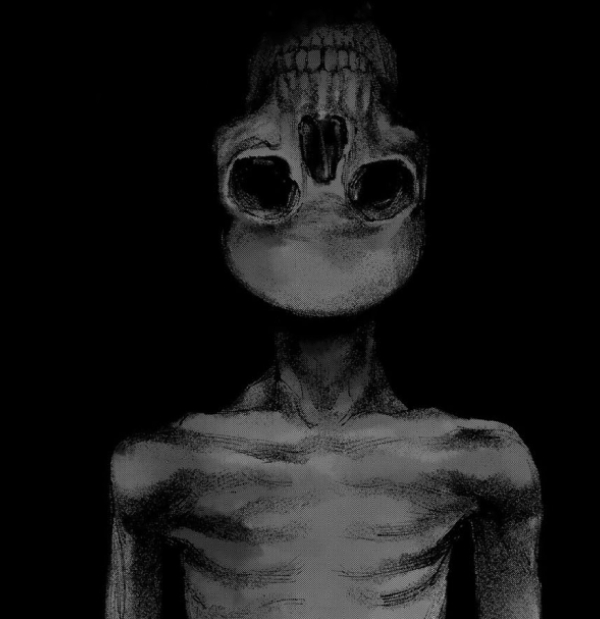
Yuuan no Kanata is one of the most promising new horror manga in recent years. Serialized in 2023, it follows Kanata, a woman who, after a traumatic experience, completely lost her ability to feel fear. To fill this void, she chases the supernatural, searching for the one moment that might finally terrify her again.
The manga unfolds in an episodic structure, presenting us with a variety of paranormal encounters. While Kanata serves as the series anchor, several chapters shift to other characters, include a ghost-seeing live-streamer, a skeptical journalist, or a mourning father. These characters all eventually cross paths with Kanata, adding layers of perspective to the overarching narrative.
What sets Yuuan no Kanata apart is its phenomenal art. The ghosts and supernatural entities are rendered in stark black ink and layered textures, creating a nightmarish contrast to the otherwise realistic setting. The way these beings emerge from the shadows is genuinely unsettling, often evoking a visceral jolt of dread.
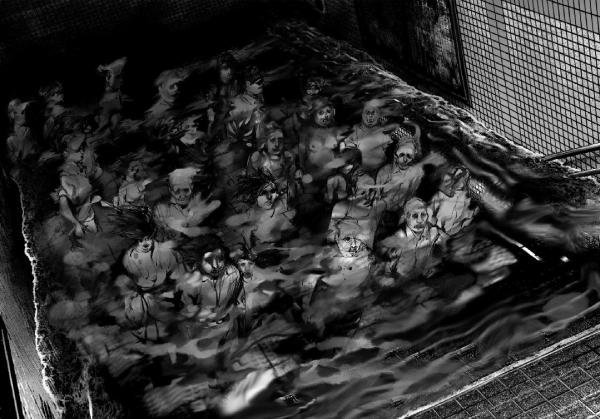
Despite its shifting perspective, the manga remains cohesive. The stories are self-contained but thematically connected, exploring how people rationalize or fall apart when confronted with the unexplainable. Kanata, though enigmatic, is a compelling protagonist, and a rare glimpse into her past suggests a deeper story yet to unfold.
If you’re looking for true, atmospheric horror that isn’t just about gore or violence, Yuuan no Kanata is a must-read. It’s beautifully drawn, and filled with quiet, creeping terror. With its strong debut and haunting visual style, it might just become the next standout in modern horror manga.
Genres: Horror, Supernatural, Mystery
Status: Ongoing (Seinen)
17. 6000
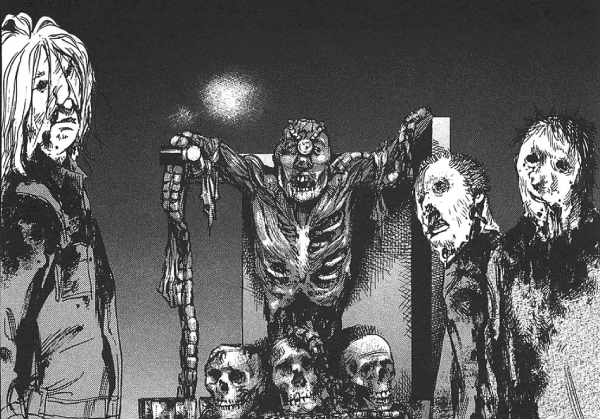
6000 is a claustrophobic, visually arresting descent into deep-sea terror, and one of the rare manga to fully embrace cosmic horror. Set aboard a derelict research facility 6000 meters beneath the ocean’s surface, it tells the story of a crew sent to investigate a series of unexplained accidents. As they descend into the depths, reality begins to fray, hallucinations become commonplace, and it becomes clear something sinister is at work.
What immediately stands out is the atmosphere. The art is rough, scratchy and drenched in black ink, amplifying the manga’s oppressive mood. While earlier chapters can drag a little, every location, hallway, and shadow feels slightly off. When the horror finally hits, it’s nothing short of disturbing. We bear witness to sinister rituals, bloated corpses and Lovecraftian entities.
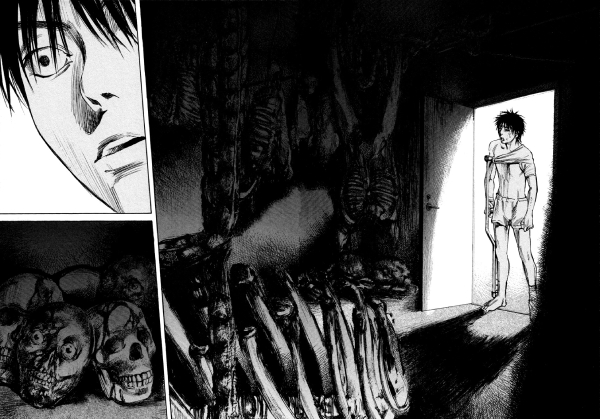
6000 relies heavily on visual storytelling. The sprawling undersea station is difficult to parse and feels disorienting. Panel transitions become cryptic, events blend together, and perspectives shift without warning. Many of the story’s key events are presented almost entirely through visuals, making it a more than challenging read. Yet this all adds to the surreal, dread-soaked tone that mirrors the character’s psychological breakdown.
6000 may not be for everyone. Its characters are thin, and the plot is convoluted. As a horror experience, however, it shines by how unnerving, grim and terrifying it is. As a fan of cosmic horror and the works of H. P. Lovecraft, this manga’s one of my absolute favorites. If you haven’t heard about it before, definitely check it out. It’s one of the most unique, yet underrated horror manga on this list.
Genres: Horror, Psychological, Survival, Cosmic Horror
Status: Finished (Seinen)
16. At the Mountains of Madness
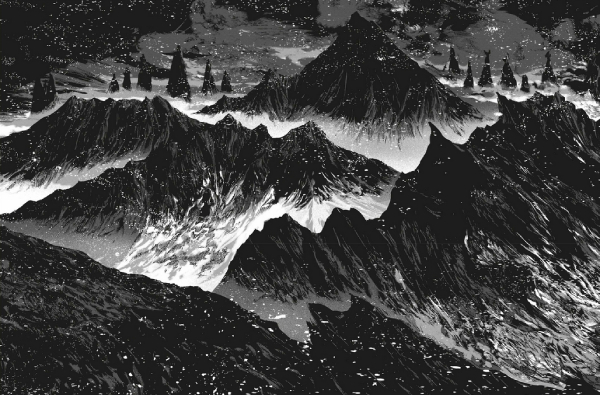
At the Mountains of Madness is arguably H. P. Lovecraft’s most iconic work, and this manga adaption by Gou Tanabe captures its overwhelming dread with chilling precision.
The tale follows an ill-fated Antarctic expedition led by Dr. William Dyer of Miskatonic University, who hopes that by recounting his team’s discoveries in the frozen wastes, he can prevent future expeditions from repeating the same mistake.
As the explorers venture deeper into the ancient ice, they uncover remnants of a pre-human civilization and cryptic fossilized remains. Yet they soon realize the ruins are not as dead as they seem. What begins as a scientific mission unravels into a journey through cosmic horror, isolation, and existential insignificance.

Gou Tanabe’s adaption is a masterclass in visual horror. His hyper-detailed line work, heavy shadows, and stark contrasts perfectly mirror the bleak tone of Lovecraft’s writing. Massive panels showcase impossible architecture and desolate Antarctic vistas, evoking both awe and unease. When the horror of Lovecraft’s monstrosities is finally revealed, the payoff is grotesque and majestic.
Few creators have managed to translate Lovecraft’s unique brand of cosmic dread to visual media as successful as Tanabe. His work is meticulously paced and atmospheric without sacrificing narrative clarity. At the Mountains of Madness is not just a retelling; it’s a tribute that fully understands the scale, fear, and awe of the original.
Whether you are a fan of H. P. Lovecraft or eerie, slow-burn horror manga, this adaption is a must-read. Gou Tanabe’s Lovecraft adaptions are amongst the finest horror manga ever created, and At the Mountains of Madness might be his crowning achievement.
Genres: Horror, Mystery, Sci-Fi, Supernatural, Cosmic Horror
Status: Finished (Seinen)
15. BIBLIOMANIA
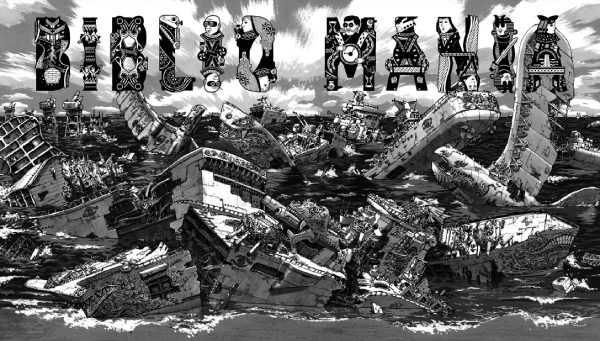
BIBLIOMANIA is a mesmerizing descent into madness, one of the most visually stunning horror manga ever published, and a must-read for fans of grotesque body horror and surreal storytelling.
The story follows Alice, a young girl who wakes up in Room 431 of a strange, decaying manor. A talking serpent warns her not to leave, or her body will rot. Naturally, she ignores the warning, beginning a fever-dream-like journey through a mansion filled with bizarre locations, horrifying beings, and increasingly disturbing transformations. With each new room, Alice’s form contorts further, her humanity slowly slipping away.
Written by Oobaru and illustrated by Macchiro, BIBLIOMANIA is as much a showcasing of visual horror mastery as it is a story. Macchiro’s art is astonishing. Every panel is intricately detailed, with a level of craftsmanship that turns even the most grotesque imagery into something eerily beautiful.
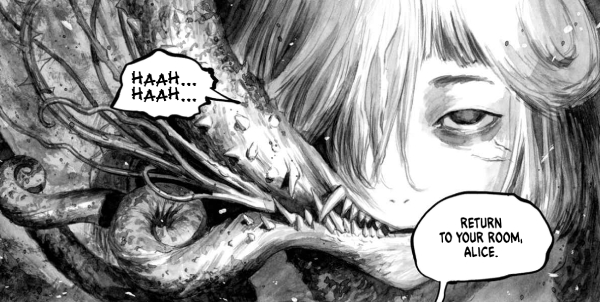
Alice’s childlike and whimsical design, stands in jarring contrast to the nightmarish environments and body horror that surrounds her. This contrast only amplifies the manga’s surreal, dreamlike atmosphere.
While loosely inspired by Alice in Wonderland, BIBLIOMANIA carves its own identity. It’s not just a story, but a layered descent into madness. Words can’t even do it justice, and it has to be experienced to be believed.
At under 100 pages, BIBLIOMANIA is short, but unforgettable. Its beauty is haunting, and its horror deeply unsettling. If you’re looking for something truly unique, that blends elegance, body horror and surrealism, BIBLIOMANIA is a must-read.
Genres: Horror, Fantasy, Drama, Psychological
Status: Finished (Seinen)
14. Blood on the Tracks
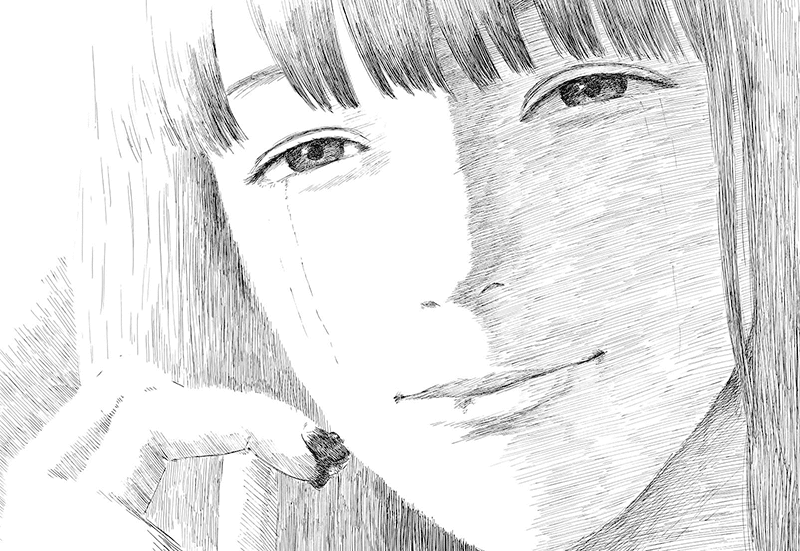
Blood on the Tracks is a masterclass in psychological horror, and one of the most haunting horror manga of the past decade. Written and illustrated by Shūzō Oshimi, the series tells the story of Seiichi Osabe, a quiet middle schooler with a loving family and overprotective mother. What begins as an uncomfortable display of smothering affection spirals into a chilling narrative of manipulation, trauma, and emotional decay.
A single horrific incident early in the story changes everything. From that point on, Blood on the Tracks becomes a slow, suffocating descent into psychological control. Oshimi leans into long silences, an oppressive atmosphere, and subtle facial expressions to build dread. Entire chapters revolve around a glance, a forced smile, or a single uttered sentence, each loaded with unbearable tension.
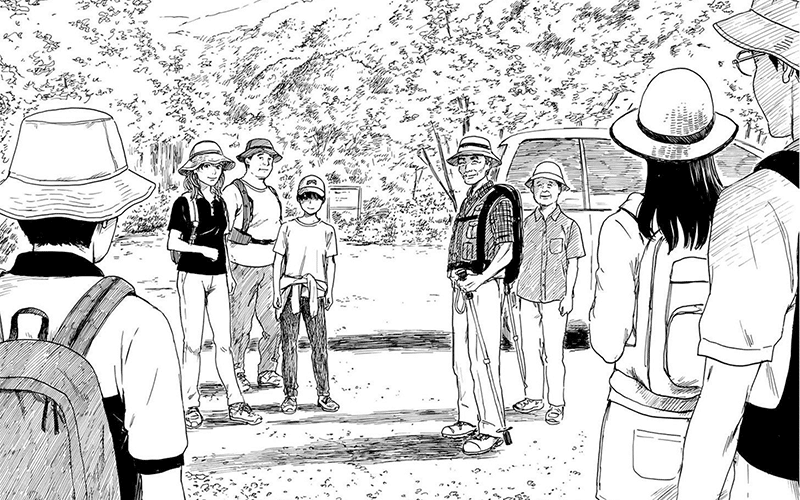
The manga’s slow pace is both its greatest strength and biggest flaw. In the early and middle arcs, this style amplifies the suspense to an almost unbearable level. But as the series nears its conclusion, the pacing feels overdrawn, and the manga loses much of its earlier intensity. The ending itself feels abrupt, but also oddly fitting.
What truly sets Blood on the Tracks apart is the art. Oshimi’s use of close-ups and blank spaces captures fear, hesitation and anguish like few others can. The subtle horror of watching a young boy’s will slowly, methodically erased is more disturbing than any gore.
If you’re looking for a slow, quiet, and deeply unsettling horror manga, Blood on the Tracks is a must-read.
Genres: Horror, Psychological, Tragedy, Philosophical, Slice of Life
Status: Finished (Seinen)
13. Gannibal
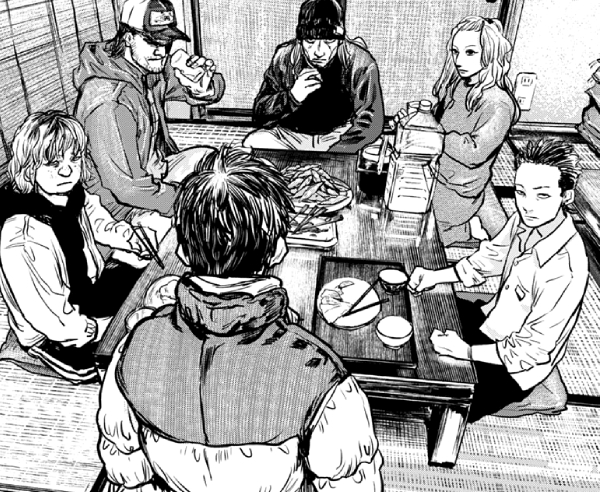
Gannibal is one of the most underrated modern horror manga. It’s a tense, slow-burning thriller set in a remote village where cannibalism is more than just a rumor. Written and illustrated by Masaaki Ninomiya, the series blends rural paranoia with psychological dread, delivering one of the most gripping genre entries in recent memory.
The story follows Daigo Agawa, a police officer reassigned to a quiet countryside village with his wife and daughter. But something feels off. His predecessor mysteriously vanished, the locals are strangely evasive, and then there’s the Goto family which is feared by everyone. When a horribly disfigured corpse turns up, Daigo suspects the impossible: the village may hide a legacy of cannibalism.
From the start, Gannibal exudes tension. There’s a suffocating sense of isolation, where every friendly smile could mask a lie. The village itself feels like a character. Ninomiya’s art captures all of this with remarkable skill.
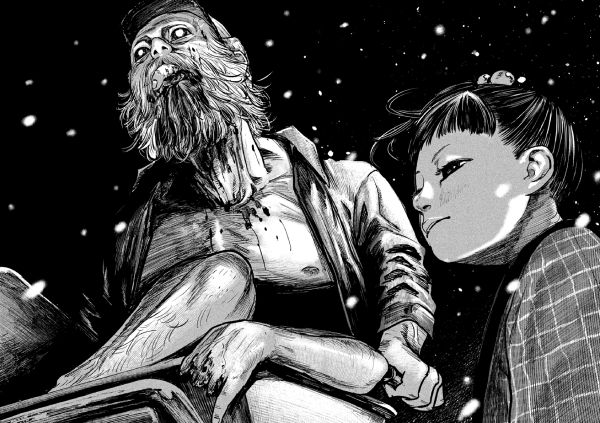
Characters are expressive, backgrounds are detailed and when the horror hits, it’s genuinely shocking. The gruesome moments are grisly without being overdone, often hitting harder because of how grounded they feel.
The cast is another standout. Daigo is a multi-layered protagonist, carrying emotional baggage of his own. The Goto family is a masterclass in horror writing, especially characters like Keisuke. They are a menace, yes, but few of them feel cartoonishly evil.
What sets Gannibal apart from other titles is its realism. The horror doesn’t come from ghosts or monsters, but from the disturbing idea that ancient rituals and terrible secrets still linger.
Gannibal is essential reading for every horror manga fan. It’s smart, suspenseful, and terrifying in all the right ways.
Genres: Horror, Mystery, Psychological, Crime
Status: Finished (Seinen)
12. Ichi the Killer
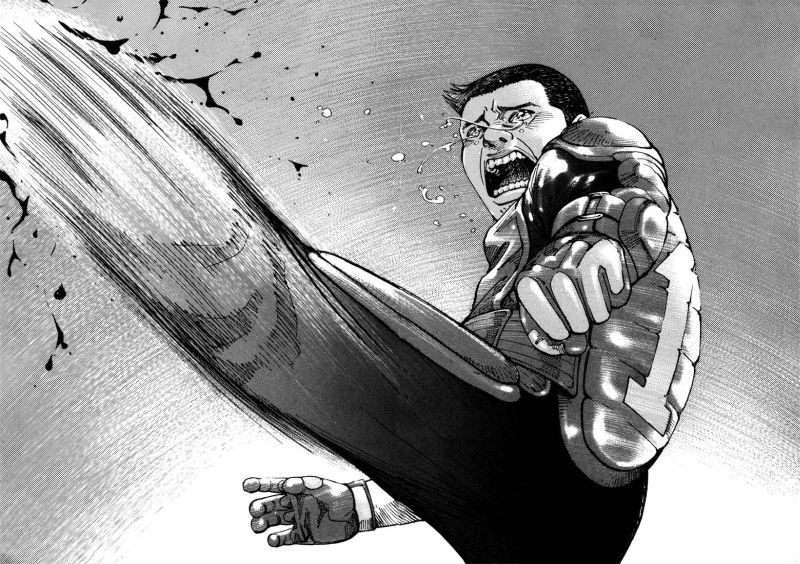
Ichi the Killer is one of the most depraved and disturbing manga ever published, but that’s precisely why it earns a place on this list. Created by Hideo Yamamoto, it blends graphic violence with psychological depth in a way few manga dare to attempt.
At its core, Ichi the Killer is a psychological thriller masquerading as an ultraviolent yakuza bloodbath. It follows two opposing characters: Ichi, a manipulated, broken killer, and Kakihara, a sadomasochistic yakuza, searching for his missing boss. As Kakihara hunts Ichi, what unfolds is less a crime story and more a plunge into the minds of two deeply twisted individuals.
What makes Ichi the Killer work is its total lack of filter. Yamamoto hides nothing, forcing the reader to confront the darkest underbelly of society. The manga explores sadism, masochism, identity breakdown, sexual trauma, abuse, and psychological manipulation. Every character is deranged in their own way, yet disturbingly believable.
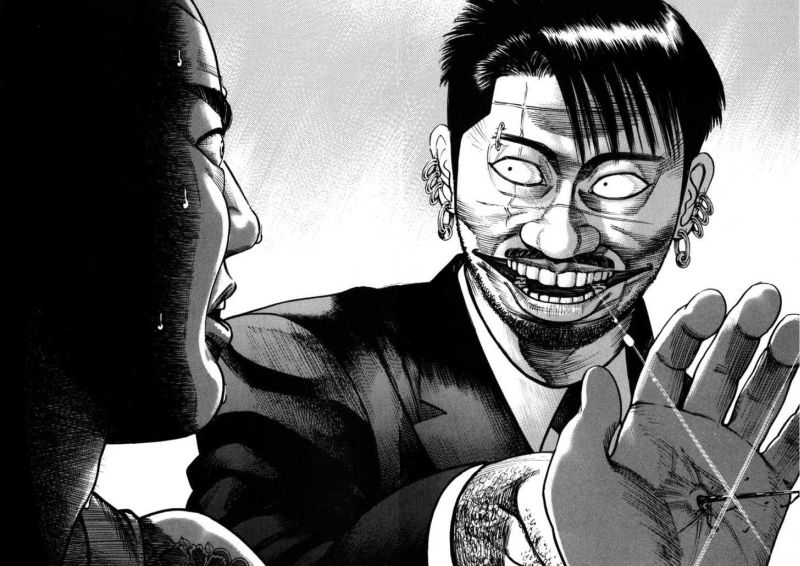
The violence is extreme, even excessive, but always tied to character and theme. It’s not mindless gore, but a mirror showcasing pain, vulnerability and human depravity. Ichi himself is especially tragic. He’s nothing but a weeping, terrified young man manipulated into acts of brutal savagery.
The art is unpolished and raw, but that fits the tone. Exaggerated expressions and detailed violence reflect the manga’s emotional volatility. Yamamoto’s style might not be beautiful, but it’s brutally effective.
If you can stomach its content, Ichi the Killer is a disturbing masterpiece. It’s extreme, but also layered, provocative, and one of the most fearless psychological horror manga ever drawn.
Genres: Crime, Psychological, Gore
Status: Finished (Seinen)
11. Fuan no Tane
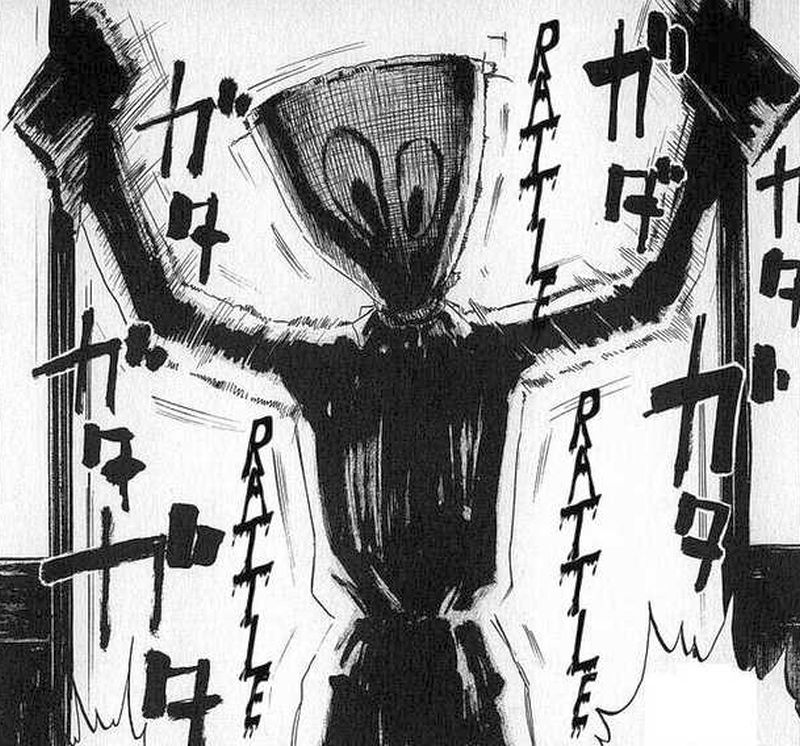
Fuan no Tane is one of the most effective and unsettling horror manga ever created, and it achieves this without a plot, characters, or even dialogue in many cases. Written by Masaaki Nakayama, this minimalist masterpiece focuses purely on fear, functioning as a collection of micro-horror stories based on urban legends, ghost sightings, and local superstitions.
Each entry is just a few pages long, usually centered on a theme such as ‘school’ or ‘home visits.’ There’s no buildup, no explanation, just a sudden jarring encounter with something supernatural. Most stories end abruptly, often right at the moment of the horror, leaving you unsettled and curious.
What makes Fuan no Tane work is its laser focus on atmosphere and timing. The manga strips horror down to the essentials: a creepy presence, a dark hallway, a glimpse through a window, and lets your imagination do the rest.
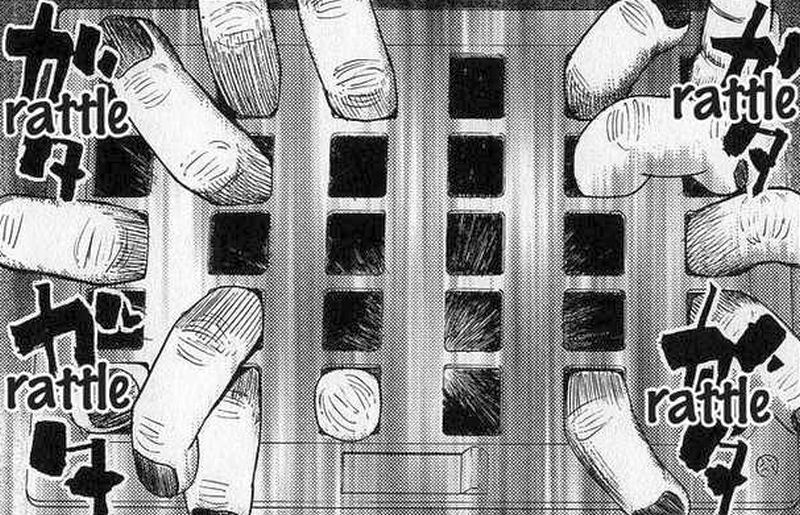
Nakayama’s style appears relatively grounded at first, but when the horror hits, it hits hard. The distorted faces, dead eyes, and monstrous apparitions are genuinely terrifying, with fantastic use of contrast and paneling to heighten the unease.
Some entries lean more toward dark comedy or weirdness, but most are straightforward scare pieces. It’s a perfect pick for fans of J-horror or bite-sized terror.
For those who want more, there are two follow-up series: Fuan no Tane+ and Fuan no Tane*.
If you’re looking for pure, distilled fear in manga form, Fuan no Tane is a must-read.
Genres: Horror, Supernatural, Psychological (Shonen)
Status: Finished (Shonen)
10. Chainsaw Man
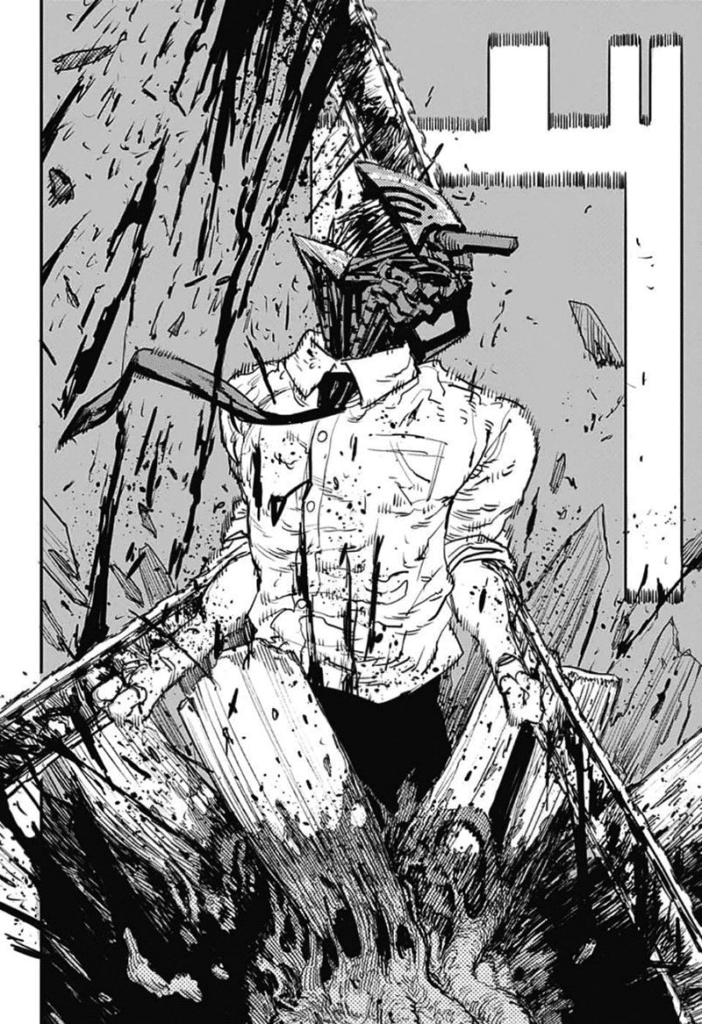
Cainsaw Man is pure, beautiful madness. A chaotic blend of ultraviolence, absurd humor, and supernatural horror, it stands as one of the most original shonen manga of the past decade. It’s a mast-read for any horror manga fan open to something unconventional.
The story follows Denji, a young man at the end of his luck who merges with his pet devil Pochita and becomes Chainsaw Man, a grotesque creature with chainsaws bursting from his arms and head. After being recruited into the Public Safety Bureau, Denji fights devils alongside a cast of increasingly unstable allies.
While technically a supernatural action shonen, Chainsaw Man absolutely belongs on a horror list. From the grotesque devil design to the graphic violence and existential dread, Tatsuki Fujimoto leans hard into territory few shonen dare to touch. The devils themselves are nightmarish, with appearances and abilities based on humanity’s primal fears.
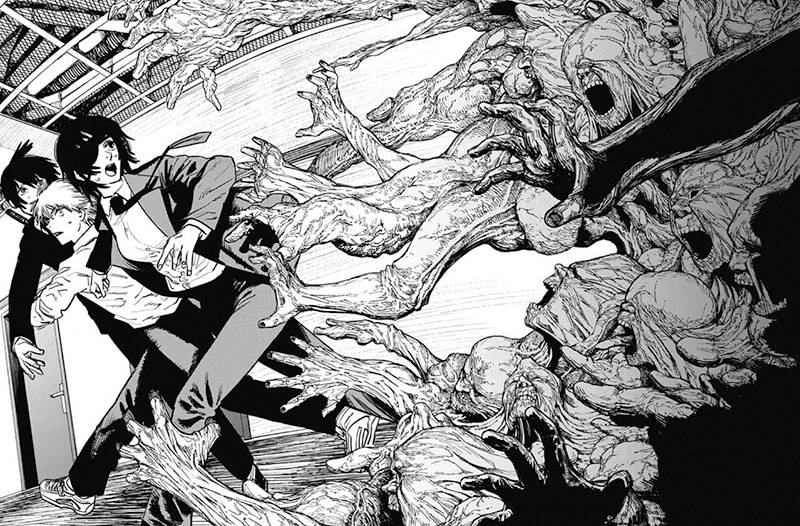
The manga’s brilliance lies in its tone. It oscillates between absurdity and tragedy with alarming ease. One chapter might be pure comedy, and the next a brutal, nihilistic gut-punch. Denji, initially an idiotic pervert chasing cheap thrills, evolves into a surprisingly layered character. His allies, especially Power and Aki, all bring emotional depth and chaos to the table.
Fujimoto’s art style is raw, sketch, and emotionally charged. It’s messy in the best way, packed with energy, violence, and dreamlike imagery. When the fights get going, they are frantic, gory and often emotionally devastating.
Chainsaw Man is not a traditional horror manga, but its grotesque violence, eerie devils, and soul-crushing story easily place it amongst the genre’s most impactful new entries. It’s funny, terrifying, and unlike anything else out there.
Genres: Horror, Supernatural, Action, Comedy
Status: Ongoing (Shonen)
9. PTSD Radio
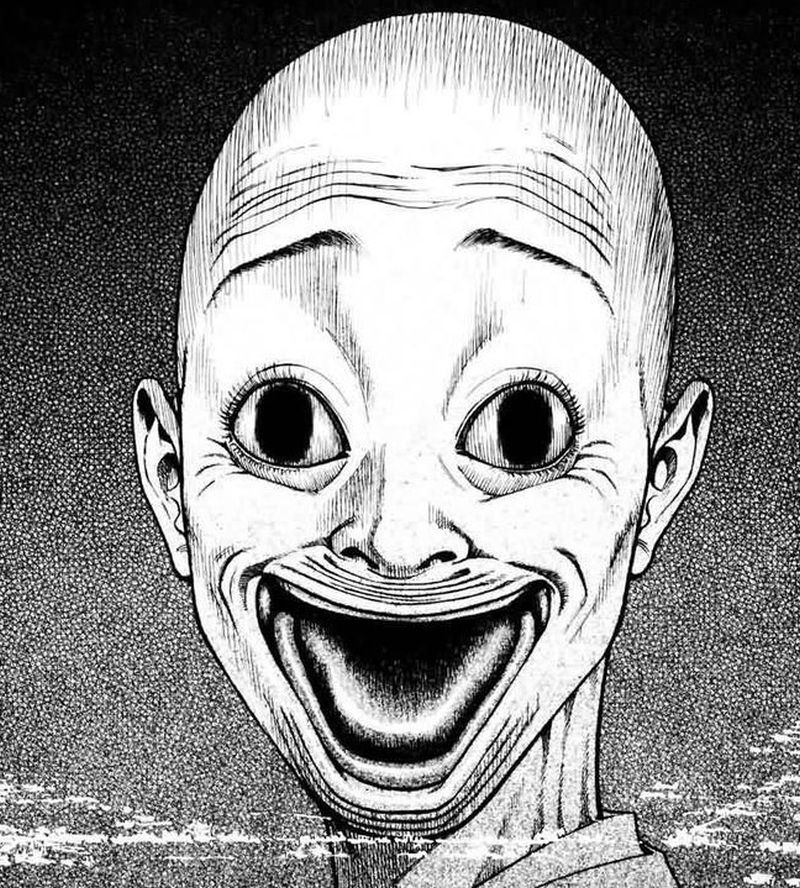
PTSD Radio is a spiritual successor to Fuan no Tane, once again written and illustrated by Masaaki Nakayama. At first glance, it appears to be another anthology of disconnected supernatural shorts, but slowly, a pattern emerges. These disturbing glimpses into urban life are all tied together by one recurring element: hair.
Whether it’s ghosts made of hair, people tormented by the fear of losing it, or haunted by invisible strands, the theme builds until we’re introduced to a terrifying presence known only as the God of Hair, a mysterious entity that looms over the entire series. It’s never fully explained, but its influence is unmistakable, giving PTSD Radio a loose yet satisfying overarching narrative.
Like Fuan no Tane, most chapters are extremely short, some only a page or two long. Nakayama wastes no time on setup or character development, instead dropping the reader straight into each chilling encounter.
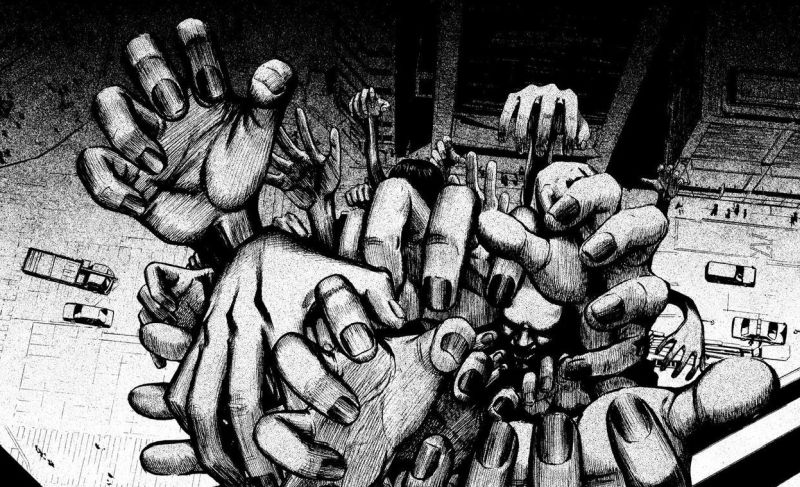
Unlike its predecessor, PTSD Radio builds real momentum. The slow realization that everything is connected gives it a creeping sense of dread that only intensifies the further you read.
The art is also a step up. Nakayama’s realistic style remains, but the horror imagery is more detailed, grotesque, and creatively staged. Panels drip with unease, and his monstrous creations, especially the hair obsessed spirits, are the stuff of nightmares.
Short, sharp and utterly unsettling, PTSD Radio is one of the best horror manga for fans of episodic creepiness that builds into something far greater. It’s an easy recommendation for fans of Fuan no Tane, but outshines its predecessor in every way.
Genres: Horror, Supernatural, Mystery
Status: On Hiatus (Seinen)
8. Me and the Devil Blues
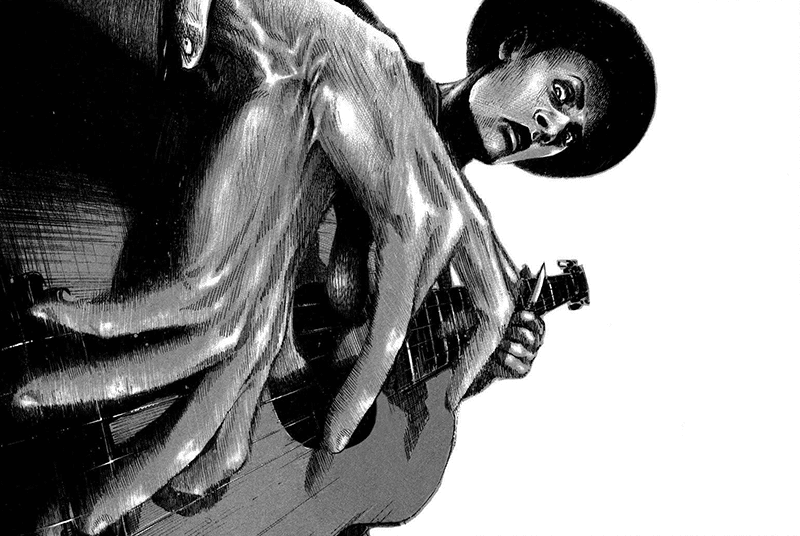
How could a retelling of the life of Robert Johnson set in the American South ever work in a manga? Surprisingly, absolutely fantastic.
Me and the Devil Blues is a dark supernatural historical thriller that combines blues mythology, psychological tension, and horror overtones. Written and illustrated by Akira Hiramoto, it’s one of the most original and gripping manga ever created.
The story follows Robert Johnson (RJ), a struggling blues musician in the Jim Crow South. Desperate to play like the greats, he plays alone at a crossroads one night, summoning something that changes his life forever. From this point on, RJs fingers move like magic, and the story spirals into supernatural mystery, violence, and chaos.
While not a pure horror manga, the tension is suffocating. For entire chapters at a time, you’ll find yourself unable to breathe. It’s soaked in dread, paranoia, and a sense that things are always about to break.
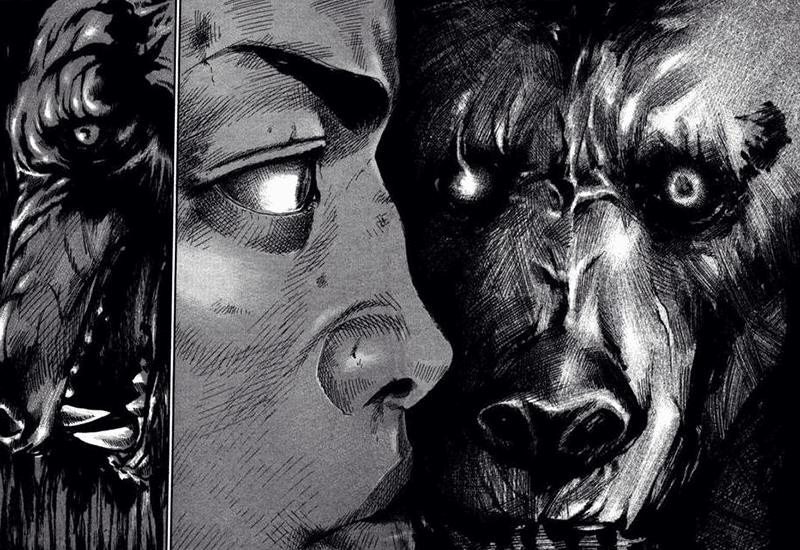
The setting is stunningly rendered. Hiramoto’s art is gritty, textured, and intensely detailed, perfectly capturing 1930s rural America. Racism, violence, and desperation hang over every panel. The atmosphere is so thick you can almost hear the music and feel the sweat of the juke joints.
Characters are another standout. RJ is a tragic, passive figure caught in a whirlwind of fate. Real-life figures like Clyde Barrow make an appearance, adding historical weight. Side characters like the ominous Stanley McDonald are written with just as much care and intensity.
Me and the Devil Blues is a hidden gem. It’s an American gothic nightmare told through the lens of Japanese manga. It’s surreal, suspenseful and one of the greatest manga of all time, horror or otherwise.
Genres: Horror, Historical, Psychological, Mystery, Drama
Status: On Hiatus (Seinen)
7. Dorohedoro
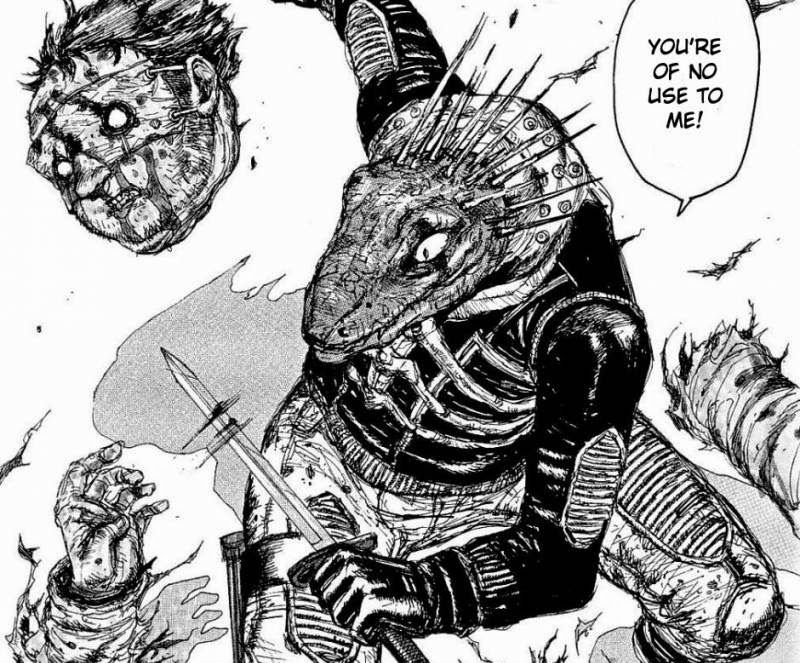
Dorohedoro is one of the strangest and most unforgettable manga ever created. Technically, a dark fantasy action series, it earns its spot on this horror manga list through sheer brutality, grotesque visuals, and surreal tones. It’s part body horror, part comedy, part violent mystery, and somehow it all works.
The story takes place in Hole, a grim, lawless city used by sorcerers from another world to test their magic on helpless citizens. Enter Kaiman, an amnesiac with a reptile head and immunity to magic, who hunts sorcerers in search of his true identity. Alongside his companion Nikaidou, he cuts his way through the magical underworld, drawing closer to secrets stranger than he could imagine.
As the story unfolds, layers of mystery and interconnected fate emerge, culminating in a surreal, violent epic that is downright bizarre.
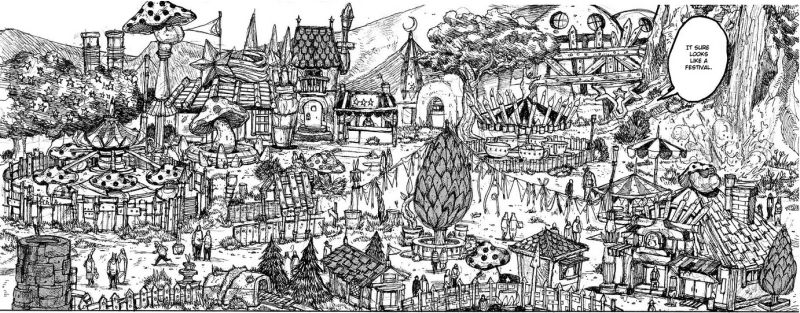
Despite its violence and disfigurements, Dorohedoro is often hilarious. The humor is absurd, the tone chaotic, and the characters, from mushroom loving villains to giant cockroach man, are just as likely to make you laugh as they are to horrify you. And yet, the manga features copious amounts of gore, showing everything from human experiments to visceral decapitations in graphic detail.
What makes Dorohedoro truly shine is Q Hayashida’s art. It’s gritty, dense, and wildly imaginative. Whether it’s the rundown streets of Hole or the surreal Sorcerer’s World, every panel bursts with personality and texture.
If you can handle its chaos, Dorohedoro is a masterpiece of weird fiction. It’s brutal, hilarious, grotesque and unlike anything else in manga.
Genres: Horror, Fantasy, Supernatural, Mystery, Slice of Life
Status: Finished (Seinen)
6. Homunculus
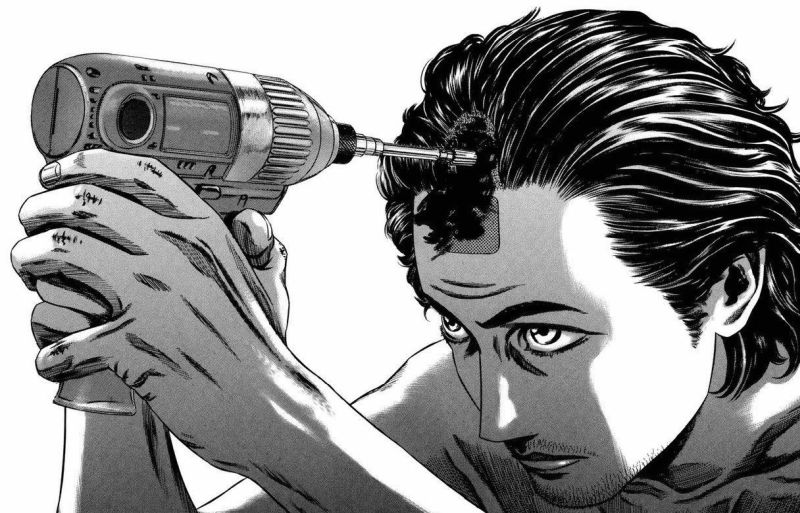
Homunculus isn’t a horror manga in the traditional sense, but it’s deeply disturbing, psychologically unhinged, and impossible to forget. Written by Hideo Yamamoto, it’s a surreal, cerebral dive into trauma, perception, and identity.
The story follows Susumu Nakoshi, a homeless man living in his car, who agrees to let a young medical student perform trepanation on him, a procedure that involves drilling a hole into the skull. Afterward, Nakoshi sees warped, grotesque versions of people through his left eye: homunculi, symbolic manifestations of their inner trauma.
What begins as a strange experiment quickly becomes a descent into madness. Homunculus evolves into a character study wrapped in psychological horror, exploring themes like vanity, identity disorder, and the grotesque nature of the human psyche.
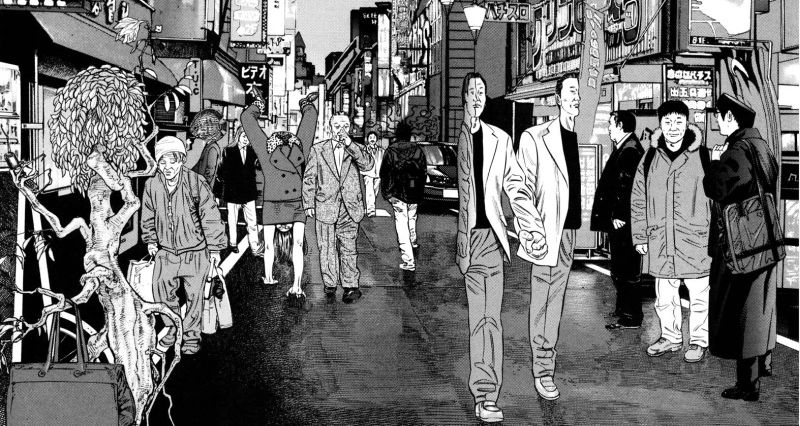
The disturbing content here isn’t just visual, though there are intense scenes of sexual violence and grotesque body imagery. The real horror lies in the uncomfortable psychological territory the manga explores. Nakoshi’s increasingly erratic behavior and the bizarre truths he uncovers create a suffocating, surreal atmosphere that’s hard to shake.
Yamamoto’s artwork is both grounded and horrifying. The homunculi are rendered in shocking, abstract ways. We see twisted bodies, strange fusions and melting features, turning trauma into visual metaphor. The realism of the art makes the weirdness hit even harder.
While the story is gripping, it eventually spirals into full-blown surrealism. The final chapters become increasingly ambiguous, culminating in a controversial ending that leaves more questions than answers.
Still, for its bold vision and psychological depth, Homunculus earns its place on this list. It’s unsettling, original, and a masterpiece of psychological storytelling, perfect for readers looking for horror rooted not in monsters, but the darkest corners of the human mind.
Genres: Horror, Psychological, Philosophical, Drama
Status: Finished (Seinen)
5. Kamisama no Iutoori and Kamisama no Iutoori Ni
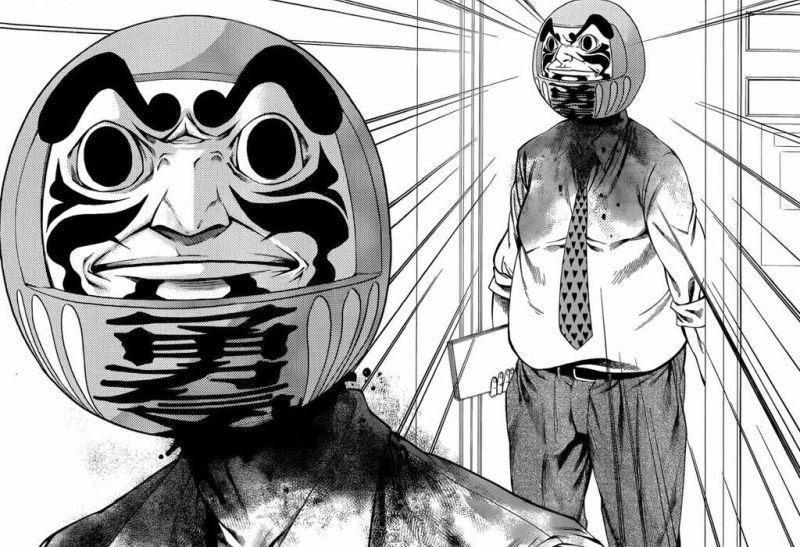
The death game subgenre is one of my favorites in manga, and Kamisama no Iutoori and its sequel are as good as it gets. Written by Muneyuki Kaneshiro, this brutal survival horror manga blends sadistic games, unhinged characters, and escalating chaos into one of the wildest rides in modern manga.
The first part begins with high schooler Shun Takahata, who witnesses his teacher’s head explode before being forced into a deadly game of ‘Daruma-san ga Koronda.’ From there, things only get weirder. The sequel picks up with a new cast before tying back to Shun’s story, raising the stakes in every possible way.
What sets this series apart, aside from its violent creativity, is its cast. While most death games rely on tropes when it comes to characters, Kamisama no Iutoori gives us completely unhinged characters like the genius sociopath Amaya and the fan-favorite Ushimitsu, who transforms from a deranged wildcard into one of the story’s most developed and compelling characters.
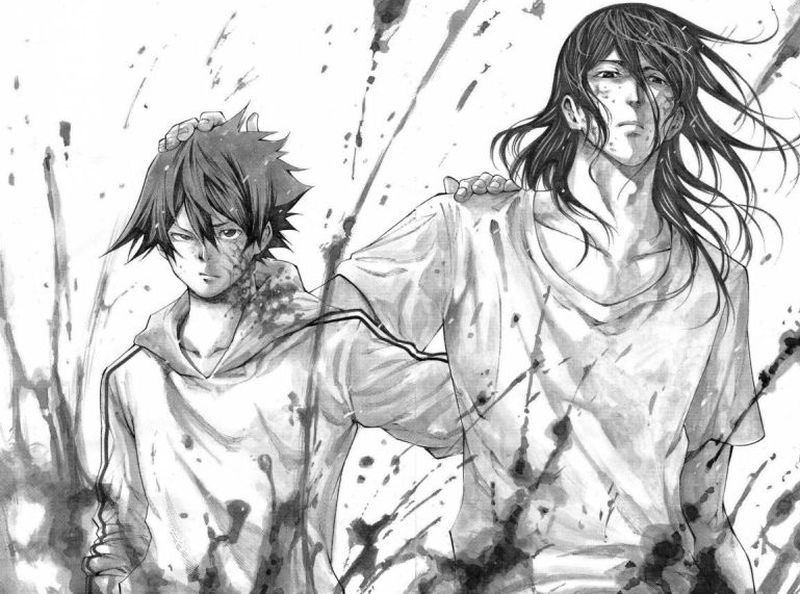
The games themselves are surreal and cruel. They are twisted versions of childhood activities with fatal consequences. There’s always a hidden rule or solution, which gives the manga a puzzle-box structure that keeps you turning pages. Unlike more grounded series, this one revels in absurdity and it works.
The art, while decent in Part 1, improves dramatically in Part 2, with Akeji Fujimura delivering detailed spreads and some of the most stylish sequences in the genre. Certain chapters, especially toward the climax, are a visual masterclass in suspense.
While the ending remains divisive, Kamisama no Iutoori is an unforgettable experience. It’s gory, tense, and absolutely deranged, but in all the right ways.
Genres: Horror, Action, Survival, Psychological, Comedy
Status: Finished (Shonen)
4. Gantz
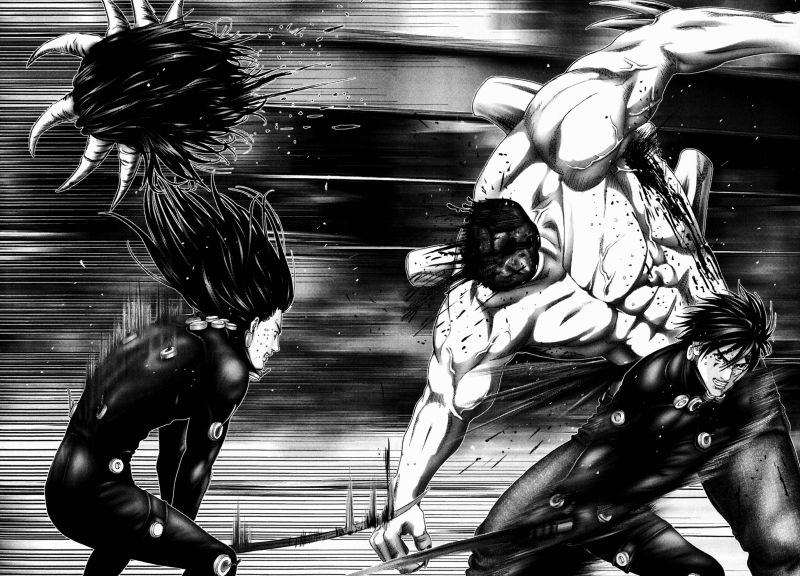
Gantz by Oku Hiroya is beautiful madness. It’s an ultraviolent blend of horror, sci-fi and action that pushes every boundary it can find. While not a traditional horror manga, its grotesque alien design, disturbing themes, and high body count earn it a firm place on this list.
The story follows Kei Kurono, a selfish teenager who dies saving someone, only to wake up in a strange Tokyo apartment with a black sphere named Gantz. He and other recently deceased people are now forced into brutal missions, and tasked with hunting aliens disguised among humans. These missions are violent, chaotic, and fatal. Most newcomers don’t survive their fist.
As the series unfolds, Gantz introduces some of the most creatively bizarre creatures in manga. The carnage is jaw-dropping, and the art, especially during action sequences, is stunningly detailed and cinematic.
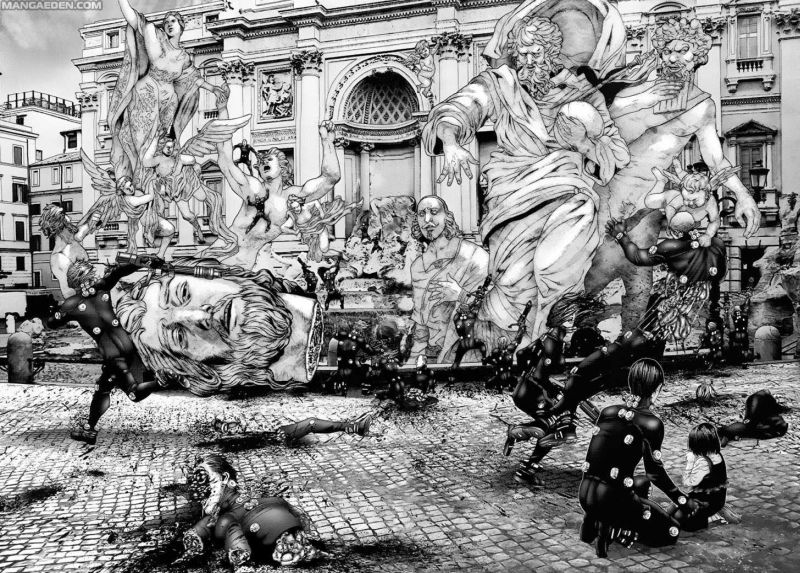
What truly sets Gantz apart, however, is its unrelenting darkness. Outside the missions, the world is no better. We witness bullying, assault, rape, and even a mass shooting. Gantz paints a bleak portrait of humanity, amplifying its horror far beyond the battlefield.
Despite its chaos, Gantz features standout character development. Kurono begins as a shallow, selfish teen, but slowly grows into a reluctant, powerful leader. Watching his arc unfold is one of the series’ greatest strengths.
Gantz’s story gets messy. Certain subplots, like the vampire conflict, are introduced, then dropped, and its final arc is rushed and confusing. Yet the raw intensity, unpredictable narrative, and visual brilliance make Gantz unforgettable.
Brutal, grotesque, and utterly unhinged, Gantz is horror-infused sci-fi action at its most unapologetic. It’s not for the faint of heart, but if you can stomach the madness, it delivers something few other horror manga do.
Genres: Horror, Action, Psychological, Sci-Fi, Alien
Status: Finished (Seinen)
3. Uzumaki
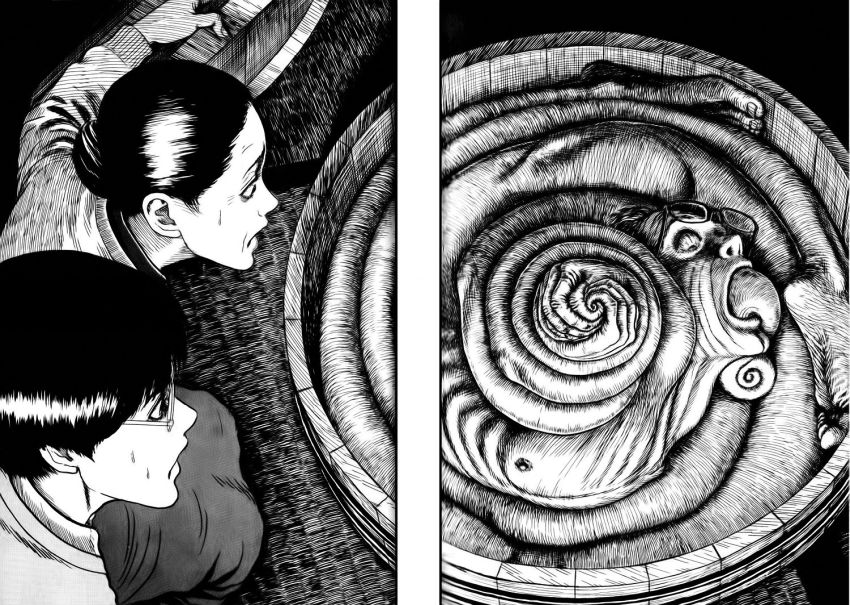
Uzumaki is Juni Ito’s most iconic work, and for good reasons. This three-volume decent into cosmic madness is a masterclass in surreal horror, and one of the most imaginative horror manga ever created.
For more of Ito’s best work, check out my complete list of the Best Junji Ito Stories.
The premise is simple but terrifying: the town of Kurouzu-cho is slowly consumed by spirals. Not just literal spirals, but the abstract concept itself. Whether it’s hair twisting unnaturally, or bodies contorting into grotesque coils, the spiral manifests in increasingly disturbing ways, and there’s no escaping it.
The story is mostly episodic, following high schooler Kirie Goshima and her boyfriend Shuuichi as they witness one horrifying incident after another. Each chapter brings a new self-contained spiral-shaped nightmare, with Ito pushing his grotesque creativity to the limit. The first two volumes shine in this format, building a cumulative sense of doom and madness.

Ito’s artwork is phenomenal. His clean black-and-white line work is deceptively simple, yet incredibly detailed when it comes to body horror. The visual transformations, from obsessed father to spiral-shaped snails, are disturbing in ways only Junji Ito could conceive. His exaggerated facial expressions and surreal imagery make each page unforgettable.
What makes Uzumaki so haunting is the lack of a clear antagonist. The spiral is not a creature or a villain, it’s a concept, a curse, an inevitability. The cosmic indifference gives it a Lovecraftian edge, especially in the final volume, when the scope of the horror becomes fully apparent.
While Kirie is a weak protagonist and the final volume stumbles slightly by trying to explain the horror, Uzumaki remains a landmark in horror manga. It’s bizarre, bleak, and brilliant. Uzumaki is a must read for anyone interested in horror manga.
Genres: Horror, Supernatural, Mystery, Cosmic Horror
Status: Finished (Seinen)
2. Blame!
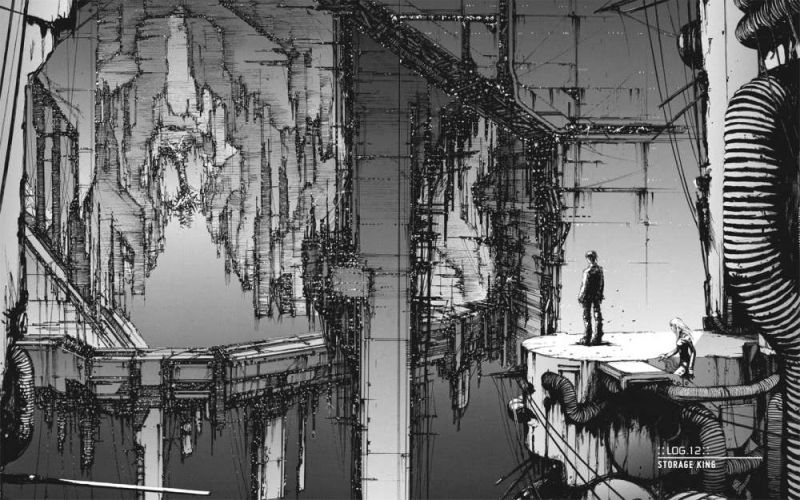
Blame! by Tsutomu Nihei is my favorite manga of all time, so I might be biased, but it’s also one of the most haunting and visually overwhelming works ever published. While Blame! is technically a cyberpunk sci-fi epic, its oppressive atmosphere, terrifying biomechanical monstrosities, and cosmic scale make it a perfect fit for horror manga fans.
The story follows Killy, a silent wanderer navigating a seemingly endless megastructure known only as The City. He’s on a cryptic quest to find a human with Net Terminal Genes, the only hope to regain control over the Netsphere, and stop the Safeguard, ruthless AI enforcers bent on exterminating humanity.
Yet Blame!’s plot takes a backseat to mood, world-building, and scale. Dialogue is minimal and story progression is fragmented. Blame! is a manga that relies almost entirely on visual storytelling, but that’s what makes it such a brilliant work.
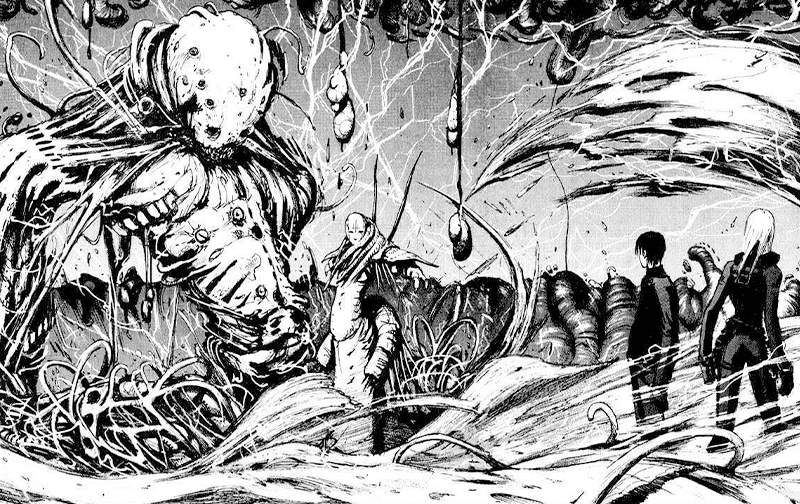
What defines Blame! is its vast, inhuman architecture and the cold, alien logic of the machines that roam it. Nihei’s artwork is jaw-dropping. Every panel bursts with towering techno-ruins, mechanical horrors, and bizarre cyborg lifeforms. Often, Killy is nothing but a tiny dot in a sprawling, abandoned hellscape of steel and silence.
The horror in Blame! isn’t just loud and gory, it’s existential. It’s the terror of insignificance in an uncaring world. Its faceless machines, collapsed civilizations and violent encounters with things far beyond comprehension.
Yes, the story may feel opaque, the battles chaotic, and the ending cryptic. But none of that diminishes the experience. If you’re drawn to bleak, atmospheric, and visually stunning works with strong horror undertones, I can’t recommend Blame! enough.
I’ve written a full essay on Blame! where I go into detail about its themes, architecture, and why it’s my favorite manga of all time.
Genres: Horror, Sci-Fi, Cyberpunk
Status: Finished (Seinen)
1. Berserk
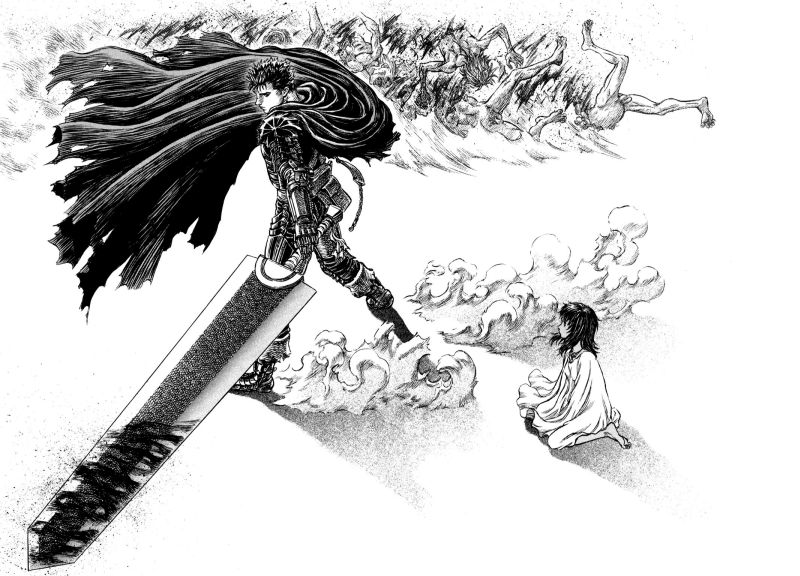
Berserk is one of the greatest manga ever created. A dark fantasy epic by the late Kentaro Miura, it blends grotesque horror, brutal violence, and mythic storytelling into something unforgettable. While technically not a horror manga, its disturbing imagery, overwhelming despair, and graphic violence earn it a firm place on this list.
The story follows Guts, the Black Swordsman, as he carves a path of revenge through a cursed world filled with monstrous Apostles and unimaginable cruelty. At the center of it all is his broken bond with Griffith, a once-heroic leader whose betrayal becomes one of the most horrifying moments in manga history.
What sets Berserk apart isn’t just the brutality, it’s the complexity. Guts and Griffith are two of the most iconic characters in the medium, their dynamic rich in symbolism, conflict and tragedy. The manga centers on such themes as fate, free will, trauma, and the monstrous nature of ambition.
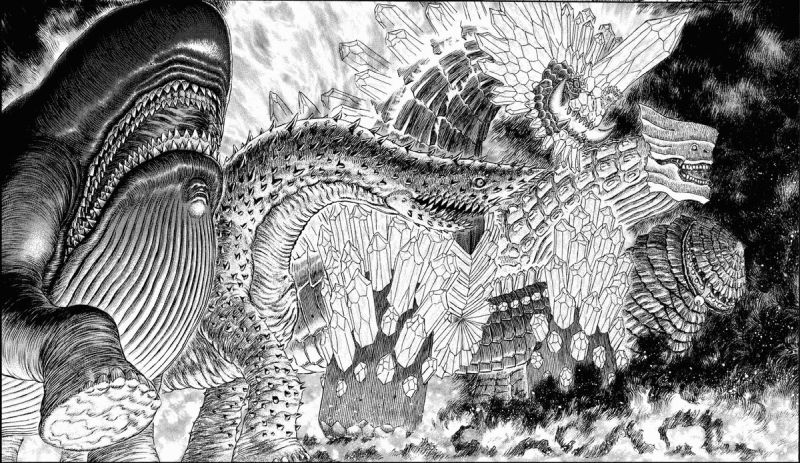
But above all, Berserk is a visual masterpiece. Miura’s artwork stands among the best in manga history. From sweeping battlefields to the monstrous body horror-inspired designs of the Apostles, every page is breathtaking. Some two-page spreads could be hung in a museum.
The Golden Age arc alone, culminating in one of the most devastating climaxes in manga, is reason enough to call Berserk a masterpiece.
Following Miura’s passing in 2021, the manga is now faithfully continued by his close friend Kouji Mori and Studio Gaga. There is still hope that the story will one day reach its intended conclusion.
Berserk is dark, uncompromising, and emotionally shattering. For fans of horror, fantasy, or just great manga, it’s required reading, and a worthy pick for the number one spot on this list.
Genres: Horror, Fantasy, Action, Tragedy, Psychological
Status: Ongoing (Seinen)
